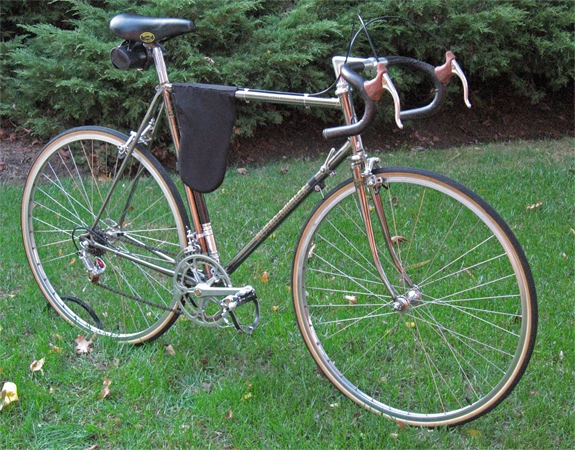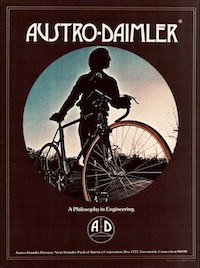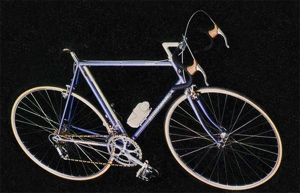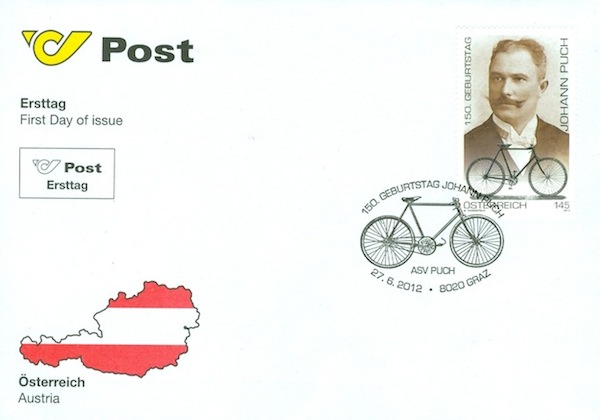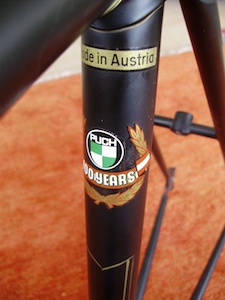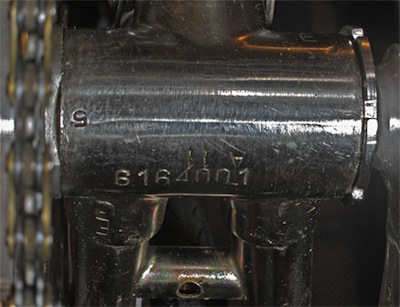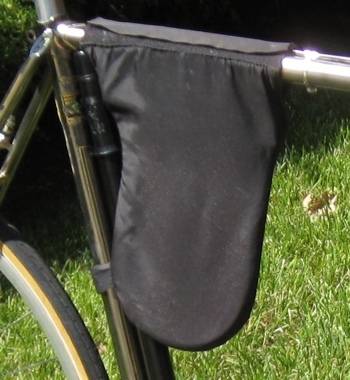My Austro-Daimler "Vent Noir II" Bicycle And Brief History of Steyr Daimler Puch (original) (raw)
Austro-Daimler: The Bicycle That The Owner Of A Bösendorfer Imperial Piano Would Ride
Above: Author's Austro-Daimler Vent Noir II 57cm frame bicycle S/N 6164001 photographed 28 Sept. 2007 (195,516 bytes).
Accessories that date the bike include: Silca Impero frame mounted pump, Rhode Gear Flickstand frame-mounted brace to park the
bike upright, a Lock Sock (attached to the Top Tube forward of the Saddle) storing an original Citadel bike lock within.
Click on image to see enlarged view (990,366 bytes PNG file).
The author is hosting an older, less complete version of this article 'somewhat' translated into German at http://www.company7.com/bosendorfer/ADbicycle_de.html.
Contents and Quick Links: click on the  to return to top of this article
to return to top of this article

 Who Were Austro-Daimler? When I bought my Vent Noir II in 1981 the Austro-Daimler Puch company was a wholly owned subsidiary of the famous Steyr-Daimler-Puch consortium. The company history began more than one hundred years before then, in a time and in a Europe that would be wholly alien to those of us brought up over the recent generations.
Who Were Austro-Daimler? When I bought my Vent Noir II in 1981 the Austro-Daimler Puch company was a wholly owned subsidiary of the famous Steyr-Daimler-Puch consortium. The company history began more than one hundred years before then, in a time and in a Europe that would be wholly alien to those of us brought up over the recent generations.
The nascent Austro-Daimler and Puch companies were formed in four cities; Wein, Graz, Steyr and Wiener-Neustadt in what the history books refer to as the Austro-Hungarian Empire of the 1890's. To be concise, the origin was some decades before then in 1855 when Josef Werndl (b. 26 February 1831, Steierdorf Austria d. 29 April 1889), a gunsmith, took over the established family manufacturing company then making components for small arms. He improved manufacturing techniques and diversified their offerings. With his brother Franz Werndl the “Josef und Franz Werndl & Comp. Waffenfabrik und Sägemühle in Oberletten” (Weapons Factory Arms and Sawmill) was formalized on 16 April 1864 in Steyr, Austria. They would continue the manufacturing but also develop the Werndl-rifle Model 1867, a new modern breech loading rifle system. Working with talented engineers including Ferdinand Mannlicher the company became the leading European producer of small arms. The company began producing bicycles in 1894, and “Steyr” brand automobiles in 1915. The company transitioned 1869 to “Österreichische Waffenfabriksgesellschaft” (OEWG, Austrian Arms-Manufacturing Company), then in 1924 it was changed as “Steyr-Werke AG".
Right: Joseph Werndl, founder of what would become best known as Steyr (11,191 bytes).
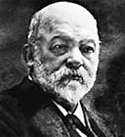 The second member of the triad was founded by Gottlieb Daimler (b. 17 March 1834 Schorndorf, Kingdom of Württemberg Germany, d. 6 March 1900) an engineer, industrial designer and industrialist. Working with his partner and renowned engine designer Wilhelm Maybach (9 February 1846 Heilbronn, Baden-Württemberg, d. 29 December 1929) by 1885 they developed motorcycles and the first automobiles that were powered by compact high RPM gasoline powered engines. By March 1886 they successfully installed a gasoline engine and drivetrain into a coach thereby producing their first automobile, one year after Karl Benz. In 1890 they founded “Daimler Motoren Gesellschaft” (DMG) with their factory based in Wiener-Neustadt, a town located about 30 miles (50 km) south of Wein (Vienna).
The second member of the triad was founded by Gottlieb Daimler (b. 17 March 1834 Schorndorf, Kingdom of Württemberg Germany, d. 6 March 1900) an engineer, industrial designer and industrialist. Working with his partner and renowned engine designer Wilhelm Maybach (9 February 1846 Heilbronn, Baden-Württemberg, d. 29 December 1929) by 1885 they developed motorcycles and the first automobiles that were powered by compact high RPM gasoline powered engines. By March 1886 they successfully installed a gasoline engine and drivetrain into a coach thereby producing their first automobile, one year after Karl Benz. In 1890 they founded “Daimler Motoren Gesellschaft” (DMG) with their factory based in Wiener-Neustadt, a town located about 30 miles (50 km) south of Wein (Vienna).
Left: Gottlieb Daimler, founder of Daimler Motoren Gesellschaft. Image c. 1900 (11,209 bytes). 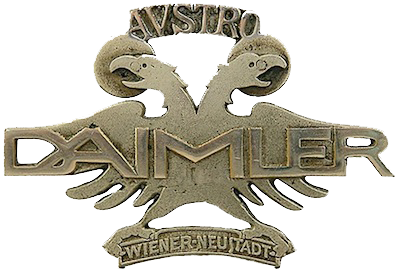
On 11 August 1899 DMG founded a subsidiary company to represent DMG in Austria, this was the Österreichische Daimler-Motoren-Gesellschaft Bierenz, Fischer & Co. (Austrian Daimler Motors Partnership Company Bierenz, Fischer and Co). Established with DMG's subscribed investment of 200,000 guilders, the company factory and offices were at Wiener-Neustadt and in Wein (Vienna). By establishing this subsidiary DMG became the first automotive multinational company. Eduard Bierenz, a friend of Gottlieb Daimler, was appointed to manage the company. Bierenz worked with co-founder Edward Fischer, owner of an iron foundry and engineering company in Austria. Österreichische Daimler marketed under the shortened Austro Daimler trade name.
Right: trademark of Österreichische Daimler Motoren, as affixed to radiator grille of an auto. The logo was also on corporate letterhead (197,796 bytes).
Click on image to see enlarged view (358,159 bytes).
The first designer employed by the firm was Paul Daimler, the son of Gottlieb Daimler. In May 1900 the company completed their first car, a four-seater with a four horsepower (yes, that was only 4) two-cylinder gasoline engine, manufactured at Wiener-Neustadt. In 1909 the Austro Daimler company was formally made an independent concern though with stock still stock held by Daimler, then in 1912 the Daimler company sold its shares in Austro Daimler. From from 1899 through 1934 Austro Daimler would produce motor vehicles including cars, trucks, buses, rail cars, and sold engines for aircraft and for marine applications too. Eduard Fischer would remain active in the company through 1 June 1920.
Elsewhere, mechanic and inventor Johann Puch (b. 27 June 1862 in Juršinci, then Georgendorf, Austrian-Hungarian Empire now in Slovenia) learned much about mechanical design and production while working for a locksmith in southern Austria. After his military service in 1885 he moved to Graz where by 1888 he was hired as a bicycle mechanic working for the large-scale bicycle manufacturer Albl & Co. at Lendplatz 14 in Graz, south eastern Austria. The company was owned by Benedict Albl but it was there he came upon the idea to set out and establish his own bicycle shop. On 2 February 1889 Puch requested a permit to set up his own bicycle repair shop on the premises of what had been a nursery, but that permission was declined owing to a conflict with fire regulations. By September 1889 the council agreed to issue a permit so that Puch could establish his small shop at Strauchergasse 18 in Graz, Austria for the repairing and manufacturing bicycles. By 1891 his company was officially registered as the “Johann Puch Erste Steiermärkische Fahrrad-Fabriks-Aktiengesellschaft” (First Styrian Bicycle Factory Corporation) with manufacturing based at Graz. He was soon selling his new bicycles bearing the trade name “Styria-Räder” (Styria-wheels), to customers within the Austrian Empire while also exporting to other European countries.
Puch must have been a good engineer or mechanic or he knew to hire good employees; for either or both reasons his bicycles were becoming noteworthy among competitive cyclists in only a matter of a few years. By 1892 competitive and performing cyclists were endorsing the Puch bicycles in their own advertisements. Evidence of the superiority of the Puch bicycles includes: advertisements listing the accomplishments of riders who rode his bicycles in races, photos of bicycle club riders standing alongside Puch bicycles or with Puch promotional materials in the background, and these no doubt aided to the credibility of the new product at a time when bicycle popularity was just taking off. By 1894, after only a few years in business, Puch had also established sales offices in several cities across central Europe and with a business office in Wein (Vienna).
 Johan Puch & Company advertisement from mid or late 1894 (102,092 bytes) Johan Puch & Company advertisement from mid or late 1894 (102,092 bytes) |
**"Styria"**-Bicycle WorksFactory: Graz, Karl Strasse 26 - Office: Wien, I. Kärnthnerring 15.What better proof is there for the goodness of **"Styria"**-wheels,as the following won in 1894 the same success?Paris-Vienna (1300 Kilometers) in 5 days 13 hours without machine replacement.Paris-Vienna (4 days 19 hours 30 minutes), Graz (1500 Kilometers) in 5 days 17 hours with no change of machines.Big Graz trophy (1000 Mark Price) Carl Riedel, Vienna-Graz, 14 May! World Record! 206,402 km in 6 hours (Record for all wheel genres).! World Record! over 110 and 120 English miles.! World Record! over 150 kilometers in 5 hours, 200 Kilometer drove Mr. von Franz Gerger, Graz, on 15 May 1894 in Graz.Furthermore, 1894; 16 first, 19 second, 7 third prizes in Vienna, Szczecin, Graz, Gödring, Prague and Czernowitz.1894 Price list on request and free. Above: English translation of the advertisement shown at left. Lesser known cities mentioned are: Stettin now Szczecin in Poland, Gödring in Hungary, Czernowitz in Ukraine. |
|---|
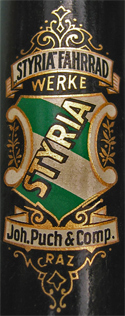 The white and green colors of Puch derive from those of Styria, the Austrian state (or Bundesland) where the company was founded. The shade of green used on the Styrian flag is that of a fir-tree green reflecting the pride of the residents in their forests of fir trees. Head badges on Puch bicycles bear white and green colors, as would competitive teams sponsored by Puch.
The white and green colors of Puch derive from those of Styria, the Austrian state (or Bundesland) where the company was founded. The shade of green used on the Styrian flag is that of a fir-tree green reflecting the pride of the residents in their forests of fir trees. Head badges on Puch bicycles bear white and green colors, as would competitive teams sponsored by Puch.
Left: bicycle painted head badge “STYRIA” FAHRRAD WERKE - STYRIA - Joh.Puch&Comp. - GRAZ” (13,765 bytes).
By 1897 the Joh. Puch & Cie. Styria-Fahrradwerken (Johann Puch & Comp. Styria Bicycle Works) employed some 633 male and 83 female workers, with another 36 apprentices. But Johann Puch became embroiled in a legal dispute with the German Berlin Masschinenfabrik Dürkopp (Berlin machine factory). The result was he retained some interest in the company, but was essentially silenced and barred from contributing. So he and his former shop foreman Anton Werner (Werner & Co.) left to work on building a new company. Johann Puch was unable to market under his own name for legal reasons, so from 1897 to 1899 he marketed his bicycles under the trade name “Original Styria-Räder” (original Styria wheels). Thus two companies were competing then marketing essentially similar products: one as Styria, and the other as Puch managed by Puchs' former factory associate Victor Rumpf.
Going back as far as there is written history of competitions, champion athletes associated with products were often paid to endorse them or the sport. In bicycle race and endurance competitions of the day Franz Gerger (b. 9 Apr. 1867, d. 25 Mar. 1938) dominated bicycle racing from 1895 to 1897, and he was among those highlighted in Puch bicycle advertising. As bicycling and bicycling competitions evolved, not only were races developed for individual participants but there was also team racing of a sort not seen today whereby several riders could train another single rider by sharing the work and thereby increasing their endurance. One of the more amazing to see must have been the Sestupletta, where as many as six (6) bicyclists sharing one two-wheel bicycle frame with a safety wheel at the rear, participate in training a competitive race with the seventh team member riding his own bicycle. 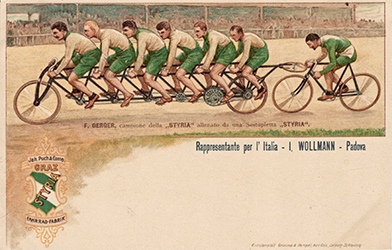
Right: One of several versions of a post card sold between about 1898 to 1902 promoting Styria-Fahrradwerken bicycles features champion racer Franz Gerger following six racers in a tandem frame. The card translated reads: F. Gerger, champion of Styria trained by a Styria Sestupletta. (Sales) representative for Italy - I. Wollmann - Padua. (art/printed by) Kunstanstall Grimme & Hempell Act-Ges. Leipzig-Schleußig (62,894 bytes).
Click on image to see enlarged view (421,486 bytes).
While the Puch company was originally established to produce bicycles, by 1901 the company tooled up to begin the manufacture of small gasoline engines. In 1903 the company expanded into the production of motorcycles, and by 1904 it was also manufacturing small automobiles. Many brilliant engineers were to become affiliated with the Austro Daimler and Puch names, not the least of these was Ferdinand (Ferry) Porsche. Porsche was recruited by Austro Daimler in 1906 to work as their chief automobile designer and Technical Director, taking over those duties from Paul Daimler. Porsche's best known designed Austro Daimler car was introduced in 1910 as the Prinz Heinrich, a sporty model with a four speed transmission and powered by a water cooled 96 hp SOHC (Single Overhead Camshaft) in-line four cylinder engine; it was named after Wilhelm II's younger brother Prince Heinrich of Prussia.
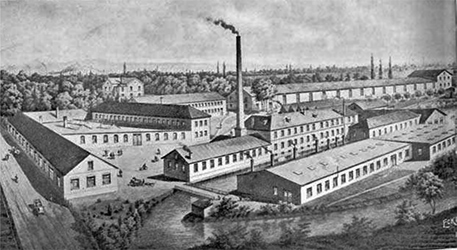 The Styria-Fahrradwerke suffered from a five month long labor strike that spanned from 1907 into 1908, this caused enough losses so that the company nearly failed. Even still, the total production of bicycles had by 1908 surpassed 100,000.
The Styria-Fahrradwerke suffered from a five month long labor strike that spanned from 1907 into 1908, this caused enough losses so that the company nearly failed. Even still, the total production of bicycles had by 1908 surpassed 100,000.
Left: the Puch factory complex in Graz, illustrated as it appeared in 1907 (77,182 bytes).
Click on image to see enlarged view (126,788 bytes).
Johann Puch retired in 1912, after then contributing to the company in an Emeritus status. Over the past couple of decades he founded a company, obtained patents for more than thirty-five inventions and improvements and shepherded his company into a new era, growing that company to some 1,100 employees who were then producing 16,000 bicycles and more than 300 motorcycles and automobiles annually. He died at age 52 on 19 July 1914 in Zagreb (then German Agram), some eighty miles south of Graz. After his death, the company structure was changed to a publicly traded stock corporation, registered as “Puchwerke Aktiengesellschaft” (AG). The Puch company continued to manufacture bicycles and motor vehicles throughout World War I.
Magna International Inc. is a contemporary international automotive components manufacturing conglomerate, and a direct descendant of the Puch company and of its later partners. In commemoration of Johann Puch, the subsidiary Magna Steyr Fahrzeugtechnik AG & Co KG initiated the “_Johann Puch Innovation Award_”, a diploma thesis competition where a panel of experts selects three winners every year. The prize is endowed with a total of € 20,000 and aims to promote young, scientifically and technically talented students in the area of automotive engineering. The award focuses on selected universities and universities of applied sciences in Europe
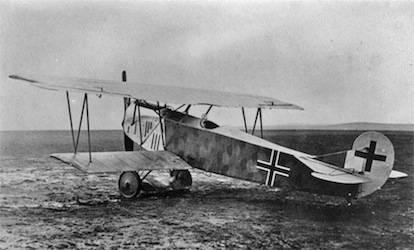 Ferdinand Porsche became Managing Director of Austro Daimler in 1916. As the Austro Daimler engines became more reliable and powerful new applications were found for them including their use in aircraft manufactured in the Austro-Hungarian Empire for the kuk Luftfahrtruppen (Imperial and Royal Aviation Troops), the air forces of the empire. There are advertisements of the period featuring some of the 2,400 or so Austro Daimler motors made for Seaplanes, Reconnaissance, and other aircraft made by companies including Österreichische Flugzeugfabrik AG (Austrian Aircraft Factory Ltd., Oef or Oeffag). The engines made by Austro Daimler bore the military contractor code 'Dm'. A most notable endorsement featured their motors powering several of the famous Albatross (Oef) D.III types. Austro Daimler also made the 225 HP water-cooled motors destined for the feared Fokker D.VII fighters made late in 1918 by Magyar Általános Gépgyár (Hungarian General Machine Factory or MÁG) under license from the Fokker -Flugzeugwerke. Some one hundred fifty (150) of these D.VII aircraft were ordered but of these only nine (9) were completed prior to the end of the war, and none of these with their Austro-Hungarian crewmen were ready for combat before the war ended. The other D.VII's that were completed after November 1918 later saw service with the Hungarian and Czechoslovak military services with some remaining operational well into the 1920s.
Ferdinand Porsche became Managing Director of Austro Daimler in 1916. As the Austro Daimler engines became more reliable and powerful new applications were found for them including their use in aircraft manufactured in the Austro-Hungarian Empire for the kuk Luftfahrtruppen (Imperial and Royal Aviation Troops), the air forces of the empire. There are advertisements of the period featuring some of the 2,400 or so Austro Daimler motors made for Seaplanes, Reconnaissance, and other aircraft made by companies including Österreichische Flugzeugfabrik AG (Austrian Aircraft Factory Ltd., Oef or Oeffag). The engines made by Austro Daimler bore the military contractor code 'Dm'. A most notable endorsement featured their motors powering several of the famous Albatross (Oef) D.III types. Austro Daimler also made the 225 HP water-cooled motors destined for the feared Fokker D.VII fighters made late in 1918 by Magyar Általános Gépgyár (Hungarian General Machine Factory or MÁG) under license from the Fokker -Flugzeugwerke. Some one hundred fifty (150) of these D.VII aircraft were ordered but of these only nine (9) were completed prior to the end of the war, and none of these with their Austro-Hungarian crewmen were ready for combat before the war ended. The other D.VII's that were completed after November 1918 later saw service with the Hungarian and Czechoslovak military services with some remaining operational well into the 1920s.
Right: Fokker D.VII of the k.u.k. Luftfartruppe (Austro-Hungarian Air Service) in 1918. Manufactured by (MÁG) with the Austo Daimler 225 motor, this bears the Balkenkreuz (cross with the straight arms instead of curved arms) in black and white and is finished in lozenge pattern camouflage linen overall with natural metal cowl (87,545 bytes).
Click on image to see enlarged view (226, 390 bytes).
After the end of the war on 11 November 1918 the economic consequences were profound, the economic situation was especially dire in Germany and Austria and this took its toll on the companies. The Treaty of Saint-Germain-en-Laye signed on 10 September 1919 mandated the Austro-Hungarian Empire was to be dissolved, this included many other terms that would impose hardships including 'war reparations' and a ban on aircraft production. Oeffag converted its remaining production lines to fabricate car and bus bodies (coachwork) for Austro-Daimler chassis and motors. In 1920 Austro Daimler agreed to joint ventures with Fiat and with Puchwerken Graz. Employment at Austro Daimler Puchwerke dropped from a peak of about 5,500 employees in 1917 to 3,500 in 1920. With such limited resources and the poor economic climate in the post-war Europe, Austro Daimler Puchwerke focused its efforts to refine its automobile production at Wiener Neustadt with engine production also at Graz.
In 1922 the lightweight sporty “Sasha” model automobile was introduced. Developed under the leadership of Porsche, it was named after their friend and company benefactor Count Sascha Kolowrat-Krakowski. This car had some innovations that would find their way into later Porsche automobiles. Regardless, employment continued to decline plummeting again to only about 1,500 employees in 1923, then down to only 200 employees in 1924.
By 1923 the company was nearly bankrupt as Ferdinand Porsche left the company, being replaced by Karl Rabe as the firms' research director. Rabe started with the company in 1913 at age seventeen, by 1923 he succeeded Ferdinand Porsche. Porsche had indicated Rabe too was an extraordinary engineer.
It was in 1923 when the Italian engineer Giovanni Marcellino arrived at Austro Daimler Puchwerke. He had been hired to consult to the bankers who sought to liquidate the concern. Instead he settled in Graz and helped to rebuild the company with innovations to improve engines performance, and by building cooperative alliances with other manufacturers most notably with Skoda and Fiat. Among the most notable accomplishments by Marcellino was the his design of a new split-single (single cylinder with two pistons) engine with asymmetric port timing; this is a variant on the two-stroke engine but with two cylinders sharing a single combustion chamber. This proved especially significant in the advancement of motorcycles engines performance, culminating in the win by a Puch motorcycle with a supercharged split-single at the 1931 German Grand Prix.
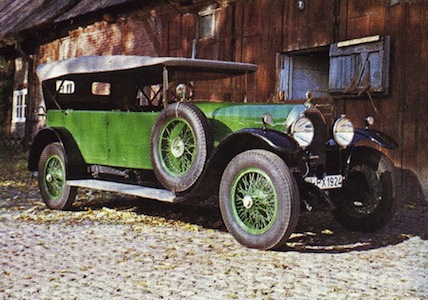
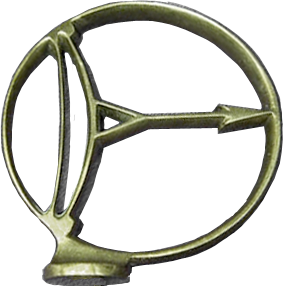 The Sasha was followed in 1923 by the successful ADM, a luxury car and quite a successful accomplishment by the days standards. The ADM was the first of the post-Porsche models, designed by the team led by Karl Rabe. Rabe followed the ADM with the ADR, the first of which incorporate a 2.54 litre 6 cylinder overhead cam engine; the R indicates this is built upon a Rohrrahmen (tubular frame) a stepping away from the Plattformrahmen (platform frame) arrangement as provided with its predecessors. Then just before the ADR cars came onto the market in 1927 however, Rabe was hired away by Porsche to work at his company. Rabe would remain employed at Porsche until shortly before his death in 1968.
The Sasha was followed in 1923 by the successful ADM, a luxury car and quite a successful accomplishment by the days standards. The ADM was the first of the post-Porsche models, designed by the team led by Karl Rabe. Rabe followed the ADM with the ADR, the first of which incorporate a 2.54 litre 6 cylinder overhead cam engine; the R indicates this is built upon a Rohrrahmen (tubular frame) a stepping away from the Plattformrahmen (platform frame) arrangement as provided with its predecessors. Then just before the ADR cars came onto the market in 1927 however, Rabe was hired away by Porsche to work at his company. Rabe would remain employed at Porsche until shortly before his death in 1968.
Left: Austro Daimler ADR of 1924 (71,705 bytes).
Right: Austro Daimler Puchwerke radiator cap with the company logo from about 1931 (170,978 bytes). Note the original AD logo was the basis for the head badge of the production Austro Daimler Puchwerke trademarked bicycles introduced in the 1970's.
Click on the image to see an enlarged view.
The original ADR autos would be followed by variants including the ADM 19/100 “Harrington Tourer”, a 100 mph capable upscale automobile introduced in 1927. By 1928 Austro Daimler Puchwerke was back in the forefront of automobile technology with racing successes by their comparatively powerful ADM 19/100 model. Technically these cars were highly successful for their day with comparatively high horsepower engines, and efficient cooling mated to a well engineered chassis that provided a superior ride and good road handling manners. The 'ADM' and 'ADV' series motor cars continued to earn the company great acclaim throughout the 1920's, marketed as "The Car For The Connoisseur". Even today, some restored Austro Daimler autos win high honors at vintage car shows.
On 31 March 1928 Puch, the Austro Daimler Puchwerke bodywork plant, and Oeffag (the Austrian Aircraft Factory Ltd.) merged. On 28 December 1928 the new company “Austro Daimler Puchwerke Aktiengesellschaft” was entered in the Vienna register of companies. After the merger with Austro Daimler Puchwerke the production of automobiles by Puch was ended however, bicycles and motorcycles continued in production then bearing the Puch trademark. Motors continued in production, with engines large enough to power trains being produced bearing the Austro Daimler trade name and the AD logo shown above right.
The Great Depression that commenced in the USA in October 1929 impacted banking, customer demand for commodities, and employment. The crisis spread overseas too so that by 1930 Europe was enveloped by the Great Depression and their markets for the more upscale automobiles were adversely impacted thus causing a dramatic retraction by production throughout the industry. Regardless of the economic situation in 1930, the first of two new luxurious Austro Daimler Puchwerke motor cars were introduced: the ADR 8, which was followed in 1931 by the ADR 6. Both of the ADR cars were well engineered and stylish. The ADR 8 Alpine features a 4,624 cc (4.6 litre) straight 8 cylinder SOHC gasoline engine producing 121 hp. Some fifty of the ADR 8 were made through the 1935 model year in the customers choice of either a Tourer (2 doors, 2+2 seating with a retracting top), or a Limousine (4 doors and 4 seats), a Cabriolet (2 doors, 2 seats convertible), or Saloon (4 doors, 4 seats). The ADR 6 Bergmeister, introduced in 1932, was a lighter weight model at about 3,200 lbs. Even with its 3,613 cc (3.6 litre) straight 6 in line SOHC engine, the ADR 6 was faster and with a 94 mph top speed, and better at climbing hills (hence 'mountain master') than the ADR 8. The ADR 6 was offered as Cabriolet, Tourer, or Saloon configuration with about fifty of these being completed. These were the last great civilian motor cars introduced under the Austro Daimler Puchwerke trademark.
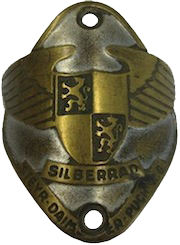
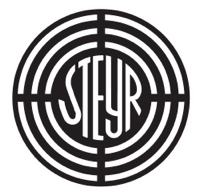 The Great Depression had such a long-term impact that Austro Daimler Puchwerke wound down and then suspended all production by 30 June 1934. Austro Daimler Puchwerke then merged with Steyr-Werke AG to form “Steyr-Daimler-Puch AG”. This merger was registered in Vienna on 12 October 1934, then on 10 May 1935 the Austro Daimler Puchwerke Aktiengesellschaft (corporation) was delisted from the commercial register. The merger that produced Steyr-Werke AG made this one of the three largest manufacturing concerns in Austria in the 1930's.
The Great Depression had such a long-term impact that Austro Daimler Puchwerke wound down and then suspended all production by 30 June 1934. Austro Daimler Puchwerke then merged with Steyr-Werke AG to form “Steyr-Daimler-Puch AG”. This merger was registered in Vienna on 12 October 1934, then on 10 May 1935 the Austro Daimler Puchwerke Aktiengesellschaft (corporation) was delisted from the commercial register. The merger that produced Steyr-Werke AG made this one of the three largest manufacturing concerns in Austria in the 1930's.
Right: Steyr-Werke AG trademark (11,137 bytes).
While the Depression no doubt limited the demand for the ADR 6 and ADR 8 motor cars they continued to be available into 1935, even after the merger with Steyr. After the ADR production stopped in 1935, all automobile production by Austro Daimler Puchwerke was ended as the facilities transitioned solely to the production of motors, and trucks as large as the ADGR a 6x6 (six wheel drive) chassis, lorries (small towing or personnel carrying trucks), motorcycles, and of course bicycles. While Steyr continued with the production of consumer and military passenger vehicles and trucks.
Left: Steyr-Daimler-Puch head badge from a 'Silver Wheel' bicycle made after 1934 (21,206 bytes).
After the merger of 1934, their bicycles were marketed under either the Austro Daimler or Puch trade names though they may bear “Steyr-Daimler-Puch Aktiengesellschaft” or “Steyr-Daimler-Puch AG” engraved on the head badge, and this was embossed on some accessories too. The motorcycles manufactured for the consumer market were assembled at the factory in Graz and after the merger were marketed under the Puch trade name. The economic situation of many people in Europe was still not good owing to the residual effects of The Depression. So there were markets for more affordable modes of transportation, the Volkswagon for example came about in response to this perceived demand. So when Puch attended the Vienna International Spring Fair in March of 1938 they revealed their vision of economical two wheel motor transport, then selling for only 390 Austrian Shillings: the Puch STYRIETTE. The Styriette resembles a motorized bicycle, it features a lightweight lugged and brazed steel frame riding on 26 inch wheels, both with drum brakes, and incorporating an 60 cc 1.3 hp two-stroke air-cooled engine (that consumed only 1.5 liters of gasoline per 100 km) and with pedals too; these would become known to the world as the Moped. It was of particular interest to those aged 16 or less since the law demanded no liability insurance or drivers license to operate the Styriette. Some 2,300 or so of these innovative machines were manufactured before international events would override Steyr Daimler Puch in the Spring of 1938, and production of the Styriette halted. Of course production of motorcycles continued too including their flagship Type 350 GS. In 1936 Puch introduced its largest motorcycle, the Puch 800, a 430 lb four-speed model powered by a 20 HP four cylinder four stroke 792 cc motor; some 550 or so of these would me made into 1938.
 Among the last bits I came upon when researching for this article was the following information, that somewhat diminishes my former fascination with the Steyr-Daimler-Puch brand even though I doubt any of the craftsmen who built my bicycle were war criminals. The history of this traumatic time is conspicuously absent when reading about German and Austrian companies at their Web sites and in their publications; reading their literature it's like their histories spanned from 18xx to 1935 or so and then pick up again in 1948, so I decided to help them:
Among the last bits I came upon when researching for this article was the following information, that somewhat diminishes my former fascination with the Steyr-Daimler-Puch brand even though I doubt any of the craftsmen who built my bicycle were war criminals. The history of this traumatic time is conspicuously absent when reading about German and Austrian companies at their Web sites and in their publications; reading their literature it's like their histories spanned from 18xx to 1935 or so and then pick up again in 1948, so I decided to help them:
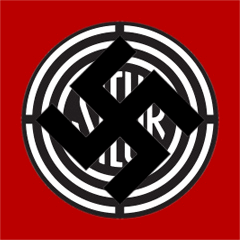 Anschluss and Slave Labor Austria was annexed to the German Third Reich on 12 March 1938, becoming a part of the Großdeutschen Reiches (Greater German Empire). That was just one day before a national referendum was to be held so that Austrians could vote to declare whether or not they wanted to remain independent, or merge with Nazi Germany. The changes at Steyr-Daimler-Puch are a prime example of how major industrial companies would be transformed in the greater Germany - in all aspects. From then and throughout World War II Steyr-Daimler-Puch AG were a noteworthy part of the German manufacturing base providing bicycles, motor vehicles, engines, weapons and other components for the war effort much as General Motors, Ford and other large corporations transitioned to war time production - but the similarities ended there if we do not count how the US treated its Japanese-American population during the war. Labor unions were banned and Jewish management employees were expelled, including the Generaldirektor (General Director) of Steyr-Daimler-Puch, Paul Goetzl - a Jew. Soon after then Jewish laborers too would be fired.
Anschluss and Slave Labor Austria was annexed to the German Third Reich on 12 March 1938, becoming a part of the Großdeutschen Reiches (Greater German Empire). That was just one day before a national referendum was to be held so that Austrians could vote to declare whether or not they wanted to remain independent, or merge with Nazi Germany. The changes at Steyr-Daimler-Puch are a prime example of how major industrial companies would be transformed in the greater Germany - in all aspects. From then and throughout World War II Steyr-Daimler-Puch AG were a noteworthy part of the German manufacturing base providing bicycles, motor vehicles, engines, weapons and other components for the war effort much as General Motors, Ford and other large corporations transitioned to war time production - but the similarities ended there if we do not count how the US treated its Japanese-American population during the war. Labor unions were banned and Jewish management employees were expelled, including the Generaldirektor (General Director) of Steyr-Daimler-Puch, Paul Goetzl - a Jew. Soon after then Jewish laborers too would be fired.
"Die Deutsche Erd- und Steinwerke GmbH” (The German Earth and Stone Works Ltd.), known as DESt, was an SS owned company incorporated in Berlin on 29 April 1938. DESt's original mission was to operate stone quarries and brickworks to provide building materials for state construction projects. Its headquarters were in Sankt Georgen an der Gusen, a small town in Austria where it was convenient to manage operations of the original stone quarries at Gusen (nearby Steyr). At DESt facilities the pernicious principle of “Vernichtung durch Arbeit” was applied; the destruction of laborers through excessive hard work and poor conditions.
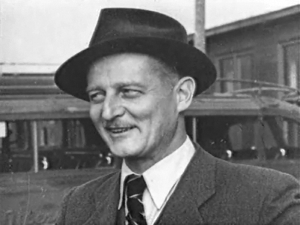 Dr. Georg Meindl (b. 1 March 1899 in Uttendorf, Austria; d. purportedy 10 May 1945 near Steyr), a World War I veteran, was among the many enthusiastic Austrian National Socialist Party members who were promoting a closer affiliation, if not unification, with Nazi Germany. While he was certainly not the only Nazi Party member in Austria, Meindl had been acquainted with Hermann Göering since about 1922 and he worked diligently and calculatingly to become known to many of the higher-ups, hence he was considered to be among the 'Old Guard' of the Austrian Nazis. Having completed his University eduction in business and political science, he earned his title of Dr. Meindl.
Dr. Georg Meindl (b. 1 March 1899 in Uttendorf, Austria; d. purportedy 10 May 1945 near Steyr), a World War I veteran, was among the many enthusiastic Austrian National Socialist Party members who were promoting a closer affiliation, if not unification, with Nazi Germany. While he was certainly not the only Nazi Party member in Austria, Meindl had been acquainted with Hermann Göering since about 1922 and he worked diligently and calculatingly to become known to many of the higher-ups, hence he was considered to be among the 'Old Guard' of the Austrian Nazis. Having completed his University eduction in business and political science, he earned his title of Dr. Meindl.
Right: Georg Meindl, Generaldirektor of Steyr-Daimler-Puch AG 1938-1945 (81,610 bytes).
His personality was described as choleric; that kind of temperament may have some benefits when working towards leadership positions in politics or industry. However, as he promoted, then his impatience and haste to anger likely moderated any sense of humanity in this man. Throughout the 1930's Meindl was employed by and promoted quickly within several industrial Austrian corporations, attaining notable positions including a term from 1936 to 1938 on the Board of Directors of the Österreichisch-Alpine-Montan-Gesellschaft (Austria Alpine Mining Company). Meindl had also become a member of the Upper Austrian parliament. Meindl came to be recognized as intelligent, resourceful, and ruthless too. In recognition of his work for the Nazis Georg Meindl was appointed Generaldirektor of Steyr-Daimler-Puch AG on 15 March 1938. Meindl joined the Allgemeine-Schutzstaffel (the “General SS") as member No. 308208, and an honorary SS officer rank was also conveyed to the CEO of Steyr.
In 1938 the majority of Steyr-Daimler-Puch AG stock was owned by Creditanstalt-Bankverein (Credit Institution Bank Corporation). As the Steyr-Werke celebrated its 75th anniversary on 15 July 1939, Creditanstalt was being coerced into selling the arms company to Hermann Göering Works, and on 9 August 1938 Steyr-Daimler-Puch became a Reichwerke (government-owned) company. With the acquisition a new Board of Directors was instated with Dr. Wilhelm Voss as President and with Paul Pleiger appointed Vice President. The General Directorate relocated from Vienna to Steyr, and on 18 October 1938 Steyr-Daimler-Puch AG decided, at an extraordinary general meeting, to transfer the company's headquarters from Vienna in eastern Austria to Steyr. This relocation placed Steyr-Daimler-Puch AG management nearer to Germany and to other major German industrial companies. Part of this too was motivated by the sense at the time that Linz, the birthplace of Adolf Hitler, was to be reborn as a new major city with monumental projects that would have Linz rivaling Vienna and Budapest among other great European cities.
Meindl nurtured his access to even more of those in the Nazi hierarchy, most notably fellow Austrian Dr. Ernst Kaltenbrunner (b. 4 Oct. 1903, d. 16 Oct. 1946). Kaltenbrunner born at Ried im Innkreis, near Braunau in Upper Austria. He was the son of a lawyer, educated in chemistry and then law at the State Realgymnasium in Linz and at Graz University. He graduated in 1926 with a Dr. jur hence he was Dr. Kaltenbrunner. Kaltenbrunner worked as a lawyer-candidate (apprentice), first at Salzburg and after 1928 at Linz. Joining the Austrian Nazi Party on 31 August 1931, the intelligent, tall (6'7") and imposing Kaltenbrunner promoted fast so that by mid 1935 he was appointed to head the Austrian SS. He assisted in the advance work for the Anschluss, and in recognition of his services on the day the Anschluss was secured Hitler (also Austrian born) promoted Kaltenbrunner to SS-Brigadeführer (a rank equivalent to Brigadier General in most other armed focus) heading the SS Oberabschnitt Donau (SS Upper Danube section). Among his first tasks was to assist the development of a new prison camp at Mauthausen. Kaltenbrunner was promoted yet again on 11 September 1938 to SS-Gruppenführer (Major General).
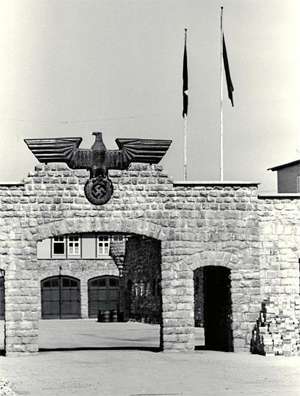 Mauthausen was a prison camp established in 1938 on the orders of Heinrich Himmler, Reichsführer of the SS. The original Mauthausen-Gusen concentration camps, and those satellite camps that would follow were under Kommandant SS-Sturmbannführer (SS Major) Franz Ziereis. The two main camps of the complex, Mauthausen and Gusen I, were constructed around the villages of Mauthausen and Gusen in Upper Austria. The site was close to a working DESt granite quarry, not far from Linz. Initially the camp housed common criminals but by 8 May 1939 the facilities were designated “Konzentrationslager” (concentration camp), commonly referred to as “KL Mauthausen-Gusen”. In January 1941 these would be designated Grade III facilities, the only two in the Nazi system intended to house “Incorrigible Political Enemies of the Reich” who were often classified “Rûckkehr unerwünscht” (return not desired). The initial population included Jews, Communists, German and Austrian intelligentsia but in time other prisoners arrived from the Czech Republic, France, Italy, Greece, Poland, Soviet Union, Republicans from Spain, Yugoslavs.
Mauthausen was a prison camp established in 1938 on the orders of Heinrich Himmler, Reichsführer of the SS. The original Mauthausen-Gusen concentration camps, and those satellite camps that would follow were under Kommandant SS-Sturmbannführer (SS Major) Franz Ziereis. The two main camps of the complex, Mauthausen and Gusen I, were constructed around the villages of Mauthausen and Gusen in Upper Austria. The site was close to a working DESt granite quarry, not far from Linz. Initially the camp housed common criminals but by 8 May 1939 the facilities were designated “Konzentrationslager” (concentration camp), commonly referred to as “KL Mauthausen-Gusen”. In January 1941 these would be designated Grade III facilities, the only two in the Nazi system intended to house “Incorrigible Political Enemies of the Reich” who were often classified “Rûckkehr unerwünscht” (return not desired). The initial population included Jews, Communists, German and Austrian intelligentsia but in time other prisoners arrived from the Czech Republic, France, Italy, Greece, Poland, Soviet Union, Republicans from Spain, Yugoslavs.
Left: The gate to Konzentrationslager Mauthausen (70,924 bytes).
The camps too practiced “Vernichtung durch Arbeit” (extermination through labor) working prisoners to death; when a prisoner could no longer be productive then if not killed on the spot they were sent to an infirmary which either dispatched them or passed them elsewhere to be murdered.
By 1939 the Nazis had determined the extermination of small numbers of people was quick and economical by injection with phenol (carbolic acid) since only about one gram is sufficient to cause death. Phenol injections were given to thousands of prisoners, to medical and psychiatric patients, and to others that had been deemed undesirable by the Nazis. Since 1940 a more efficient portable gas chamber was in service at Mauthausen, this was used to kill those prisoners who were judged surplus or no longer productive.
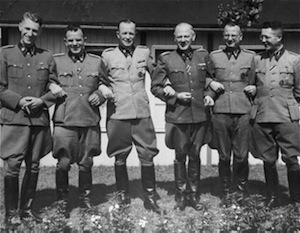 But to meet the requirements to kill an increasing population, particularly after the invasion of Russia, on the orders of Ziereis a larger capacity gas chamber was built. This was organized by a doctor and SS-Hauptsturmführer (SS Captain) Erich Wasicky (or Wasitzky, b. 27 May 1911 in Vienna), the SS pharmacist, and went into operation with the cooperation of the garrison chief medical doctor SS-Hauptsturmführer Eduard Krebsbach. Completed underground beneath the camp hospital this was camouflaged as a bathroom and became operational in March 1942. Using Zyklon B Giftgas, a pesticide poison gas patented by IG Farben and made by Degesch - Deutsche Gesellschaft für Schädlingsbekämpfung (German Society for Pest Control), this facility could murder up to about 120 people at a time.
But to meet the requirements to kill an increasing population, particularly after the invasion of Russia, on the orders of Ziereis a larger capacity gas chamber was built. This was organized by a doctor and SS-Hauptsturmführer (SS Captain) Erich Wasicky (or Wasitzky, b. 27 May 1911 in Vienna), the SS pharmacist, and went into operation with the cooperation of the garrison chief medical doctor SS-Hauptsturmführer Eduard Krebsbach. Completed underground beneath the camp hospital this was camouflaged as a bathroom and became operational in March 1942. Using Zyklon B Giftgas, a pesticide poison gas patented by IG Farben and made by Degesch - Deutsche Gesellschaft für Schädlingsbekämpfung (German Society for Pest Control), this facility could murder up to about 120 people at a time.
Right: Konzentrationslager Mauthausen management team (70,924 bytes). It is scary how normal, even friendly these mostly highly educated monsters appear. From left to right: SS-Hauptsturmführer Dr. Erich Wasicky (camp apothecary); Karl Schulz, chief of “Politischer Abteilung” (Gestapo office of the camp); Kommandant SS-Sturmbannführer Franz Ziereis; camp doctors Sturmbannführer Dr. Eduard Krebsbach and SS-Hauptsturmführer Dr. Karl Gustav Böhmichen, and an unidentified Obersturmführer.
Image taken by SS-Hauptscharführer Paul Ricken, Spring 1943 (31,182 bytes).
Click on image to see enlarged view (140,217 bytes).
Since May of 1940 SS-Hauptscharführer (Master Sergeant) Martin Roth had been the SS leader of the work detail (Kommandofuehrer) at the camp crematorium, but from March 1942 through the liberation of the camp he managed the murders in the gas chamber. After the unsuspecting prisoners were ordered into what they thought was a shower room, Roth and his assistant would activate the poison gas then flow it into the chamber with the prisoners. After about fifteen minutes he would look through the peep-hole of the door of the gassing chamber in order to insure that no victim was stirring. When he was satisfied the people were all dead he then switched on the ventilator to vent the gas outdoors, and after some time he would open the door and hold out a chemical test strip to assure it was safe for inmates under his command to remove the bodies to the crematorium.
In 1939 the foundation was laid to build a large ball-bearing factory in Steyr-Münichholz, and from then plans accelerated to put Steyr-Daimler-Puch AG onto a war footing. Consider the growth that would be seen: in 1938 the company earned 57 million Reichsmark in sales but by 1943 that would increase by eight fold. Similarly the number of employees grew from about 7,000 in 1938 up to about 50,000 in 1944. However, by 1944 every second of those 'employees' was a prisoner from nearby concentration-camps forced to labor at Steyr under the direction of Georg Meindl, a man who became among the most important corporate leaders in Nazi Austria. In the verdict of history it was later written:
“If one can speak of an industrial heritage (of) Meindl, then should conceal it not, that it was impregnated by extreme crime”
By 1941 the Steyr factories experienced a shortage of laborers, particularly at the aircraft engine manufacturing plant. This lack of labor was due in part to conscription of able males for military service, the Nazi aversion to employing women in production roles over the first few years of the war, and the gradual firing and extermination of the Jewish workers and others deemed 'undesirable' and their families. This prompted Georg Meindl to consider alternate sources of labor. Konzentrationslager Mauthausen was only about 30 kilometers from Steyr, Meindl viewed that as a potential pool of free labor. Heretofore, the use of prisoners at factories had not been a common practice, so Meindl appears to have been the first industrialist to seek this out. Meindl negotiated with the SS leadership through channels from Kaltenbrunner and up to Himmler. Therefore, Meindl was authorized to use slave labor provided by the SS furthermore, he could coordinate the logistics directly with Kommandant Ziereis. Ziereis was among the more infamous members of the SS-Totenkopfverbände ("Death's-Head Units"), the SS organization responsible for administering the labor camps, Konzentrationslager (Concentration Camps), and death camps for the Third Reich. The SS would provide forced laborers on a daily basis that would be transported under guard by train to work at Steyr factories by day, and back to the camps in the evenings. This agreement made Steyr-Daimler-Puch among the early, if not the first, manufacturing concerns adopting the use of forced slave labor from concentration camps.
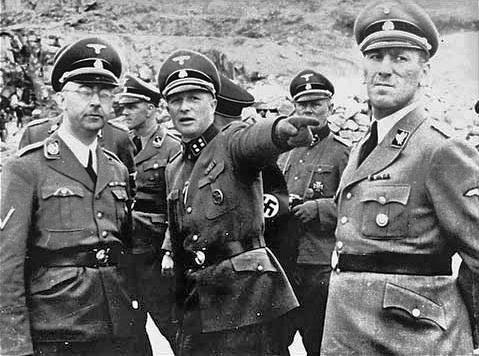
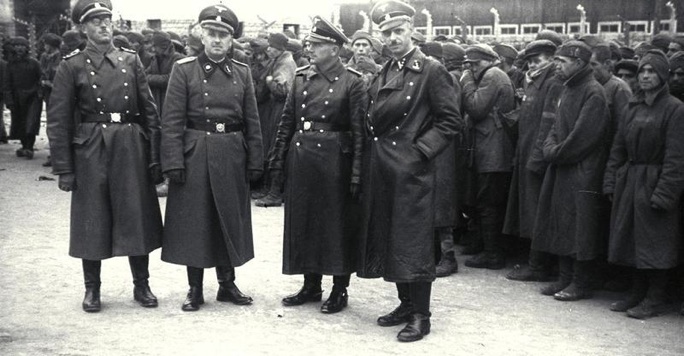
Above left (left to right): Reichsführer of the SS Heinrich Himmler, Kommandant Franz Ziereis, and SS-Gruppenführer Ernst Kaltenbrunner visiting Mauthausen 27 April 1941 (77,182 bytes).
Above right: SS-Totenkopfverbände men in front of prisoners on the parade ground in Mauthausen-Gusen, October 1941 (91,154 bytes).
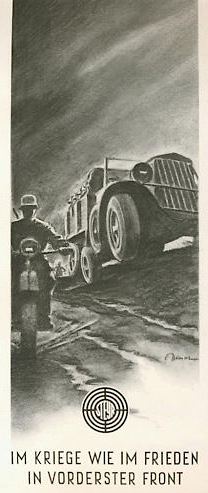 By the Spring of 1941 Steyr had about three hundred (300) slave male laborers provided by DESt working in positions related to the construction work of Steyr facilities including bomb shelters. Additional laborers were requested for Steyr. On 5 January 1942 Meindl wrote a letter to Kaltenbrunner recommending a new 'satellite' prison camp facility be constructed nearer to the Steyr factory. In this letter Meindl coldly reasoned this would reduce the travel distance so that more prisoners would be available to work for even more hours per day. Meindl went on to explain this would also reduce the number of German/Austrian security personnel that would otherwise be needed to manage transports and security to and from Mauthausen. In reply to his request the KZ-Nebenlager (concentration camp satellite) Steyr-Münichholz facility was completed by 14 March 1942; this was located about four kilometers from Steyr. It was 'staffed' by prisoners assigned from the main KL Mauthausen. The camp typically housed between 1,000 to 1,500 prisoners, but by April 1945 there were some 3,090 prisoners there working for the city and for Steyr-Daimler-Puch AG. By this time Steyr-Daimler-Puch was producing nearly ten percent of all rifles for the German war effort. For the city of Steyr too they labored, building roads and air-raid bunkers. Brigadeführer Meindl was fast becoming considered to be a sort of 'mini-Speer' (reference to Armaments Reichsminister Albert Speer) by some, a man who might even be qualified to manage the SS operated manufacturing industries.
By the Spring of 1941 Steyr had about three hundred (300) slave male laborers provided by DESt working in positions related to the construction work of Steyr facilities including bomb shelters. Additional laborers were requested for Steyr. On 5 January 1942 Meindl wrote a letter to Kaltenbrunner recommending a new 'satellite' prison camp facility be constructed nearer to the Steyr factory. In this letter Meindl coldly reasoned this would reduce the travel distance so that more prisoners would be available to work for even more hours per day. Meindl went on to explain this would also reduce the number of German/Austrian security personnel that would otherwise be needed to manage transports and security to and from Mauthausen. In reply to his request the KZ-Nebenlager (concentration camp satellite) Steyr-Münichholz facility was completed by 14 March 1942; this was located about four kilometers from Steyr. It was 'staffed' by prisoners assigned from the main KL Mauthausen. The camp typically housed between 1,000 to 1,500 prisoners, but by April 1945 there were some 3,090 prisoners there working for the city and for Steyr-Daimler-Puch AG. By this time Steyr-Daimler-Puch was producing nearly ten percent of all rifles for the German war effort. For the city of Steyr too they labored, building roads and air-raid bunkers. Brigadeführer Meindl was fast becoming considered to be a sort of 'mini-Speer' (reference to Armaments Reichsminister Albert Speer) by some, a man who might even be qualified to manage the SS operated manufacturing industries.
Right: advertisement by Steyr from 1941 featuring a motorcycle and transport truck. The text translates to “In war as in peace in the forefront” (39,296 bytes).
On 30 March 1943 Albert Speer visited Konzentrationslager Mauthausen-Gusen, this was his sole visit ever to a concentration camp. His VIP tour took about 45 minutes presenting the camp to him as a nearly 'idyllic' facility complete with flowers in vases in the one or two barracks he visited while diverting him and his retinue away from areas that might offend sensibilities. Speer was accompanied by Prof. Ferry Porsche and met with senior executives of the Steyr-Daimler-Puch and the Reichswerke Hermann Göering organizations. At the direction of Speer, on 30 April 1943 DESt signed an agreement with Steyr-Daimler-Puch AG allocating additional slave labor for wartime production. After meeting his old friend Reichsmarschall Göering at the airfield in Graz, Meindl sent a letter to Himmler on 14 July 1943 referring to that meeting and requesting an additional 2,000 prisoners to work at Flugmotorenwerke Ostmark (aircraft engine factory east) manufacturing facilities to be built in Wiener Nuedorf for the production of aircraft engines. Thus Konzentrationslager Wiener Neudorf was opened on 2 August on a two-acre site where the municipality of Guntramsdorf is now. Wiener Neudorf, with a peak capacity of nearly 3,000 people, was another one of what would become more than fifty sub-camps associated with Mauthausen.
The Lagerkommandant (camp commander) of KZ-Nebenlager Steyr-Münichholz from 27 August 1943 to 6 May 1945 was SS-Obersturmführer Otto Hees. Heess was a German from Pforzheim who had been an office clerk by profession, and a member of the Nazi Party (NSDAP) since 1933. Heess had been an SS staff member at the main camp at Mauthausen from February 1940 to August 1943, this included a term as commander of the guard troops in the quarries of the Wiener Graben. By 1943 he promoted to Obersturmführer, that corresponded to the rank of Oberleutnant (Lieutenant) in the Wehrmacht (regular Army). Among the most cruel of the staff at Steyr-Münichholz was SS-Scharführer (Sergeant) Gottlieb Muzikant, from Mürau in present day Czechoslovakia, he was an SS-Sanitäter (medic) on staff known to torture prisoners “in every possible way” and murder prisoners by any one of several cruel methods including the injection of phenol.
By the end of 1943 some 1,300 concentration camp prisoners worked for Steyr-Daimler-Puch in Arbeitskommandos (prisoner work details) at eight different production halls of Gusen. While some improvements to prisoner conditions over those at Mauthausen were granted in the interest of worker productivity, the overall poor nutrition combined with the hard work, at times in freezing cold with a lack of winter clothing, and absent medical care claimed their victims. So replacements were periodically called in. In time some 18 barracks (or halls) were established at Gusen under the commands “GEORGEN-MUEHLE I, II, III and IV” for some eight thousand five hundred (8,500) additional laborers working at the Steyr-Daimler-Puch underground factory built there in 1943.
Steyr-Daimler-Puch, as did most other Reich Corporations, developed 'trustee sites' these were subcontractor facilities in Poland at Radom and Warsaw that relied on slave labor as well. By the end of 1943 production facilities in the area were gradually being dispersed, relocating to underground to provide better protection from Allied air raids. One of the sub camps of Mauthausen was formed around the Freiherr von Birago military barracks in Melk; this underground facility for the production of roller bearings was some 70 kilometers distant from the larger complex. Operating under the code name “Project Quartz” preparations on site commenced in March 1944. On 21 April 1944 the first five hundred inmates arrived from the main camp, they were accommodated in 18 housing blocks and were initially employed in the tunneling work at Roggendorf, about four and a half kilometers from their camp in Melk. Daily, the inmates were transported back and forth working three shifts of eight hours each to construct the facilities that would go on line in December 1944 operating under the code name “Erle”.
Steyr-Daimler-Puch rented space at underground facilities from DESt, amounting to some 3,050 square meters by February 1945. Wartime slave labor from Mauthausen working for Steyr would peak at about three thousand ninety (3,090) by April 1945. These had worked on the production of weapons including the Karabiner K 98 rifle, the MP 44 and 45 assault guns, MG 42 machine gun, and airplane engines. Dr. Meindl was rewarded for his efforts again on 9 November 1944 with a promotion to SS-Brigadeführer, still with a status that conferred no line military authority.
The United States Third Army forces, supported by elements of the US Army Air Force, continued to advance into and through Austria anticipating meeting Russian forces advancing from the east. United States XX Corps, 71st Infantry Division Combat Operations reports of 5 May include mention:
“Moving on approximately a ten mile front the division advanced twenty three miles east with the 5th regimental combat team capturing STEYR (V9760) and seizing a bridge across the ENNS River. With the exception of fire fights engaged in by the 5th regimental combat team in the vicinity of NIEDERGLINK (V9764) and the 14th RCT in the vicinity of ZIPVACHZELL (V7364) and SATTLEDT (V7061). Enemy resistance was negligible. Columns of retreating enemy soldiers surrendered and offered no resistance.”
the reference to retreating enemy soldiers were Germans trying to escape capture by Soviet forces, hoping for better treatment by US and other allied forces..
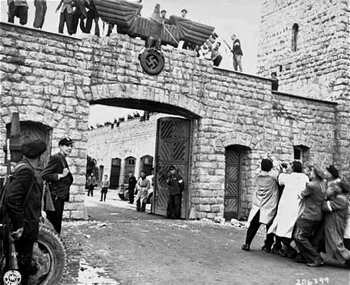 On the afternoon of 5 May 1945 twenty-three soldiers on patrol led by S/Sgt. Albert J. Kosiek of the First Platoon of Troop D, 41st Recon Squad of the US 11th Armored Division, 3rd US Army liberated the camps at Mauthausen-Gusen. That same day American troops entered Steyr, and KZ-Nebenlagers Steyr-Münichholz. On 7 May regular troops of the 11th Armoured Division and 26th Infantry Division occupied the St. Georgen-Gusen-Mauthausen areas. The US 260th Infantry Regiment formed the regional military government based at St. Georgen. Soviet troops arrived by 8 May.
On the afternoon of 5 May 1945 twenty-three soldiers on patrol led by S/Sgt. Albert J. Kosiek of the First Platoon of Troop D, 41st Recon Squad of the US 11th Armored Division, 3rd US Army liberated the camps at Mauthausen-Gusen. That same day American troops entered Steyr, and KZ-Nebenlagers Steyr-Münichholz. On 7 May regular troops of the 11th Armoured Division and 26th Infantry Division occupied the St. Georgen-Gusen-Mauthausen areas. The US 260th Infantry Regiment formed the regional military government based at St. Georgen. Soviet troops arrived by 8 May.
Right: on 6 May 1945 liberated prisoners take down the gate keeper at the former KL Mauthausen (63,442 bytes).
Click on image to see enlarged view (84,999 bytes).
On 5 May 1945, all German forces in Bavaria and Southwest Germany signed an act of Surrender to the United States forces at Haar, outside Munich. This was effective on 6 May.
On 7 May 1945 General Alfred Jodl, Chief of Staff of the German Army, representing the government of Germany, visited General Dwight D. Eisenhower's Supreme Headquarters, Allied Expeditionary Force (SHAEF) at Reims, France. Here, Jodl signed the document of unconditional Surrender to the Allies at 02:41 Central European Time (CET). On 8 May 1945 a second instrument of surrender was signed at 22:43 CET on behalf of Germany by Field-Marshal Wilhelm Keitel, at the Soviet Military Administration in Germany in Karlshorst, Berlin, with the surrender taking effect at 23:01 CET on the same day.
The war in Europe was over.
The Reckoning The prisoner death toll at the Mauthausen complex is estimated at between 122,766 and 320,000; records destroyed by the Nazis preclude a concise determination. So what became of all these big shots mentioned above and their minions? There would be some thirty-six major trials plus trials for twenty-five individuals. Known as the Mauthausen-Gusen Military Tribunal at Dachau, these were conducted to assess the participation and culpability of the 298 defendants from KL Mathausen-Gusen, it's sub and satellite camps. This series of trials resulted in 117 death sentences, 55 sentences for life imprisonment, 104 sentences for terms of from two to thirty years, and 22 acquittals.
The first trail commenced on 7 March 1946 when sixty-one former Mauthausen camp personnel and collaborating prisoners ('Capos' who worked for the SS) were brought to trial before an American Military Tribunal in Dachau, Germany. The defendants were all charged with violation of the laws and usages of war, as well as with subjecting foreign nationals to killing, beating, torture, and starvation. The trial began 29 March and lasted only six weeks, with the court finding all sixty-one defendants guilty on 11 May concluding there was enough evidence of death by shootings, gassings, hangings and starvation to find every member of the camp personnel culpable. On 13 May the court sentenced fifty-eight of the defendants to death and gave the other three life sentences. Later, nine of the death sentences were reduced to life sentences. Those sentenced to death were hanged on 27 to 28 May 1947 in the yard of the Landsberg am Lech War Criminal Prison Nr. 1 (prison) in Bavaria.
- Dr. Georg Meindl had fled Vienna in March 1945, fearing the approaching Soviet forces. He was reportedly at Losensteinleiten, north-northwest of Steyr, when Steyr was surrendered to US forces on 5 May. Meindl was arrested by the American troops then interrogated at Schloss Lamberg (Lamberg Castle) in Steyr, then transferred to the prison at the Berggasse section of Steyr. Around noon of 10 May he was released from custody, his release was a mistake because his significance had not been apparent. From Berggasse he was observed to have traveled north, a few hundred meters or so later crossing the Steyr River towards St. Michaels Church. Later the same day on 10 May a house fire overhaul revealed an unidentifiable charred body in the attic of a small home, some termed this a shed, at Sierninghofen 38 (now at or about Sierninghofenstraße No. 133), Sierninghofen, to the west of Steyr. The autopsy was inconclusive, but it was only because of circumstantial evidence, the personal papers found under the body, that suggested the man was Georg Meindl.
A couple of years later a business dispute between his daughters, Ingrid and Christa Meindl, and the issuer of their father's accidental death and dismemberment (AD&D) insurance policy became publicized in an article published by “Neues Österreich” newspaper on 27 August 1947. His daughters sought payment of the insurance policy, but the insurer disputed whether the body found and buried in 1945, purported to have been that of Georg Meindl, was correctly identified. - Dr. Ernst Kaltenbrunner was the highest surviving SS-leader, then SS-Obergruppenführer (Lieutenant General) und General der Polizei und Waffen-SS. He was arrested by an American intelligence team on 12 May 1945. Convicted at the Nuremberg Trials, he was hanged at the Nuremberg Prison on 16 October 1946.
- Franz Ziereis abandoned his post at Mauthausen on 2 May, and driving off that evening with his wife and children they arrived early on 3 May at his mountainside hunting lodge near Spital am Pyhrn in Upper Austria. On 23 May he was discovered by a US Army patrol near his lodge, and though dressed in civilian clothes he was recognized and attempted to flee but was shot and wounded by the US soldiers. Suffering from bullet wounds to the left arm and torso he was given first aid, then brought to the US Army 131st Evacuation Hospital at Gusen I. Conscious and knowing he was going to die, Ziereis spent several hours of that evening speaking candidly with interrogators about Mauthausen and its operations, its staff, and about camp operations and his role there before he died on the morning of 24 May.
- August Eigruber was the Austrian-born Gauleiter of Oberdonau, the topmost Nazi Party representative in a region. In 1938 he helped to establish the Mauthausen complex by conveying the land to the SS and later by supporting their other projects, and aiding those efforts of industry including Steyr-Daimler-Puch. He also served on the Board of Directors of Steyr-Daimler-Puch AG. Eigruber was captured by American troops then tried by the first American Military Tribunal at Dachau convened from 29 March to 13 May 1946. Convicted on 13 May 1946, he was hanged on 28 May 1947 at the Landsberg am Lech War Criminal Prison Nr. 1.
- Dr. Eduard Krebsbach was captured by American troops. Tried by the first American Military Tribunal at Dachau, he was convicted on 13 May 1946, and hanged on 28 May 1947 at the Landsberg am Lech War Criminal Prison Nr. 1.
- Dr. Erich Wasicky was captured by American troops. Tried by the first American Military Tribunal at Dachau, he was convicted on 13 May 1946, and sentenced to be hanged on 27 May. However, the US authorities extended some compassion to Wasicky that he likely never extended to his victims, rather than be hanged on his birthday they pushed back the event at the Landsberg am Lech War Criminal Prison Nr. 1 by one day to 28 May 1947.
- Otto Heess was arrested by the American troops. Tried by the fourth American Military Tribunal in Dachau (U.S. Vs. Willi Auerswald and others) convened from 2 to 17 July 1947, Heess was convicted of crimes committed against prisoners in the Gusen camp including applying severe punishments and murder, then sentenced to life in prison. There are some later examples of justice, even if delayed. Consider the cases of:
- Gottlieb Muzikant, he was arrested on 30 April 1959 by West German police and charged in a Justiz und NS-Verbrechen (Justice & Nazi Crimes) proceeding. The trial commenced in the West German court in Fulda on 31 November 1960. There he explained to the court that he had not considered enemies of the State to be human beings furthermore, he had been shown "how to kill people quickly and painlessly". He was convicted for war crimes committed in 1943, and between August 1944 to April 1945 at KZ-Nebenlager Steyr-Münichholz and KZ-Nebenlager Melk consisting of: murder of ninety prisoners of Czech, Slovak, Russian and Hungarian nationalities by phenol injections (usually directly into their heart), as well as the murder of another one hundred prisoners by mishandling, shooting, strangling, beating, and by depriving them of medical care. On 23 December 1960 Muzikant was sentenced to life plus and additional fifteen years in prison.
- Martin Roth, (born 11 August 1914 in Ob Bidingen, Germany, died 6 February 2003 at Seeg, Germany) the SS-Hauptscharführer mentioned above did not face any form of justice until many years later. When brought to trail in Germany (StA Hagen AZ: 11 Ks 1/70) it was proved, and he confessed, that he took part in the mass killings by means of Zyklon B gas chambers at the camp, and that he was involved in killing nearly 1,692 prisoners including Soviet military prisoners of war. Roth also participated in the executions of other prisoners by shooting and hanging. On 24 July 1970 he was convicted of the aforementioned crimes and sentenced to seven (7) years imprisonment by the Court in Hagen, West Germany. This author reasons that German court placed a value of about 1.5 days in prison for each murder committed.
The post war trials and many sentences generated significant controversy. Some in German circles claimed the allies had used the trials to defame the German people, while the church expressed concern about the death penalties in particular. There were questions raised, even within some Allies legal circles, about fairness and technicalities of the trials even for some whose crimes were obvious and clearly abominable. Then there was the problem of situational ethics, practices of governments including the USA trying to put the past behind them while trying to confront what they perceived as the threats to democracy from Stalin's Soviet Union. As a result several war criminals had their death sentence conveyed, or some who had been sentenced to long terms were released well before the term was served. The Americans closed the Landsberg War Criminal Prison facility in 1958 and handed the building over to the Federal Republic of Germany.
 After The Whirlwind Steyr-Daimler-Puch came under control of the US Army occupation forces at the end of the war. The allies viewed Austria at the time as a victim of Germany, hence they agreed at the Moscow Conference in 1943 to liberate Austria then to reconstitute it as a free and independent state. In compliance with the occupation plans set forth by the Allied leadership before the end of the war, on 28 July 1945 US troops departed that region of Austria leaving it in the hands of Soviet occupational forces. The Soviets and allies expropriated whatever interested them in the region, particularly plans and materials for the productions of Messerschmitt designed Me 262 jet aircraft fabrication, as post war Europe gradually settled into the new order.
After The Whirlwind Steyr-Daimler-Puch came under control of the US Army occupation forces at the end of the war. The allies viewed Austria at the time as a victim of Germany, hence they agreed at the Moscow Conference in 1943 to liberate Austria then to reconstitute it as a free and independent state. In compliance with the occupation plans set forth by the Allied leadership before the end of the war, on 28 July 1945 US troops departed that region of Austria leaving it in the hands of Soviet occupational forces. The Soviets and allies expropriated whatever interested them in the region, particularly plans and materials for the productions of Messerschmitt designed Me 262 jet aircraft fabrication, as post war Europe gradually settled into the new order.
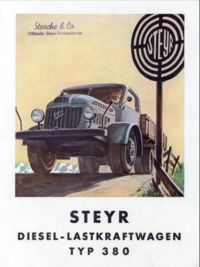 The Allies were eager to 'move beyond' matters of World War II as they faced a perceived threat from the Soviet-dominated eastern bloc nations. Reconstruction, the restoration of farming and manufacturing, even the building of a new Army in West Germany was encouraged by the western allies. Austria in general was treated with a leniency not initially extended to Germany; it was as though innocent Austria had been invaded by that bad Germany and then liberated by the Allies. The Reichswerke assets in allied-occupied Austria were nationalized by the First Nationalization Law enacted by the Austrian Parliament on 26 July 1946. Reconstruction of the Steyr-Daimler-Puch AG works commenced soon after the end of the war and transition back to civilian-oriented production was well enough organized that by mid 1946 the first serial production motor vehicle was underway, these were the 125cc motorcycles. Most that were initially produced, including the Puch 125 Touren (125 T), were models based on prewar or wartime production designs. October of 1946 Steyr was back in the limited production of work trucks, most notably the Steyr 380 Diesel-Lastkraftwagen that was a derivative of the war-time production Model 1500A, a versatile truck chassis developed in only 52 days and personally approved for production by Adolf Hitler. The Steyr 380 chassis became the foundation of many working trucks, from cargo haulers to dump trucks, buses, firefighting apparatus, and more.
The Allies were eager to 'move beyond' matters of World War II as they faced a perceived threat from the Soviet-dominated eastern bloc nations. Reconstruction, the restoration of farming and manufacturing, even the building of a new Army in West Germany was encouraged by the western allies. Austria in general was treated with a leniency not initially extended to Germany; it was as though innocent Austria had been invaded by that bad Germany and then liberated by the Allies. The Reichswerke assets in allied-occupied Austria were nationalized by the First Nationalization Law enacted by the Austrian Parliament on 26 July 1946. Reconstruction of the Steyr-Daimler-Puch AG works commenced soon after the end of the war and transition back to civilian-oriented production was well enough organized that by mid 1946 the first serial production motor vehicle was underway, these were the 125cc motorcycles. Most that were initially produced, including the Puch 125 Touren (125 T), were models based on prewar or wartime production designs. October of 1946 Steyr was back in the limited production of work trucks, most notably the Steyr 380 Diesel-Lastkraftwagen that was a derivative of the war-time production Model 1500A, a versatile truck chassis developed in only 52 days and personally approved for production by Adolf Hitler. The Steyr 380 chassis became the foundation of many working trucks, from cargo haulers to dump trucks, buses, firefighting apparatus, and more.
Left: Steyr advertisement for their 380 Diesel-Lastkraftwagen (11,911 bytes).
Creditanstalt-Bankverein, the bank formerly holding stock in Steyr-Daimler-Puch before the war, was nationalized and then resumed operations including holding stakes in several important Austrian companies again including Steyr-Daimler-Puch Aktiengesellschaft Werke Graz. By February 1947 Steyr-Daimler-Puch AG was gearing up to resume the production of larger and improved motorcycles.
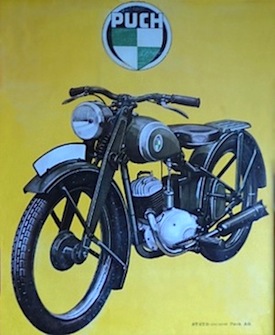 By 1949 cooperation agreements were being signed between Steyr-Daimler-Puch AG and manufacturers in western bloc nations, among the first of these was one with Fiat of Turin, Italy. Puch had been producing motorcycles since 1903, introducing their popular two-stroke motor in 1923. In 1949 the motorcycle production line was turning out the the 125 TT that would remain in production and basically unchanged through 1952. By 1950 the production line included their then largest 250 TF, built upon a 250cc motor.
By 1949 cooperation agreements were being signed between Steyr-Daimler-Puch AG and manufacturers in western bloc nations, among the first of these was one with Fiat of Turin, Italy. Puch had been producing motorcycles since 1903, introducing their popular two-stroke motor in 1923. In 1949 the motorcycle production line was turning out the the 125 TT that would remain in production and basically unchanged through 1952. By 1950 the production line included their then largest 250 TF, built upon a 250cc motor.
Right Puch 125 TT, as manufactured between 1949 and 1952. Advertisement by Steyr Daimler Puch AG (37,972 bytes).
In October 1953 Puch introduced two new motorcycles including the two-stroke 250 SGS (Schwinggabel-Sport or fork sports model), joining the 125 RL, 150 TL and 250 TF models then in production. The 250 SGS was powered by an improved 16.5 HP version of the split-single two-stroke engine developed by Giovanni Marcellino in the 1920's. This was so successful a motorcycle that it would remain in production through 1970. Their offerings including other engine sizes with suffixes indicating their function or arrangement such as the 175 SV (Schwingarm-Vollnabenbremsen or full swing arm brake hubs), and 250 SG (Schwinggabel).
In 1954 Puch introduced their first 'Moped' the MS 50, this economical two wheeled vehicle was well suited for the needs of European urban living at the time and this was the first of a decades long success story for the company. In May 1955 full independence by Austria was regained, and by then and throughout the next decade all of the Puch bicycles and Mopeds were manufactured in Graz, Austria. Bicycles, mopeds, and motorcycles manufactured for sale domestically as well as for export in Europe and to the USA bore either the Puch or Steyr-Daimler-Puch trade names.
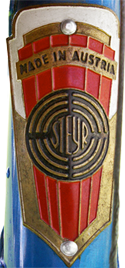 The postwar bicycle models initially produced well into the 1960's resembled their prewar and wartime designs, these included variants of the City series that were marketed under various model designations including the S70 for example. The frame and some components were made by Steyr and with major components provided by other vendors: tubing for the frames of some models was sourced from Reynolds, spring suspension saddles (seat) by SMP, tires by Semperit, the kickstand by Pletscher (ESGE) for example. The rims might have been made by a third party with the wheels bearing 'Styria Austria' trade mark. In 1955 the assigned frame serial numbers surpassed 1,100,000. The Puch bicycle catalog of 1956 shows seven basic models in production with many models available in any one of numerous size frames. Puch reinstated some of the names that were previously associated with some of the great products of their past, including the Puch 'Bergmeister' model that reflected one of their popular road touring bikes; the rugged steel framed Bergmeister continued in production from the late 1950's through about 1974.
The postwar bicycle models initially produced well into the 1960's resembled their prewar and wartime designs, these included variants of the City series that were marketed under various model designations including the S70 for example. The frame and some components were made by Steyr and with major components provided by other vendors: tubing for the frames of some models was sourced from Reynolds, spring suspension saddles (seat) by SMP, tires by Semperit, the kickstand by Pletscher (ESGE) for example. The rims might have been made by a third party with the wheels bearing 'Styria Austria' trade mark. In 1955 the assigned frame serial numbers surpassed 1,100,000. The Puch bicycle catalog of 1956 shows seven basic models in production with many models available in any one of numerous size frames. Puch reinstated some of the names that were previously associated with some of the great products of their past, including the Puch 'Bergmeister' model that reflected one of their popular road touring bikes; the rugged steel framed Bergmeister continued in production from the late 1950's through about 1974.
Left: Embossed aluminum head badge of a Steyr bicycle, probably built about 1970 (92,616 bytes).
Steyr and Puch trademarked bicycles made into the early 1970's included simpler frames with geometries dating to the pre-war era and of steel alloy construction, these bore a head badge similar to that shown at left with either the Steyr or Puch name. But even their best bicycle products at that time were less than impressively built, comparatively heavy and with contracted lower-end components branded Altenburger for example. The bicycles made through the 1960's and early 1970's incorporated components including rims and wheels, brakes, derailleurs, handlebars, and accessories by Shimano, Simplex, Weinmann, Huret, Bluemels Olympic, and by other popular makers of the era.
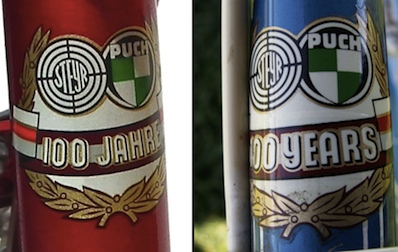 As mentioned earlier in this article, Austro-Daimler Puch was a wholly owned subsidiary of the Steyr-Daimler-Puch consortium. The oldest-lived company of this group was formalized when Josef Werndl and his brother Franz Werndl registered their “Josef und Franz Werndl & Comp. Waffenfabrik und Sägemühle in Oberletten” (Weapons Factory Arms and Sawmill) on 16 April 1864 in Steyr, Austria. As recognition of their 100 year anniversary the Steyr-Daimler-Puch branded bicycles sold from 1964 to at least 1977 may bear a decal on the seat tube commemorating the 1864 to 1964 centenary. This decals on bicycles made for sale in English-speaking nations will read STEYR PUCH 100 YEARS, or STEYR PUCH 100 JAHRE for those sold in Austria and other countries in Europe. There is another variant of this labeling; some bicycles made about this period bearing the PUCH head badge may bear a PUCH 100 YEARS decal, this will be affixed to the down tube of the frame.
As mentioned earlier in this article, Austro-Daimler Puch was a wholly owned subsidiary of the Steyr-Daimler-Puch consortium. The oldest-lived company of this group was formalized when Josef Werndl and his brother Franz Werndl registered their “Josef und Franz Werndl & Comp. Waffenfabrik und Sägemühle in Oberletten” (Weapons Factory Arms and Sawmill) on 16 April 1864 in Steyr, Austria. As recognition of their 100 year anniversary the Steyr-Daimler-Puch branded bicycles sold from 1964 to at least 1977 may bear a decal on the seat tube commemorating the 1864 to 1964 centenary. This decals on bicycles made for sale in English-speaking nations will read STEYR PUCH 100 YEARS, or STEYR PUCH 100 JAHRE for those sold in Austria and other countries in Europe. There is another variant of this labeling; some bicycles made about this period bearing the PUCH head badge may bear a PUCH 100 YEARS decal, this will be affixed to the down tube of the frame.
Right: Steyr-Puch 100 Years and Steyr-Puch 100 Jahre anniversary decals on Puch bicycles seat tubes (58,459 bytes).
Click on image to see enlarged view (188,698 bytes).
 Some overseas retailers ordered bicycles from Steyr and imported them to their countries for sale under their own trademark or with their respective brand or trade names. The largest distributor in the USA of the Steyr made bicycles, compact scooters, mopeds and motorcycles was “Sears, Roebuck & Company”. Then Sears operated the world's largest department store chain and they also were a mail-order catalog retailer. Sears also offered bicycles made for them by vendors other than Steyr too. The relationship between Sears and the Austrian company started at least as far back as 1954 with Sears importing Puch mopeds, then marketed under the Sears 'Allstate' brand. Allstate was the trade name Sears has been using for automotive products since 1926 and later for insurance too. For example the 250 SGS was marketed in the US by Sears as the “Allstate 250” or “Twingle”.
Some overseas retailers ordered bicycles from Steyr and imported them to their countries for sale under their own trademark or with their respective brand or trade names. The largest distributor in the USA of the Steyr made bicycles, compact scooters, mopeds and motorcycles was “Sears, Roebuck & Company”. Then Sears operated the world's largest department store chain and they also were a mail-order catalog retailer. Sears also offered bicycles made for them by vendors other than Steyr too. The relationship between Sears and the Austrian company started at least as far back as 1954 with Sears importing Puch mopeds, then marketed under the Sears 'Allstate' brand. Allstate was the trade name Sears has been using for automotive products since 1926 and later for insurance too. For example the 250 SGS was marketed in the US by Sears as the “Allstate 250” or “Twingle”.
Sears, Roebuck & Company bicycles offered by the early and mid 1960's could be found bearing the label “MADE IN AUSTRIA, STEYR - DAIMLER - PUCH, A.G. - GRAZ” or later with decals and a head badge reading SEARS ROEBUCK AND CO. MADE IN AUSTRIA. Sears bicycles made by Steyr were also marketed under several brand names including: 'Allstate', or 'JC Higgins'. The Higgins trade name was used by Sears for many products they sold through 1961. Their use of the JC Higgins trade name was dropped after 1961, and from 1962 on some Sears bikes made by Puch bear the trade name 'Ted Williams Brand' named after the popular baseball player. The Williams trade name was used by Sears on several of their top of the line sporting goods sold through 1974. Amazingly enough, some of the better models labeled with the Ted Williams brand incorporated some of the better bicycle components of the time including Campagnolo Record derailleurs.
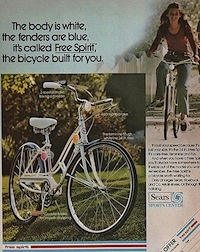 Among the more popular of the Steyr-made bicycle models imported to the USA by Sears between the late 1960's and into the mid 1970's was the upright Free Spirit model; this too was available in a variety of sizes and in a choice of either a conventional or women's frame. The Free Spirit is among those models that may be found either bearing the 'Sears Made In Austria' or the 'Ted Williams' head badge label. Offered in a 3 speed configuration late in the 1960's, by 1973 the Free Spirit was also made in a 10 speed configuration advertised as the “10-speed. It gets you there."
Among the more popular of the Steyr-made bicycle models imported to the USA by Sears between the late 1960's and into the mid 1970's was the upright Free Spirit model; this too was available in a variety of sizes and in a choice of either a conventional or women's frame. The Free Spirit is among those models that may be found either bearing the 'Sears Made In Austria' or the 'Ted Williams' head badge label. Offered in a 3 speed configuration late in the 1960's, by 1973 the Free Spirit was also made in a 10 speed configuration advertised as the “10-speed. It gets you there."
Right: Sears 'Free Spirit' 10 speed bicycle magazine advertisement from late 1973 featuring the women's model, and offering a free jacket patch.
Click on image to see a readable enlarged view, then click on enlarged image to scale it up to full size (411,481 bytes).
I have been informed the handle bar end plugs on the Free Spirit bicycles of that era read “Puch” however, the mandatory “Made in Austria” tags were often peeled off by the employees who assembled the bicycles at the Sears retail stores.
As 1970 approached the bicycle component manufacturing companies in Japan, most notably Shimano and Suntour, were developing improved and more elegantly finished components. While fewer and fewer components of the entry to mid-level bicycles being assembled in Austria by Steyr bore the Steyr or Styria trademarks. The trend was towards incorporating the asian-made components that were as good or better than the european components, and that cost Steyr less to source.
By 1966 BMX ('bicycle motorcross') models for off road use had entered the line-up too, so at the turn of the 1970's the Steyr-Daimler-Puch company was marketing entry level road and BMX bicycles. Each Steyr or Puch trademarked bicycle frame was being manufactured and assembled at Werk Graz-Thondorf, the Steyr-Daimler-Puch factory in Graz, Austria. By then the bicycles were being marketed on several continents and under one or more of the company brand names simultaneously: Steyr-Daimler-Puch, and Puch. To facilitate distribution they set up companies in several countries; for example sales and service in the United Kingdom were managed by Steyr-Daimler-Puch (Great Britain) Ltd., at Steyr-Puch House, 211 Lower Parliament Street in Nottingham.
The Puch branded bicycles was initially reserved for frames sold in Austria or exported for sale in other European countries (Germany, France, England, etc.). The Puch branded offerings also included BMX models sold in Europe and destined for sale in the USA.

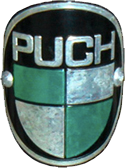 The Booming 1970's And USA Distribution The USA experienced a dramatic bicycle sales boom starting in 1965. This period saw baby boomers children buying bicycles while adult cycling too increased in popularity dramatically. In two years around 1970 bicycles sales doubled nationwide. The Time Magazine issue of 14 June 1971 referred to this as "the bicycle's biggest wave of popularity in its 154-year history" By May 1971 Schwinn, the largest manufacturer, had sold all its planned production for the year!
The Booming 1970's And USA Distribution The USA experienced a dramatic bicycle sales boom starting in 1965. This period saw baby boomers children buying bicycles while adult cycling too increased in popularity dramatically. In two years around 1970 bicycles sales doubled nationwide. The Time Magazine issue of 14 June 1971 referred to this as "the bicycle's biggest wave of popularity in its 154-year history" By May 1971 Schwinn, the largest manufacturer, had sold all its planned production for the year!
Right: Embossed aluminum head badge of a Puch bicycle that was riveted onto the Head Tube, probably built about 1970 (100,159 bytes).
The upsurge in bicycle sales from 1965 and into the early 1970's prompted the consortium to consider the production of mid and upper level bicycles, more sophisticated than those that had been their hallmark. The Arab Oil Embargo of October 1973 to March 1974 persuaded Steyr-Daimler-Puch management they might have a much larger market for their products in the USA, and so the Steyr-Daimler-Puch of America Corporation (SDPA) was established in Greenwich, Connecticut to manage the representation of their product lines and to provide constructive feedback to Austria. The importation and distribution of their products (including Mopeds, bicycles, and of Steyr firearms) in the USA was to commence from locations in Secaucus, New Jersey and in Jacksonville, Florida.
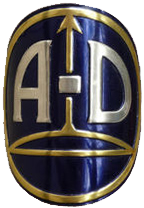 The bicycle product line would be marketed under the trade name “Austro-Daimler”, this trade name was or would also be used in other english-speaking countries including the United Kingdom. Sales in most of Europe and other markets continued under the 'Puch' trade name. For most consumers the expectations were high when buying a bike associated with those great Austrian and German names!
The bicycle product line would be marketed under the trade name “Austro-Daimler”, this trade name was or would also be used in other english-speaking countries including the United Kingdom. Sales in most of Europe and other markets continued under the 'Puch' trade name. For most consumers the expectations were high when buying a bike associated with those great Austrian and German names!
Left: Embossed aluminum head badge of a Austro-Daimler bicycle, probably as built about 1980 (123,228 bytes).
In order to better negotiate the complicated US marketplace and improve their offerings for the European market too, Steyr-Daimler-Puch America explored developing relationships with established bicycle distributors in the USA. First and foremost in their minds was Lifecycle, Inc., a well regarded and proved cycling retailer and distributor then located at 1005 Massachusetts Avenue, in Cambridge, Massachusetts. The proximity of Lifecycle to the Steyr-Daimler-Puch offices in Greenwich, Connecticut added the benefit of convenience. Lifecycle distributed products to some 125 bicycle retail shops throughout New England and in California.
Lifecycle was founded by the late Eugene (Gene) Ritvo and Thomas Manning, the company integrated a highly experienced team of technical and sales people. Among their many kudos Lifecycle had over many years developed a special relationship, beyond that of a typical regional distributor, with Fuji America based in New York City. Lifecycle helped to make the Nichebei Fuji group product an acclaimed and financially successful line - the first such Japanese bicycle manufacturer success story in the USA. Up to then imported bicycles were usually entry to mid level models marketed under westernized names, or made for American manufacturers to distribute under their own names. Fuji's business strategy differed, this was the brainchild of Ken Mizugaki, President of Fuji USA and a graduate of Reed College in the States. He and his closest, loyal, and competent associates (Ken Moriya, Yoshi Kitazumi, Katz Nishimura, Maury Shitanisi) stuck with their business plan to develop a premium line of bicycles and components made in Japan and retaining their Japanese identity, even while taking ridicule from fellow importers and distributors. The durable high tensile steel frames were built with components by makers including: Dia-Comp, Sun Tour, Nitto, Pearlizumi, Shimano, Silver Star, Sugino whose items were clearly identified. Gene had been so instrumental at improving the Fuji line by helping to determine production frame sizes, frame angles, tubing choice, and component groups that to this day he is considered by many to be the father of the Fuji line in the United States. By the early 1970's Consumer Reports magazine's “Best Buy” pick was the Special Road Racer, though the bike Fuji became best known for was the later version designated the S10-S, a high tensile steel alloy framed (27 lb.) ten-speed road touring bicycle introduced in 1971 then selling for about $210. The successes eventually earned for the Fuji trademark the cache of Sony, Nikon, Seiko and the like. Lifecycle had a display wall lined with wonderful bikes by makers including: Masi, Cilo, Cinelli, Bob Jackson, Harry Quinn, Colnago, Fisher, Mooney, Merckx, Paramount, Teledyne Titan and several other state of the art frames for that 70's into the 80's era. Among the newcomers was Gary Klein, an MIT student who retailed his first Klein bicycles with boron-reinforced aluminum frames through Lifecycle. So the credentials of the team at Lifecycle were obvious.
Steyr-Daimler-Puch America representatives arranged an introductory meeting with the principals of Lifecycle. Those attending included Lifecycle founders Gene and Tom Manning, and Warren Koebler who has as much knowledge about bicycles, design, and cycle trivia as anyone in the business. Attending representatives of Steyr-Daimler-Puch included Robert Yung a Chinese American marketing fellow here by way of Brazil, Helmut Quindt from Graz who was technically knowledgeable and represented the manufacturing side of Steyr-Daimler-Puch, and Silvio Simon an advertising specialist from France. The meeting conveyed how Steyr-Daimler-Puch of Austria intended to develop a new product line of bicycles with the better components, more upscale than those they were known to have manufactured up that time. These bicycles would bear the Austro-Daimler tradename and continue within the production serial number sequence* already in effect at the factory, hence there was nothing in the serial number to distinguish a Puch frame from one to be marketed as Austro-Daimler; these new bicycles were to be seen as among the best that Europe could offer. In time there would be Puch trademarked road bikes, these offerings were to represent the lower priced offerings of the maker. While there was some some minor overlap of the features between the trademarks road bikes.
*There is helpful resource of Austro-Daimler bicycle production Serial Number data at http://www.classicrendezvous.com/Austria/AD\_serial\_numbers.htm. However, the information in the tables is provided by customers who tend to list the year of purchase (as best they can recollect) and that does not necessarily reflect when the frame was made since the bicycle frame could have been in store stock for some years prior to first being sold.
It had been decades since a product had borne the Austro-Daimler trade name, but by 1975 bicycles bearing that name were starting to be noticed among cycling circles:

They put forth a proposal to Lifecycle that focused on developing a presence and sales strategy for the US market. Lifecycle would exclusively distribute the line in the USA to retailers, and would also retail the Austro-Daimler and Puch lines directly to their clientele. The product line would be initially launched in New England because of its perceived affluence and existing strong bike market. If the business worked out well in New England then they would expand nationally.
Lifecycle signed a three year contract with Steyr-Daimler-Puch USA to conduct sales, marketing, and perform design consulting work then commenced their work. The team at Lifecycle actually specified the entire Austro-Daimler line, even down to the then unique custom-cut foam packing. They proposed frame designs (tubing choice, lugs, frame angles, etc.) with the desired frame component lists, and made suggestions for models to be offered to suit the various price points and their intended customers. Gene Ritvo was almost fanatical about paint quality and through his input the Fuji finishes were applied electro-statically and became regarded as being among the best in the industry. Gene might spend weeks agonizing over getting just the right shade of color or component choices for new models. A great deal of credit should also go to Warren Koebler, an associate at Lifecycle, for his work in choosing group components and his love of the minutiae in specifying a bike model; Warren is still in the bicycle business working with Belmont Wheelworks. The Lifecycle team with Gene in particular put heart and soul into this design effort, they helped to bring Steyr-Daimler-Puch bicycle design into the modern age.
By 1976 the Puch branded bicycle models were represented as being sold by Steyr-Daimler-Puch America Corporation. While to better differentiate the intended upscale brand, their Austro-Daimler Division was listed as managing distribution of the AD brand bicycles through “fine professional bicycle shops”. Both brands shared the same office and their mailing address was Box 7777, Greenwich 06830. Each brand, Austro-Daimler and Puch too, had their own independent advertisements that did not mention the other brand. We observe the AD bicycle advertisements of this era generally were less wordy but succinct, more intent on conveying a feeling or sense of engineering than the Puch bicycle advertisements. Puch ads tended to have a catch phrase, early on they featured “Puch, As Far As You Can Go On A Bicycle”, followed by several paragraphs of comments.
Right: Austro-Daimler Division, Steyr-Daimler-Puch America Corporation “A Philosophy in Engineering” advertisement in December 1976 Bicycling magazine.
Click on image to see a readable enlarged view, then click on enlarged image to scale it up to full size (386,980 bytes).
The handout literature of the Austro-Daimler bicycle line too was simply elegant, well beyond what most other bicycle brands distributed. The AD product line catalogs were upscale with more of an artistic layout, printed on pages of thick stock with them separated by removable spacer tissue sheet. The presentation was so impressive that it might inspire even the uninformed to be willing to pay more for an AD product, but as it turned out these bicycles would stand on their own in terms of engineering and features.
In terms of engineering, as mentioned above the developing lines were not all in the hands of Austria. As one of the persons who was then with the Lifecycle company related:
"As I recall they (the Steyr-Daimler-Puch people) did not have a clue as to how to create stable frames and alter the frames to shorten wheelbases on different models. They only made frames using one set of angles and their wheelbases were quite long and unwieldy. The Fuji 'Dynamic' would have been seen as a criterium bike by them. They needed their hand held big time."
After that good deal of forethought and preparation at Lifecycle, Gene Ritvo made the first of several trips to Graz, Austria to discuss these matters directly with production management and technicians. Gene also had in hand his big passion: color charts. Gene was proudest of development of the Ultima, their top line model originally finished in a red termed “Bordeaux Red” then later in the distinctive purple aubergine color, the Super leicht (super light) model, the unprecedented all black Vent Noir with black finished components that was later followed by the lustrous smoked chrome Vent Noir II (sometimes marketed as the Vent Noir). Several of the suggestions by Lifecycle were also rolled over by Steyr-Daimler-Puch into a then undisclosed, overlapping line of Puch brand bike models.
The Austro-Daimler bicycles models shared a fairly standardized geometry but differed in several ways. These differences involve the selection of frame materials (tube alloy or steel for example), construction hardware and techniques including choice of frame coupling hardware and brazing technique and materials (silver brazing for example), Gruppo or group of components selected by make and degree of sophistication, finishing work such as hand painted trim and including type of seat and handlebar grip material.
The top of the line Austro-Daimler bicycle was marketed as the Ultima series. These are built upon a TI Reynolds 531 (pronounced “five three one") alloy lugged frame with premium lighter weight Campagnolo Super Record series components. Later in the production history the "ULTIMA super leicht" were introduced. These "ULTIMA super leicht" have been seen bearing the AD head badge and with the “AUSTRO-DAIMLER” decal on the down tube, though later production models will bear the PUCH head badge and top stay tips with the round STEYR decal on the seat tube and the “AUSTRO-DAIMLER” decal on the down tube. These SL models were made with the Reynolds 531 Special Lightweight alloy marketed as “531 SL”, with tube walls as thick or thicker than the standard 531. Some were made with the “531 SL Professional” (or 531 Professional) tube sets, with walls as thin as the standard 531 tubes but of the same lightweight alloy as the 531 SL. While a standard 531 frame set might weigh about 2200 grams, a similar size 531 SL frame set will weigh about 1990 grams; a weight savings of about 10 percent. The 531 Professional frame weighs even less averaging 1900 grams, about 5 percent less than the 531 SL. The 531 SL Professional were so optimized for racing that these may not be as practical for heavier riders or for those frequenting rough pavements or paths.
By 1977 the product line-up published by Steyr-Daimler-Puch of America Corporation was:
| Model | Frame | Suggested Retail Price |
|---|---|---|
| Ultima | Reynolds 531 DB | $1,275.00 |
| Super leicht | Reynolds 531 DB | $875.00 |
| Vent Noir | Reynolds 531 DB | $575.00 |
| Inter 10 | Reynolds 531 DB | $350.00 |
| AD-SL | 3 tubes of Reynolds 531 DB | $250.00 |
| AD-S | AD Special Steel | $185.00 |
By 1978 the Ultima incorporated: full titanium Super Record group (including their rare recently revised rear Derailleur), Campagnolo Horizontal Dropouts and the Fork Tips, a Regina Oro chain and sprocket, lightweight Fiamme Ergal polished 7075 aluminum 700c tubular racing rims (averaging 296 g each), a taped Cinelli Bar and with a Cinelli Stem, and with a Unicanitior Model 3 Saddle.
Left: The Ultima in Thondorf-Purple, the bicycle that put Austro-Daimler on the radar (32,980 bytes).
Click on image to see enlarged view (199,428 bytes)
The Ultima frame was offered in a dark purple metallic color advertised as “Thondorf-Purple”, referring to Werk Graz-Thondorf the factory where the frames were made, with gold painted trim. In Europe too the Ultima were marketed under the Steyr-Daimler-Puch trademark bearing the model label "ULTIMA", also finished in Thondorf-Purple. In 1978 the frame was also made available in Amethyst, a metallic silver-light lavender color and with black painted trim. In later years other color choices were added including Green and Burgundy. The retail price of the 1977 Ultima was a then whopping 1,275thoughtheymightbehadaslateasin1981forabout1,275 though they might be had as late as in 1981 for about 1,275thoughtheymightbehadaslateasin1981forabout1,600 new. Regardless of the cost, the Ultima appealed to that segment of the market that demanded the lightest (about 19.5 lbs. complete) and the finest regardless of cost.
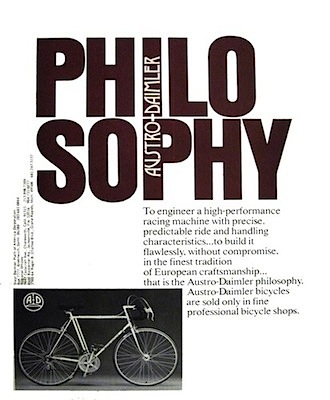 Great care was taken to present the product line as something special and elegant:
Great care was taken to present the product line as something special and elegant:
- Special models with groups competing in the high end Ultima, to elegant frames with unique finishes and trim (Vent Noir and Vent Noir II) were offered. It was Gene who determined the Ultima frames were to be the finished in the purple aubergine color paint; he stood firm on its appropriateness for what became their top end model.
- Some of the Austro-Daimler bicycles were so well regarded that they were successfully raced by some US Olympic and National Team members. Steyr-Daimler-Puch became active in bicycle racing developing a 531 frame they called the Team, this would be the basis of several production bicycle models including the Ultima. This added additional credibility to the product line; the advertising by the company took note of this.
- Commencing by 1975, the printed catalogs of the Austro-Daimler line (do you recall when free printed catalogs were the norm?) were among the most elegant bicycle catalogs ever distributed. The entire catalog focused solely on their five premium bicycle models. The catalog showed large lustrous color photos of the products, assembly, and with tissue paper between each of the pages.
- Up to this time bicycles were usually shipped packed simply within a narrow cardboard box, with some padding attached to the frame here or there, and maybe with some styrofoam blocks within the carton. But for an Austro-Daimler even the packing of the bicycle was well thought out and elegant, both to provide a good presentation as well as to insure damage free delivery to the retailers and customers. The bicycles were shipped from the factory nearly fully assembled nested in a custom-cut foam packing and within an outer carton. The foam insert was cut to accommodate each of the respective size frames and often fabric lined to reduce risks of abrasion.
- By 1978 Austro-Daimler literature made claims of some bicycles being 'All-European' indicating the frames and all their components originated in Europe and no doubt adding some snob appeal to the equation.
Right The Austro-Daimler Philosophy magazine advertisement of 1977 portraying the goal of developing this as an upscale and competitive line (41,848 bytes).
Click on image to see enlarged view (251,996 bytes)
There were initially glitches with some designs and production aspects of these new and more advanced frames, among them was a full size range of bikes all sporting the same length top tube. There are some early production frames with rough or obvious filing marks, most notably the underside of the Bottom Bracket. All of these matters were gradually worked out.
There have been some comments made about the durability of some components such as the often misunderstood lightweight (c. 290g each) Fiamme Ergal tubular rims; these are superb in racing but are not the most durable choice for casual riding along uneven surfaces as are typically encountered by the casual rider. The term 'Tubular Rim' refers to the arrangement whereby the tire is sewn-up then glued onto the tim; this is not the easy to repair tire and inner tube set as are installed onto the more common 'Clincher Rim'. The tubular rim was preferred until recent years over the clincher rim, particularly among racers who run on smooth clean surfaces, because the tubular rim with tire weigh less than the clincher set. The tubular tire could (at the time) operate at higher pressures of up to 200 psi than a comparable clincher set at up to 150 psi, thus providing less rolling resistance. With less weight there is less rotational inertia on the wheel, and so a bicyclist riding on tubular rim and tire can accelerate faster and or with less effort than with a typical clincher. Of course in casual riding the benefits of light weight are offset by the need to carry a spare tubular tire, instead of the simple patch kit to repair the inner tube of a clincher rim.
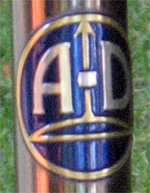 Gene was quite an interesting and talented fellow, one of the later tales tells something of the man Gene was a guy who was witnessed at the Pebble Beach Concours saying to Ralph Lauren himself who was dressed in bright yellow and yellow and white plaid ..."Good Grief..... who dressed you today?" In appreciation of the work by Gene Ritvo the team at Steyr-Daimler-Puch presented to him a new Ultima super leicht bicycle painted in red complete with Campagnolo Fork Tips and Dropouts, Bocama Lugs - two of which are chromed, and all Campagnolo Super Record components including a first generation Super Record titanium rear Derailleur. The frame features Mr. Ritvo's initials “ER" painted in gold Austro-Daimler “Auriol” font style on the seat tube. Incidentally, the photos in the 1976 ULTIMA catalog pages through those of the 1978 catalog actually show this exact bicycle bearing the ULTIMA super leicht label. This is even though the 1978 specifications and the smaller insert photo of the cased ULTIMA Super leicht indicate it was then only available in Thondorf-Purple. This bicycle survived him in good condition, it is presently in the capable and appreciative hands of Scott Ryder, whom I thank for the help in filling in some details here.
Gene was quite an interesting and talented fellow, one of the later tales tells something of the man Gene was a guy who was witnessed at the Pebble Beach Concours saying to Ralph Lauren himself who was dressed in bright yellow and yellow and white plaid ..."Good Grief..... who dressed you today?" In appreciation of the work by Gene Ritvo the team at Steyr-Daimler-Puch presented to him a new Ultima super leicht bicycle painted in red complete with Campagnolo Fork Tips and Dropouts, Bocama Lugs - two of which are chromed, and all Campagnolo Super Record components including a first generation Super Record titanium rear Derailleur. The frame features Mr. Ritvo's initials “ER" painted in gold Austro-Daimler “Auriol” font style on the seat tube. Incidentally, the photos in the 1976 ULTIMA catalog pages through those of the 1978 catalog actually show this exact bicycle bearing the ULTIMA super leicht label. This is even though the 1978 specifications and the smaller insert photo of the cased ULTIMA Super leicht indicate it was then only available in Thondorf-Purple. This bicycle survived him in good condition, it is presently in the capable and appreciative hands of Scott Ryder, whom I thank for the help in filling in some details here.
Left: Embossed aluminum head badge on the author's Austro-Daimler Vent Noir II (18,250 bytes).
By 1977 Steyr Daimler Puch of America Corporation listed these addresses and telephone numbers in their advertisements such as in their “_Philosophy_” ad shown above:
- Box 777, Greenwich, Conn. 06380, phone 203-661-0864 Regional Offices:
- 9642 Cozycroft Ave., Chatsworth, Calif. 91311, phone 213-998-7309
- 8500 Baycenter Rd., Jacksonville, Fla. 32216, phone 904-731-0277
- 3560-64 Roger B. Chaffee Blvd., Grand Rapids, Mich. 49508, phone 661-247-3737
Steyr-Daimler-Puch America opened a store in Greenwich, Connecticut that was then a rather unique concept: a flagship single-brand store for the Austro-Daimler bicycles. The original bicycle shop on the site was owned by Chet Ribner and Rob Feldon, they negotiated the arrangement to convert their own store to a purpose built operation laid out to impress the visitor and feature solely the Austro-Daimler bicycles and accessories. As related "it had AD logo wallpaper etc and was quite an operation, boutiquey and rather snotty in nature... so Greenwich!" In time Rob Feldon ended up going to work in China to establish sources for the production of Puch brand bicycles. At this time Schwinn Bicycle Company was the dominant manufacturer of bicycles in the USA. Taiwan based Giant Manufacturing Co. Ltd. was manufacturing Schwinn-labeled outsourced bikes, often bearing the label Schwinn Approved. Sales to Schwinn represented almost all (ninety percent or more) of Giant's production. In 1979, Edward R. Schwinn Jr., became President of the Schwinn company then made Giant's owners uneasy as Schwinn attempted to have their bikes sourced at even lower cost from either eastern Europe or mainland China. By 1986 the Giant company decided to become self-reliant, dropping the relationship with Schwinn and instead marketing under their own trade name. Chet Ribner went to work for Giant, then became President of Giant in the US; this ended the ability of the Steyr-Daimler-Puch showroom in Greenwich to survive. Giant Manufacturing Co. Ltd. went on to become one of if not the world's largest bicycle manufacturer with facilities in Taiwan, The Netherlands, and China.
Their experience in the defense industry crossed over and in 1978 Puch designed the world's first carbon-frame bicycle. The Austro-Daimler trademark was reserved for bicycles sold in the US market, hence those competing as an American market mens team rode 'A-D' labeled frames - usually the 'Ultima' model. While Puch was the label of frames sold in Europe, and for those competing as the European market team and for the American Women's team. I have seen Austro-Daimler team racing advertisements, and have seen their tasteful jerseys from 1976 and from 1977.
The Late 1970's, Early 1980's As mentioned previously, the USA experienced a dramatic bicycle sales boom starting in 1965 and cresting by 1975. The period was followed by a sudden decline in sales as the market became saturated by competitors and clogged with large inventories of unsold bicycles. This was unfortunate for bicycle makers, particularly those trying to become established in the US market including Austro-Daimler and Puch brands.
As if the slowing sales overall in the highly competitive bicycle market was not enough, by 1976 the American consumer had forgot the oil crisis and became acclimated to the higher fuel prices. So they resumed favoring larger and less fuel efficient vehicles. Most of those Americans who would ever opt for a motorized two-wheeler shunned the Puch Mopeds (still popular in Europe) and other similar vehicles in favor of full sized motorcycles. As a result of this the sales of Puch Mopeds in the USA never really got off the ground. The Moped distributor for Puch was a company based in upstate New York that dealt with the sales of snowmobiles and farm equipment. This was a capable and successful company in those fields, but their sales of motorized wheeled goods reflected the Moped market in the USA - dismal. Not long after picking up the Puch Moped distributorship they concluded this would not work for then, so they liquidated their existing inventory and got out of the Moped business altogether.
By the late 1970's the remaining operators of Lifecycle agreed to continue distributing the Austro-Daimler line even in the face of the market slowdown, some changes of staff, and increasing number of new manufacturers from overseas competing for the US bicycle market. In 1977 Steyr-Daimler-Puch bicycle production serial numbers passed 5800000 (some Puch labeled bicycles still bearing the 100 Years anniversary decal), but in light of slowing sales the company sought ways to remain competitive and pursue the lower priced market areas. Lifecycle would also continue to retail (sell directly to customers) the line as well as remain involved with the design, specifications, and other decision making. This slowed the rate of sales declines and had some convinced that things would improve so to meet the anticipated growing demand Steyr-Daimler-Puch ramped up employment and production; their quantitative peak was attained in 1980 when their more than 3,200 employees produced 310,000 bicycles.
Steyr-Daimler-Puch in Austria continued to produce bicycles based on their own designs that were old, but yet marketable particularly in Europe. Consider the single-speed 1939 bicycle (SN 481104) trade-marked 'Johann Puch AG' bearing the painted 'JPAG' head badge plate, alongside a similarly single-speed made about 1980 Puch Elegance. Shown here are versions made to accommodate women for easier comparison of the similarities of: frame geometry, spring-loaded saddle (seat), design and location of the thumb bell, headlamp, and even down to the Bosch brand of DC power generating sidewall dynamo. Sometimes termed Bottle Dynamo owing to their resemblance to a bottle, later models are typically a low-power magneto that produce AC:
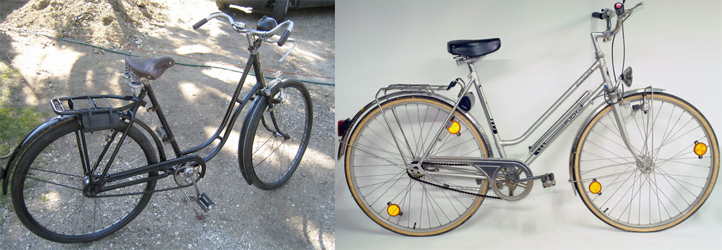
Arguably the most refined decades-old bicycle technology still in production!
I would guess that by this time Steyr-Daimler-Puch in Graz was ramping up their interest in making this effort a success, and if they did not already have the engineers on staff with bicycle design or materials knowledge when they started this new effort then they were certainly hiring them. Rudolf Resch was an engineer and Chief Designer, while Franz Volk could become Chief Production Manager; their faces and promises appeared in the factory literature. So if SDP needed hand-holding, then I expect this would not be the case for long. That said, their marketing team know how certainly was lacking and remained lacking throughout the term of their efforts into the mid 1980's. The Steyr-Daimler-Puch bicycle product labeling and differentiation is about as confusing as that which any maker has ever attempted:
- How can one know for certain what made this or that model superior to another for one use or another? In part the confusion because the model names and components seemed to change from year to year: Ultima or Ultima super leicht, SL or super leicht?,
- models names were used over and over again that confused buyers: Vent Noir, Vent Noir II, Mistral Vent Noir II - it is hard to tell them apart since the literature confused them and at times even the frame labeling was confusing too! This is all before considering two identically equipped bicycles might bear different model names when marketed under the AD and Puch trademarks.
- errors in the catalogs and literature were numerous, even if minor. For examples:
* I note with amusement the 'All European' mention for some bicycles in 1978 literature even though the specs indicate they incorporated Shimano (Japanese) Horizontal Dropouts and Fork Tips.
* The catalog sheets showing a photo of a bicycle in Bordeaux Red while the specifications indicate it is only made in Thondorf-Purple.
* So was the customer saving to buy the all-black Vent Noir or the smoked chrome Vent Noir II either that could be listed in a catalog as the Vent Noir?
I term these “mismanagement alerts"; read on to learn more about this.
Steyr-Daimler-Puch headquarters decided to source some of their new bicycles from factories overseas so that they could offer these to the customer for a cost lower than those made in Austria. These third party sources were initially in Japan and in Taiwan. One may come across one of these contracted bicycles from Asia bearing a “PUCH” head badge but with smaller letters “MADE FOR” over the Puch name.
Some miscommunications apparently developed between the managements of Lifecycle and Steyr-Daimler-Puch. Lifecycle understood the new lower priced bicycles would bear the Puch name, and this would help to round out their market offerings. Lifecycle had worked diligently to present the Austro-Daimler trademark as representative of upper crust European fare; for their strategy to work there could be no overlap with Puch - no models even remotely competitive to those bearing the Austro-Daimler trademarks. When the first shipment of these lower priced bicycles arrived at Lifecycle the staff observed an additional load of bicycle cartons labeled 'PUCH' that bore several different model names on the cartons. Upon inspecting the shipment it became clear these Puch models had indeed overlapped most of the Austro-Daimler models, with some of the Puch models costing well over the $1,000 retail price point. This was perceived by Lifecycle as a complete violation of the design and consultantcy agreement. There was likely more to the dynamics of this story than I know, but it appears this episode exacerbated the issue of already compromised trust, and the value Lifecycle had placed in Steyr-Daimler-Puch as a venture partner ended. Lifecycle withdrew almost immediately as the distributor for the new Austro-Daimler line. With that break Steyr-Daimler-Puch America lost access to the better retailers in New England, and became deprived of American consumer based design advice.
The Puch overlap with Austro-Daimler progressed so that Puch too would also offer some very fine road models in the USA, with some noteworthy competitive teams riding Puch trademarked frames. This complicated the matter of discriminating between their own competing trademarks: time here for another 'mismanagement alert'. Steyr-Daimler-Puch America found out the idea to parallel Puch and Austro-Daimler was confusing customers, and wasteful of advertising to get the message across. Added to that, the choice by Steyr-Daimler-Puch America of a new bicycle distributor, replacing Lifecycle, was a disaster; the new distributor charged high storage fees, became slow to pay, and did not even approach the overly optimistic predictions for sales volume they promised. Eventually Steyr-Daimler-Puch America parted with that distributor, then called again upon Lifecycle to at least help repatriate their US inventory from the new distributor and into lower cost storage. But Lifecycle declined to go any further with the relationship than that.
Steyr-Daimler-Puch America Corporation proceeded to establish distribution relationships directly with retailers, in some regions hiring a local District Sales Manager to aid their efforts to market the bicycles and mopeds. By the Summer of 1977 John B. Cellier was their Director of Operations. As their point of contact for the bicycle stores, Cellier was also referring customers who inquired to their nearest retailer. The beautiful Austro-Daimler sales literature, advertisements, and the recognition brought by an increasing number of competitive bicyclists riding the Austro-Daimler and Puch bikes helped to attract even more of those specialty bicycle shops that catered to the more demanding cyclist to contact Steyr-Daimler-Puch America Corp.. But ironically, while Steyr-Daimler-Puch America was trying to nurture relationships with bicycle stores, SDP America also sold bicycles directly to the consumer; I have seen sales receipts from 1980 written at Steyr-Daimler-Puch America in Greenwich - earning them yet another 'mismanagement alert'. I purchased my Vent Noir II in 1981 from College Park Bicycles in Maryland, though my bicycle frame serial number indicates it was most likely made in 1978; this is part of the problem in dating production since a bike could have been in stock at a dealer for years before being sold.
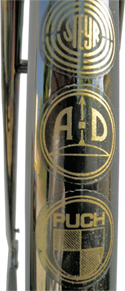 By the Spring of 1980 Steyr-Daimler-Puch contracted Speed Unlimited (Thruster) of Wayne, New Jersey to manufacture a new BMX bicycle, the Puch Trak/Pro. These bicycles are constructed of a chromed chrome-moly frame, and bear a standard “PUCH” head badge. The overall lack of success of Puch in the BMX market had more to do with management and distribution issues than their technology.
By the Spring of 1980 Steyr-Daimler-Puch contracted Speed Unlimited (Thruster) of Wayne, New Jersey to manufacture a new BMX bicycle, the Puch Trak/Pro. These bicycles are constructed of a chromed chrome-moly frame, and bear a standard “PUCH” head badge. The overall lack of success of Puch in the BMX market had more to do with management and distribution issues than their technology.
Right: 1982 or later production model Vent Noir II frame with “Steyr Austro-Daimler Puch” decal on the seat tube. With less hand painted trim this frame is not finished as elaborately as its predecessors. The frame downtube bears the decal “Made by Puch AUSTRO-DAIMLER”. As sold in Europe at the time under the Puch trade name this too bears a metal Puch head badge, this is embossed and then painted but in a simpler manner than the one shown earlier in this article (170,122 bytes).
When Sears transitioned production of the Free Spirit and other models of bicycles to be made in Japan and Taiwan instead of by Steyr-Daimler-Puch, this was another notable loss of revenue for Steyr-Daimler-Puch. I have read one account "Within three years (of terminating the original agreement with Lifecycle) SDP USA losses were in the $24,000,000 range and Austria pulled the plug on it altogether."
Back in Austria there were some efforts to make the available bicycle line more diversified in terms of choices, and in terms of pricing too. Up to about this time the manufacture of most Puch and all Austro-Daimler road bicycles had remained at Graz in Austria, these were assembled with a mix of European and Asian components. The better frames incorporated more costly components including: Bocama Lugs (and possibly Bocama-made Fork Crown and Bottom Bracket Shell), Campagnolo, Cinelli, Fiamme, Regina, T.I. Reynolds, and Rigida.
Tthe lower priced Puch and Austro-Daimler bicycles incorporated durable but less costly components made mostly by established European makers including: Weinmann, Sachs (founded in 1895 in Schweinfurt, the bicycle components portion of the company was acquired in 1997 by Chicago-based SRAM corporation), Friko (Fritz Koerdt Metallwaren-Fabrik), Rigida, Selle Royal, Simplex Alpha, Stronglight (brand name introduced by Verrot Perrin of Saint Etienne, France in 1933 manufacturing cranks and other components), Normandy Competition (hubs made in France), and Spidel (trade name used from the late 1970's to the early 1980's by an alliance of French parts makers).
Some components making up the mid to lower priced bicycles were sourced from Japan. These included components bearing the trade names: Shimano, MKS (Quill 2K pedals for example), SR (Sakae Ringyo Ltd.), and Suntour. These were well regarded makers even then and their components were not on the cutting edge of design and materials and they lacked snob-appeal, these components were reliable and wholly satisfactory for use by their intended clientele.
The desire by management to offer less costly bicycles in the product line resulted in negotiations with Japanese makers to outsource production of some road bicycles in order to be more competitive in the lower-priced areas of the market. The manufacture of some complete Puch bicycle models, including the durable Pacifica for example, were shifted from being made in Austria to Japan to be marketed as the Pathfinder that was made under contract by Araya Industrial Company. Other Puch models were outsourced to Kuwahara Company of Japan; the company is better known for making BMX bikes marketed under their own name including the forty red and white KZ frame model bikes made famous in the 1982 Steven Spielberg movie E.T.
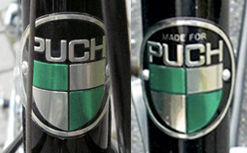 To see how the outsourcing resulted in specification and gruppo changes consider the Pathfinder bicycles, those made in Austria through 1979 were of frames made from 2600 manganese steel alloy tubing and with a mix of European and Asian components. The bicycles made for Puch in Japan were based on a frame made of fairly heavy but stiff Araya Hi Tn (sometimes termed 'Hi-Ten', short for 'high tensile') steel butted tubing, and with components made in Japan including those by Araya, Diacompe, KKT, Nitto, Sugino, and Suntour 7-GT. Some other models including the Odyssey similarly incorporated Japanese made components. These bicycles were priced lower than the models being made in Austria, for example the <ahref="javascript:popup('.. bosendorfer="" graphics="" puch_pathfinder_left745537.jpg','745','537')"="">Pathfinder Series 1</ahref="javascript:popup('..> bicycle made by Araya between 1980 (or earlier) through 1983 sold new for about $200.00. These contracted bicycles frames will bear the PUCH head badge and decals, but also bear the decal MADE IN JAPAN, and a Serial Number beginning with 'ARYGxxxxxx'.
To see how the outsourcing resulted in specification and gruppo changes consider the Pathfinder bicycles, those made in Austria through 1979 were of frames made from 2600 manganese steel alloy tubing and with a mix of European and Asian components. The bicycles made for Puch in Japan were based on a frame made of fairly heavy but stiff Araya Hi Tn (sometimes termed 'Hi-Ten', short for 'high tensile') steel butted tubing, and with components made in Japan including those by Araya, Diacompe, KKT, Nitto, Sugino, and Suntour 7-GT. Some other models including the Odyssey similarly incorporated Japanese made components. These bicycles were priced lower than the models being made in Austria, for example the <ahref="javascript:popup('.. bosendorfer="" graphics="" puch_pathfinder_left745537.jpg','745','537')"="">Pathfinder Series 1</ahref="javascript:popup('..> bicycle made by Araya between 1980 (or earlier) through 1983 sold new for about $200.00. These contracted bicycles frames will bear the PUCH head badge and decals, but also bear the decal MADE IN JAPAN, and a Serial Number beginning with 'ARYGxxxxxx'.
Left: Head badges of 1980's Japanese made bicycles. At left is one from about 1980 Pathfinder made by Araya bearing PUCH, while at right is the MADE FOR PUCH head badge of a Kuwahara-made Model 190 from about 1986 (29,385 bytes). Note how these outsourced frames both feature riveted-on metal plates, not the cheaper stick-on label sometimes found on Puch and Austro-Daimler bicycles made in Austria.
A Budding Race Tradition Since 1977 Steyr-Daimler-Puch had been sponsoring bicycle racers, some who attained prominence riding their Austro-Daimler or Puch trademarked frames. In Europe all Steyr-Daimler-Puch bicycle factory sponsored riders rode the Team or Ultima frame, finished in Puch green and with Puch decaling. The plan by Steyr-Daimler-Puch America was to have male athletes ride Austro-Daimler Team frames, with women riding the Puch frames in green. By 1977 four members of the Junior World's Team won on Austro-Daimler or Puch frames.
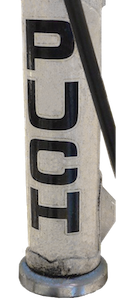 On 2 June 1980 Andrew Teisher Weaver won the Buckeye Race for the Gold (part of Olympic qualifying trials) with a 37:03 time for the 30 Kilometer time trial riding Austro-Daimler. He went on to become a nine-time National Cycling Champion. In 1979 four members of the U.S. Olympic Team and five members of the U.S. National team were riding on Austro-Daimler bicycles. By 1981 they were racking up really notable wins: Winner of the Self Magazine Series, Coor's Classic Women's Individual Winner, Coors Classic Team Winner, National Champion of the Women's Individual Time Trial, and National Champion at the Women's Road Race. Three members of the U.S. Worlds Team rode these frames too.
On 2 June 1980 Andrew Teisher Weaver won the Buckeye Race for the Gold (part of Olympic qualifying trials) with a 37:03 time for the 30 Kilometer time trial riding Austro-Daimler. He went on to become a nine-time National Cycling Champion. In 1979 four members of the U.S. Olympic Team and five members of the U.S. National team were riding on Austro-Daimler bicycles. By 1981 they were racking up really notable wins: Winner of the Self Magazine Series, Coor's Classic Women's Individual Winner, Coors Classic Team Winner, National Champion of the Women's Individual Time Trial, and National Champion at the Women's Road Race. Three members of the U.S. Worlds Team rode these frames too.
Connie Carpenter won riding for Team Puch. She is among the most highly regarded women athletes for her win of the National Road Championship and two-points championships in 1981. She appears prominently in the 1982 Austro-Daimler catalog. She was also the national two-points champion in June 1982, and criterium champion in 1982 and 1983. As reported in the newspapers in the Summer of 1982 "Connie Carpenter was on top of things all the way as she won her second consecutive Coors Classic, the world's longest, toughest -and richest- cycling event for women. Carpenter set a world record of 3:49.53 in winning the 1983 world pursuit championship. The following year, she became the first U.S. cyclist since 1912 to win an Olympic medal. These wins were reflected in the advertising literature as shown below.
Right: Puch head badge as applied towards the end of production. This is on a mid 1980's Mistral model, among the last Puch bicycles made in Austria.
By 1982 a decision was made by Steyr-Daimler-Puch in Austria to unify their overseas bicycle marketing efforts behind the Puch name alone. Puch continued to be the trademark in most European markets, while the brand would be marketed as “Puch Austro-Daimler” in the USA. The last of the production Austro-Daimler bicycle frames of this time bear the Puch head badge and with the decal “Made by Puch AUSTRO-DAIMLER” along the frame downtube. These frames may also bear the “Steyr Austro-Daimler Puch” decal on the Seat Tube as shown several paragraphs above to the right. The more upscale models, including the ULTIMA and ULTIMA SL may still have the “PUCH” letters stamped on the top stay tips. Later production lower to mid range production Puch frames have a simpler stick-on vertical decal “PUCH” applied instead of the formerly embossed metal head badge plate, possibly either a cost cutting or winding down operations decision.
This head badge labeling is not to be confused with some earlier production higher end frames that we build with the stick-on round 'PUCH' or 'A-D' decal applied; these may have been applied if/when the factory simply ran out of the metal embossed head badge. A photograph published in the 23 July 1982 edition of Velonews shows Connie Carpenter winning the 1982 Coors Classic, she is seen just edging out Jeanie Longo; Connie is riding the green Puch frame labeled clearly as such in bold white letters - but that frame has an “A-D” head badge.
Above: Advertisements for Puch Austro-Daimler bicycles, from 1985 (57,205 and 62,605 bytes)
Click on images to see enlarged views (94,762 then 59,559 and 87,409 bytes)
Das Ende of AD In spite of the favorable reviews of the products by 1984 Steyr-Daimler-Puch realized it was becoming more and more difficult to be competitive given their overhead costs. The interest by management in the production of two wheeled vehicles in Austria, even those made for the European market, tapered off as Asian-made products flooded in.
Ironically the Plaza Accord signed on 22 September 1985 between the governments of France, West Germany, Japan, the United States, and the United Kingdom, pushed production from Japan to even lower cost countries. The signatories agreed to depreciate the U.S. dollar in relation to the Japanese Yen and the German Deutsche Mark by intervening in currency markets. The exchange rate value of the US dollar versus the Yen for example declined by 51% from 1985 to 1987. The changing world economics and the slowing sales of bicycles overall at this period was making many manufacturers scramble to find less costly sources of the most economically priced bicycles. While Steyr-Daimler-Puch still had relationships with Japanese factories, other makers were scrambling to sources in Taiwan and elsewhere.
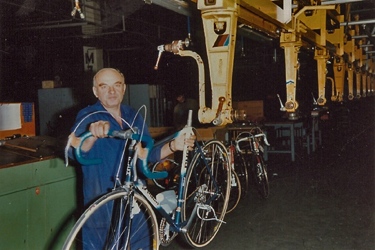 Steyr-Daimler-Puch management decided to focus foremost on the manufacture of cars and larger motor vehicles. So in a decision that is still controversial among those who recall the times Steyr-Daimler-Puch decided to sell the motorcycle, moped, and bicycle fabrication portions of the company. The Puch Austro-Daimler bicycles remained in production at Graz in Austria until the Puch brand name and products of the company were sold in mid 1987 to Piaggio & C. S.p.A. of Italy. This acquisition transferred production of Puch-branded bicycles out of Austria so that the Bianchi-made frames bear the decal "Made In Italy". Piaggio is the holding company for a group of companies that manufacture light vehicles most notably two-wheeled motor scooters including the Vespa motor scooter, motorcycles, and bicycles. After 1987 Piaggio's F.I.V. Edoardo Bianchi S.p.A manufacturing operation included Bianchi, Raleigh (formerly of the United Kingdom), and Puch bicycles. Even as this article is written Araya continues to manufacture bicycles in Japan bearing the formerly British-made Raleigh trademarks.
Steyr-Daimler-Puch management decided to focus foremost on the manufacture of cars and larger motor vehicles. So in a decision that is still controversial among those who recall the times Steyr-Daimler-Puch decided to sell the motorcycle, moped, and bicycle fabrication portions of the company. The Puch Austro-Daimler bicycles remained in production at Graz in Austria until the Puch brand name and products of the company were sold in mid 1987 to Piaggio & C. S.p.A. of Italy. This acquisition transferred production of Puch-branded bicycles out of Austria so that the Bianchi-made frames bear the decal "Made In Italy". Piaggio is the holding company for a group of companies that manufacture light vehicles most notably two-wheeled motor scooters including the Vespa motor scooter, motorcycles, and bicycles. After 1987 Piaggio's F.I.V. Edoardo Bianchi S.p.A manufacturing operation included Bianchi, Raleigh (formerly of the United Kingdom), and Puch bicycles. Even as this article is written Araya continues to manufacture bicycles in Japan bearing the formerly British-made Raleigh trademarks.
Right: the last Puch 'Made In Austria', a Royal Force model bearing the vertical PUCH headbadge label, is inspected by Steyr employee Josef Benze (51,786 bytes).
Click on image to see enlarged view (88,056 bytes).
While Austro-Daimler parts and designs and some staff and marketing people went to Bianchi, the rights to use the name 'Austro-Daimler' were never transferred to Piaggio. Some bicycles bearing the 'Puch' name continued in production at Bianchi through 1995 when the Puch name rights were sold to first a company in the Netherlands, and later to a company in Sweden. By 2003 bicycles bearing the Puch name were again available, some made with aluminum frames coming from Taiwan and components from Asian providers. These could be found being distributed through Cycleurope Deutschland GmbH in Europe for example.
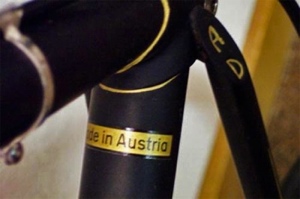 The finale for the Steyr-Daimler-Puch AG conglomerate came about in the 1990's. In the first stage Steyr Tractor was sold to J.I. Case Corporation. By 1998 Steyr-Daimler-Puch AG automobile production became combined with Magna International, Inc., then in 2002 the name was changed from Steyr-Daimler-Puch Fahrzeugtechnik AG & Co KG to Magna Steyr Fahrzeugtechnik AG & Co KG. In 1998 the production of military vehicles was sold to an Austrian investor company that incorporated it as Steyr-Daimler-Puch Spezialfahrzeug GmbH (SSF). This in turn was sold in 2003 to the US based General Dynamics, then renamed General Dynamics European Land Systems-Steyr GmbH. Steyr Mannlicher GmbH remains based at Kleinraming, Austria and independently producing small arms for hunting, law enforcement and defense agencies. Steyr Daimler Puch Fahrzeugtechnik AF & Co KG became a part of the German company Peters Engineering, an aeronautical engineering services firm based in Munich that works with EADS and Airbus among others. All that is left of what Johann Puch might recognize is represented by the Johann Puch Museum in Graz, Austria. It is amazing to see how this consortium evolved and how it all started with Johann Puch making bicycles in 1891! Unfortunately I do not ever again anticipate seeing new Austro-Daimler bicycles coming from a General Dynamics or Magna subsidiary - at least not selling for less than $1 million each.
The finale for the Steyr-Daimler-Puch AG conglomerate came about in the 1990's. In the first stage Steyr Tractor was sold to J.I. Case Corporation. By 1998 Steyr-Daimler-Puch AG automobile production became combined with Magna International, Inc., then in 2002 the name was changed from Steyr-Daimler-Puch Fahrzeugtechnik AG & Co KG to Magna Steyr Fahrzeugtechnik AG & Co KG. In 1998 the production of military vehicles was sold to an Austrian investor company that incorporated it as Steyr-Daimler-Puch Spezialfahrzeug GmbH (SSF). This in turn was sold in 2003 to the US based General Dynamics, then renamed General Dynamics European Land Systems-Steyr GmbH. Steyr Mannlicher GmbH remains based at Kleinraming, Austria and independently producing small arms for hunting, law enforcement and defense agencies. Steyr Daimler Puch Fahrzeugtechnik AF & Co KG became a part of the German company Peters Engineering, an aeronautical engineering services firm based in Munich that works with EADS and Airbus among others. All that is left of what Johann Puch might recognize is represented by the Johann Puch Museum in Graz, Austria. It is amazing to see how this consortium evolved and how it all started with Johann Puch making bicycles in 1891! Unfortunately I do not ever again anticipate seeing new Austro-Daimler bicycles coming from a General Dynamics or Magna subsidiary - at least not selling for less than $1 million each.
As I understand it, the rights to the name Austro-Daimler were not conveyed to Bianchi when Puch was sold. Either Magna, or General Dynamics or Case Corporation would have acquired the rights to the Austro-Daimler trade name and trademarks when that part of Steyr that owned Austro-Daimler was acquired. There is no easy way to know what if any contemporary Austro-Daimler bicycle or clothing gear is legally trademarked or officially licensed. However, since May 2001 IVM Technical Consultants, an Austrian company, has registered the Internet Domain name 'Austro-Daimler.com'; most recently this domain remains basically parked and inactive.
**A US-based, Made in Taiwan AD?**In the last months of 2010 and into early 2011 a New England-based bicycle company with an E-Bay store announced they were looking into having new bicycle frames of carbon fiber supposedly made in Taiwan to be sold bearing the Austro-Daimler trademark. The example frames and artwork shown on-line by the American company bear the Austro-Daimler trade name in the Auriol style font, and with a stick-on or painted-on AD head badge logo. These are represented to be MCR-01 carbon road frames manufactured by More Choice Inc. of Taiwan, a company heretofore unknown to the author but with shipments to the USA originating from locations including Yantian, China. In tracing the history of the original company and its trade name it would be interesting to know how or from whom the rights to use the name 'Austro-Daimler' were obtained, if this permission was obtained at all.
In my opinion, whether or not the bikes are good this practice just goes to show again how some people can miss the point, compromising principles for personal gain or sentiment by essentially 'whoring out' the exclusivity or heritage of a product. Such efforts can never recover whatever values of the past, at least as long as the frames do not bear 'Made In Austria'.
In addition to the original Austro-Daimler jerseys and other gear that I have seen appear on occasion in the used market, there appear to be some contemporary interpretations of Austro-Daimler apparel being sold today. Among the contemporary third party Austro-Daimler gear I have seen is a jersey shown below (front and back), and the sewn patch:
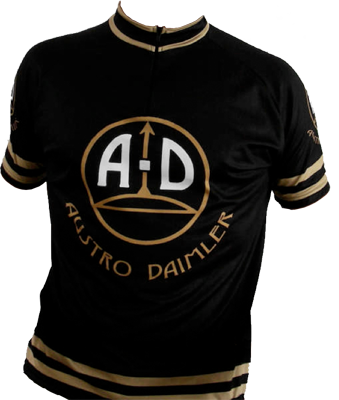
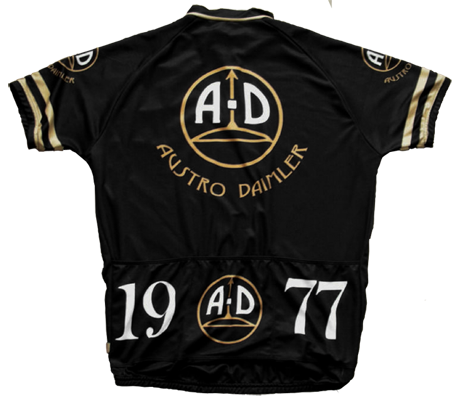
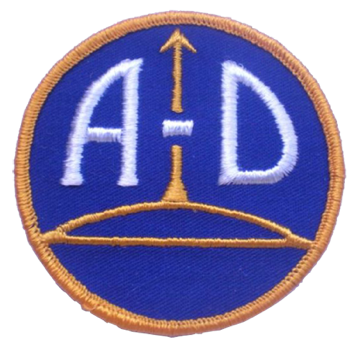
Austria Remembers Johann Puch
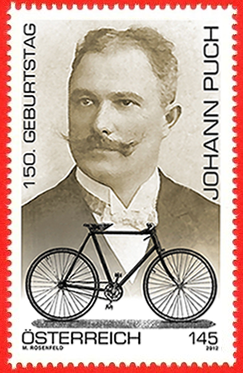 In commemoration of the 150th anniversary of the birth of Johann Puch the Össterreichische Post AG (Austrian Post Office) announced a new postage stamp bearing the image, as shown earlier in this article, of Johann Puch. The stamp was designed by Michael Rosenfeld, and is offset printed. It bears a value of 1.45 and was released on 27 June 2012 postmarked in Graz, where Puch started his company. For more information you refer to the Post Office link at http://onlineshop.post.at/onlineshop/schoenes-zum-sammeln/briefmarken---co-/marken---kleinboegen/150-geburtstag-johann-puch\_8138
In commemoration of the 150th anniversary of the birth of Johann Puch the Össterreichische Post AG (Austrian Post Office) announced a new postage stamp bearing the image, as shown earlier in this article, of Johann Puch. The stamp was designed by Michael Rosenfeld, and is offset printed. It bears a value of 1.45 and was released on 27 June 2012 postmarked in Graz, where Puch started his company. For more information you refer to the Post Office link at http://onlineshop.post.at/onlineshop/schoenes-zum-sammeln/briefmarken---co-/marken---kleinboegen/150-geburtstag-johann-puch\_8138
Kurzbeschreibung des Produktes
Die vorliegende Sondermarke würdigt den großen Ingenieur, Industriellen, Begründer der steirischen Fahrradindustrie und der legendären Puch-Werke, Johann Puch, dessen Geburtstag sich heuer zum 150. Male jährt. Das von Michael Rosenfeld gestaltete Motiv des attraktiven Wertzeichens zeigt einerseits ein Porträt von Johann Puch, andererseits das von ihm entworfene Puch-Tourenrad, Modell IV, dessen Rahmen “aus feinstem Stahlrohr” bestand und “in der Höhe von 57, 61 und 65 cm”, so die Originalbeschreibung, angeboten wurde. Zur Person: Johann Puch, slowenisch Janez Puh, wurde am 27. Juni 1862 in Sakušak bei Georgendorf in der Untersteiermark (seinerzeit Österreich, heute Slowenien) geboren. Im Jahre 1880 kam er nach einer Schlosserlehre in Bad Radkersburg nach Graz, um seinen Militärdienst abzuleisten. Danach bemühte er sich um eine Arbeitserlaubnis für Graz, die er 1889 auch erhielt. In der Folge begann Puch, seine ersten Fahrräder zu konstruieren. Die Erfolge - vor allem auch im Export nach England und Frankreich - führten 1899 zur Gründung einer eigenen Firma, der so genannten “Johann Puch Erste Steiermärkische Fahrrad-Fabriks-Aktiengesellschaft”, wo neben Fahrrädern auch Motorräder und Automobile produziert wurden. Während des Ersten Weltkrieges war das Unternehmen auch Lieferant des k. u. k. Heeres. 1914 beschäftigte Puchs Firma bereits mehr als 1.000 Mitarbeiter und stellte etwa 16.000 Fahrräder, 300 Motorräder und ebenso viele Automobile pro Jahr her. Nach dem Tod von Johann Puch am 19. Juli 1914 bestand das Unternehmen noch einige Zeit als selbstständige Wirtschaftseinheit, 1928 fusionierte es jedoch mit der “Österreichischen Daimler-Motoren AG”. Aber auch die daraus entstandene “Austro-Daimler-Puchwerke AG” hielt sich nur bis 1934. Ein neuerlicher Zusammenschluss mit der “Steyr-Werke AG” führte zur “Steyr-Daimler-Puch AG”, die neben Fahrzeugen aller Art (Pkw, Lkw, Geländefahrzeuge, Traktoren, Motorräder und Fahrräder) auch Werkzeuge und Waffen erzeugte. In den 1990er-Jahren wurden verschiedene Produktionsbereiche schließlich stillgelegt oder abgegeben, den Rest des Konzerns üErste steierbernahm 1998 die “Magna Holding AG”, die sich vor allem mit der Technik von Allradantrieben beschäftigt. Das sehenswerte Johann Puch-Museum in der Grazer Puchstraße sowie die Puchgasse in Wien-Donaustadt erinnern auch heute noch an den großen Österreichischen Maschinenbauingenieur.
Translated into English via Google Translate and by the author:
Brief Description of the product
This special issue pays tribute to the great engineer, industrialist, founder of the Styrian bicycle industry and the legendary Puch works, Johann Puch, whose 150th birthday is marked this year. The theme, designed by Michael Rosenfeld of the shows the attractive character on the one hand with a portrait by Johann Puch, the other is the Puch touring, model IV, under which in the original description was offered as “the finest steel pipe” and was made “in the frame sizes of 57, 61 and 65 cm”. Personal: Johann Puch, in Slovenian he was Janez Puh, was born on 27 June 1862 in the village Georgendorf, then in Lower Styria of Austria (now Slovenia). In 1880 after his military service he left Radkersburg for Graz where he began an apprenticeship to a locksmith. Then he applied for a work permit in Graz, which he received in 1889. As a result, Puch began to construct his first bike. The successes - especially in the exports to England and France - led in 1899 to Puch founding his own company, the so-called “J. Puch - First Styrian Bicycle AG Fabriks”, where in addition to bicycles over time motorcycles and automobiles were to be produced. During the First World War the company was among the suppliers of the Imperial Army. By 1914 Puchs' company employed more than 1,000 people and produced annually about 16,000 bicycles, 300 motorcycles, and just as many cars per year. After the death of Johann Puch on 19 July 1914 was the company became for some time an independent business unit, until in 1928 it merged with the “Austrian Daimler-Motoren AG”. But the resulting “Austro-Daimler AG Puchwerke” lasted only until 1934 as a renewed association with the “Steyr-Werke AG” led to their merger that formed the “Steyr-Daimler-Puch AG”. Steyr-Daimler manufactured many types of vehicles (cars, trucks, ATVs, tractors, motorcycles and bicycles) as well as tools and weapons. In the 1990s various production departments were finally closed down or sold, the rest of the group was taken over in 1998 by “Magna Holding AG”, which deals primarily with the technologies of four-wheel drives. The impressive Johann Puch Museum in Graz and the Puchstraße Puchgasse in Vienna Danube town still remember the great Austrian mechanical engineer.
 The Vent Noir Series were among those elegant bicycles made bearing the 'Puch' or 'Austro-Daimler' head badge metal plaque. The original Vent Noir was equipped as a mid level model in the product line, it was distinguished by its matte black painted chrome frame with black anodized components. For any ignoramuses out there Vent Noir is French for 'Black Wind' - OK, I had to look that up.
The Vent Noir Series were among those elegant bicycles made bearing the 'Puch' or 'Austro-Daimler' head badge metal plaque. The original Vent Noir was equipped as a mid level model in the product line, it was distinguished by its matte black painted chrome frame with black anodized components. For any ignoramuses out there Vent Noir is French for 'Black Wind' - OK, I had to look that up.
The level of detailing and the included components of the Vent Noir series varied depending on their Puch or Austro-Daimler designation, when they were made, and by where they were to be sold - in Europe or USA for example, with some changes happening from year to year for reasons unknown to me.
1. by 1975 the Vent Noir and Vent Noir II were marketed in the USA and UK as 'AUSTRO-DAIMLER'. While in most of Europe and elsewhere the same frame could be found bearing the 'PUCH' trademark shown below at right.
2. the Vent Noir and Vent Noir II were marketed with various component groups and components including Campagnolo, Cinelli, Shimano, Weinmann.
3. earlier Austro-Daimler trademarked models bear the “AD” head badge. But by about 1983 the Austro-Daimler Vent Noir II sold bear the Puch head badge.
4. some later models bear “by Puch” alongside the Austro-Daimler name, and these were sold bearing the Puch head badge.
Above: The Austro-Daimler and Puch trademarked Vent Noir bicycles.
Click on each image to see the enlarged view.
The 1976 specification 'Austro-Daimler' and European market 'Puch' Vent Noir ten speed bicycles were originally provided with the Shimano Dura-Ace components gruppo with a 42/53 tooth crankset and Shimano Crane rear derailleur. Most distinctively, some of the gruppo components were anodized black. These bicycles incorporated 'Regina Oro' cassette and chain in gold finish, the pedals were MKS-URK2 (Mikashima Industrial Co., Ltd. of Japan) with toe clips. The hubs were Dura-Ace, with Fiamme #1 wheel rims and Inox 2mm spokes. The tires were Clement Strada 66. The saddle was a Gilux 3000, the bar and stem were by GB. The set included a bicycle tire pump with Campagnolo ends. This was listed as weighing 22-½ lbs. with a price then of $540.00.
Left: a Vent Noir originally sold in 1977; even then this frame bears the PUCH “100 Year” anniversary decal mentioned earlier in this article (42,380 bytes).
Click on image to see enlarged view (110,892 bytes).
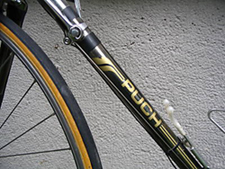 The original Vent Noir was joined in 1978 with the release of the Vent Noir II which is not finished in black, and neither were it's components. Both the Vent Noir and the Vent Noir II frames were assembled in Austria incorporating Reynolds 531 (pronounced “five-three-one") Manganese-Molybdenum alloy tube stock sourced from 'Tubes Investments Reynolds Limited' of Birmingham, England. The frame of the Vent Noir II were chromed, treated with a process that produced the dark golden greenish brown 'smoked chrome' appearance.
The original Vent Noir was joined in 1978 with the release of the Vent Noir II which is not finished in black, and neither were it's components. Both the Vent Noir and the Vent Noir II frames were assembled in Austria incorporating Reynolds 531 (pronounced “five-three-one") Manganese-Molybdenum alloy tube stock sourced from 'Tubes Investments Reynolds Limited' of Birmingham, England. The frame of the Vent Noir II were chromed, treated with a process that produced the dark golden greenish brown 'smoked chrome' appearance.
Right: this Vent Noir II frame originally sold in Europe bears the 'PUCH' trademark (42,380 bytes)
Click on image to see enlarged view (168,232 bytes).
The better early to mid production Puch and Austro-Daimler road frames incorporate either complete Campagnolo or Shimano sets of Dropouts and Fork Tips. I have seen frames of the earliest production Vent Noir II and some made after mine too, with Shimano tips and drop-outs. Mine incorporate tips and drop-outs made by Campagnolo, while other Vent Noir II's produced later (Serial No. 6239040 for example) incorporate tips and drop-outs made by Shimano.
Even though in 1978 the Vent Noir II was marketed as “The All European Limited Edition” (see the brochure near the end of this article) I find it curious to note the 1978 and 1981 brochures lists it being delivered with Shimano components; the 'all Euro' claim probably was devised by the same fellow who did not know the meaning of 'vent noir'.
All forks and frames of the Austro-Daimler line and the better Puch models assembled at Graz were silver brazed by hand. The catalogs referred to this and usually featured an image of one of the factory craftsmen working on the frames. As explained in their brochures, the lugged tube joints were precisely joined then solidly fixed with a low-temperature soldering process that did not adversely impact the tempering of the Reynolds tubing. The comparatively low temperature silver solder provides joint has great strength, rigidity and durability. So confident was Stery-Daimler-Puch of America Corporation in the durability of their bicycle frames that their 1977 catalog and the Warranty Card provided with each new AD bicycle promised "The famous AUSTRO-DAIMLER warranty covers all frames against manufacturer's and material defects for an unlimited period of time for the original owner, and all parts and workmanship for the first twelve months."
The Austro-Daimler Vent Noir frames I have seen in the USA have a bit more elegant trim than some of the Puch models that would be sold here later, with the Austro-Daimler having gold pinstripes and with gold detailing of the Lugs (painted by hand) in a manner similar to my own Vent Noir II. And yet over their years in production there are variations in the detailing and in some accessories (including hand-stitched leather covered handlebars as on my own VNII) that lead me to conclude the Austro-Daimler line was at its most elegant from about 1978 to 1980.
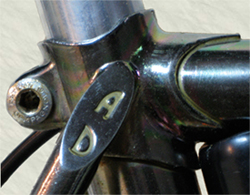 Consider the differing head badging, and labeling of the Top Stay Tube Tips for examples. The Top Stay are are the two frame tubes that rise from the rear axle and are brazed onto either side of the Seat Lug which joins the Seat Tube and the Top Tube just below the Seat.
Consider the differing head badging, and labeling of the Top Stay Tube Tips for examples. The Top Stay are are the two frame tubes that rise from the rear axle and are brazed onto either side of the Seat Lug which joins the Seat Tube and the Top Tube just below the Seat.
- Many of the bicycles made in this period of about 1976 to 1977, including the top line Ultima, bear a stick-on PUCH head badge label or a stick-on AD head badge label instead of the embossed painted metal version as is found on some earlier and later production models.
- On the earlier production Vent Noir and Vent Noir II frames the Top Stay Tube Tips are welded onto either side of the Seat Tube Lug, each Tip has an elliptical flat area that accommodates a decal, or an engraving or pressing of a logo. The Vent Noir and Vent Noir II frames made about the time that mine was built, in 1978, bear either the letters PUCH or 'AD' engraved and inlaid in gold paint, and these are arranged vertically on the Top Stay Tips. This is yet another detail that was provided for only on the better bike frames being made during this era.
Right: author's Austro-Daimler Vent Noir II details: Top Stay Tip, Bocama Professional Series (BC-PR) Seat Lug, and Campagnolo Seat Binder Bolt. Note iridescence of the anodizing, and hand painted gold trim and inlaid stamped lettering (52,688 bytes).
Click on image to see enlarged view (139,533 bytes).
There were changes in the Top Stay Tips detailing too. In the 1976 Ultima this may have the AD stamped tips, though not filled in with gold paint. While a Vent Noir that I can not date and an AD SL made in about 1977 and another AD SL from 1980, bear the 'AD' but simply a two letters decal applied to the flat area at the top each of the Tips. While the 1977 production and some later production super leicht frames made for distribution in Europe may bear a PUCH lettered frame and with the AD stamped tips, these frames will also bear a stick-on PUCH head badge instead of the metal plaque.
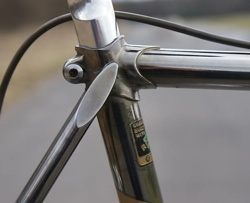 On the later production Puch and Austro-Daimler Vent Noir and Vent Noir II series frames, those made after mine, the engraving on the Top Stay Tips may have been omitted altogether with the area left flat. Austro-Daimler frames made in the mid 1980's may have the Top Stay tubes attached to the lug with their tips welded into the rear of the Seat Tube Lug and with no flat area at all.
On the later production Puch and Austro-Daimler Vent Noir and Vent Noir II series frames, those made after mine, the engraving on the Top Stay Tips may have been omitted altogether with the area left flat. Austro-Daimler frames made in the mid 1980's may have the Top Stay tubes attached to the lug with their tips welded into the rear of the Seat Tube Lug and with no flat area at all.
Right: Late production Puch Vent Noir II Top Stay Tip, unknown Lug, and unknown make of Seat Binder Bolt. Note flat Stay Top with no lettering, there is none of the hand painted gold trim treatment as was formerly provided, and there is no “MADE IN AUSTRIA” decal as was usual above the Reynolds Decal (52,688 bytes).
Click on image to see enlarged view (139,533 bytes).
Another fine touch for many of these frames is the hand painted trim around the upper brazed lug and tube joints, pin striping along parts of the tubes and forks, and paint inlay of the lettering stamped on the Top Stay tube tips. On the Vent Noir II this is a gold tone paint (as seen in the image above left), while on other frames it could be some other contrasting color. On the early production Vent Noir II and on the later production frames the hand painted pin striping accents along some tubes and around the lugs was scaled back, and on later production frames this labor-intensive detailing would eventually be completely omitted. This detailing is absent on the frame shown above right, and is also missing on some earlier production Austro-Daimler Vent Noir II including frame Serial No. 6019869 for example.
Later production Puch and Austro-Daimler frames may incorporate Horizontal Dropouts and Fork Tips or other components made by yet another supplier: Gipiemme, sometimes misread 'Giriemme'. Gipiemme S.R.L. is a manufacturer founded in 1964 by Giovanni Bernardi at Milano, Italy. Production is based in Loria near Treviso, Italy. Their offices are in Vicenza, not far from Campagnolo headquarters. Gipiemme developed their own products, mostly as a less costly alternative to the top line Campagnolo. Gipiemme was at times subcontracted by Campagnolo to manufacture parts for Campagnolo's lower tier Gruppo's. However, in terms of performance Gipiemme's best 'Special' components Gruppo competed directly against the best made by Campagnolo. They showed signs of being an innovator as late as in 1984 when they became the first company to offer Rims made of carbon fiber. Gipiemme S.R.L. was sold in 1989 and since then have pared down their offerings to focus on the production of Saddles, Rims and Wheels.
Some Puch branded frames made in Austria after 1981 that incorporate a mix of components, one for example with Gipiemme Dropouts and yet with Campagnolo Fork Tips. I do not understand why this would have occurred; could it be there was simply a shortage of one component set at a supplier, or a mix-up of frame and forks during assembly? Or, was this indicative of a problem with the procurement or inventory process at Stery-Daimler-Puch?
Early 1980's factory Puch literature shows an eighteen (18) speed version of the Austro-Daimler Vent Noir in black frame and with 'PUCH' vertically engraved on the frame Top Stay tips, and where the components changed to the T/A Cyclo Tourist crank, Duo-Par titanium rear Derailleur, and Weinmann 'Carrera' side pull brakes, and with 'Regina Oro' cassette and chain in gold finish. This was listed as weighing about 22-½ lbs.
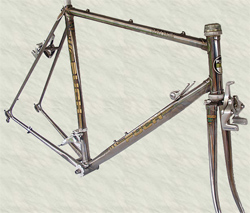 The Vent Noir II was in production through 1981 but by 1982 appears to have been discontinued both in the USA and Europe, it is not listed in subsequent sales literature. However, the latest version of the black Vent Noir reappears in the line for 1982. Retaining the all-black finish to the end, the last of the production Vent Noir bicycles, made from about 1980 on, bear the “STEYR-DAIMLER-PUCH” gold decal on either side of the Down Tube, with some gold pinstripe accents around some lugs, with a Puch sick-on decal instead of the metal head badge as provided on earlier models. The components may have varied but I have seen some of these bicycles with the trademark black anodized Shimano Dura-Ace 53T chainring with crankset and front derailleur, with Shimano Crane rear derailleur, Shimano Drop-Outs, Shimano or Weinmann brakes and wheels, Suntour SR or Gipiemme stem and handlebar, Corsaire 313 San Marco saddle, Regina Oro chain, Fiamme 27 inch rims with Continental 'Sprinter' or 'Gatorskin' tires.
The Vent Noir II was in production through 1981 but by 1982 appears to have been discontinued both in the USA and Europe, it is not listed in subsequent sales literature. However, the latest version of the black Vent Noir reappears in the line for 1982. Retaining the all-black finish to the end, the last of the production Vent Noir bicycles, made from about 1980 on, bear the “STEYR-DAIMLER-PUCH” gold decal on either side of the Down Tube, with some gold pinstripe accents around some lugs, with a Puch sick-on decal instead of the metal head badge as provided on earlier models. The components may have varied but I have seen some of these bicycles with the trademark black anodized Shimano Dura-Ace 53T chainring with crankset and front derailleur, with Shimano Crane rear derailleur, Shimano Drop-Outs, Shimano or Weinmann brakes and wheels, Suntour SR or Gipiemme stem and handlebar, Corsaire 313 San Marco saddle, Regina Oro chain, Fiamme 27 inch rims with Continental 'Sprinter' or 'Gatorskin' tires.
Left: Puch Vent Noir Aero made with the Reynolds 531 'Speed Stream' frame (31,044 bytes). Note the lack of hand painted gold trim. Furthermore, the Top Stay Tip is flat and with no 'PUCH' embossed.
Click on image to see enlarged view (93,750 bytes).
The last new model of the series was introduced in 1982, marketed as the Puch Vent Noir Aero though labeled Vent Noir. This model is built with the Reynolds 531 'Speed Stream' tapered frame tubes. Their most distinctive visual features are the tapered Down and Seat Tubes; as their diameter widens towards the middle of each tube and narrows to the standard diameter to fit into the frame lug. Otherwise these resemble the Vent Noir II of the 1980-81 era, finished with the same smoked chrome process with some frames appearing a bit lighter in tone, more towards silver. These were factory-equipped with the Shimano Dura-Ace AX components gruppo. The Top Tube bears the decal Vent Noir, and the 'PUCH' head badge is affixed. The Puch Vent Noir Aero were marketed for sale only in Europe.
There were changes of the factory issued Vent Noir series frame finishes of this period. For example the Puch branded Vent Noir bicycles that came into production with the aero tube frame no longer were made in black and with black finished group components, but instead these have a matte chromed finish that is more like a satin chrome than the greenish-gold frame of my Vent Noir II. The Vent Noir II frames in production by 1980, Austro-Daimler and Puch alike, similarly have a frame finish that are no longer the greenish-gold tone. Other frames too could be ordered with the 'smoked chrome' finish. By 1981 or 1982 it appears that one could order the Vent Noir frame in a greenish-blue teal painted finish; I have seen one such frame SN 7012580 and the paint does appear factory issued.
For 1982 the factory offerings included the ULTIMA and the ULTIMA SL models made with Reynolds 531SL their special lightweight (hence SL) tube set and forks. The Reynolds 531SL (explained above in this article) is a lighter weight set owing to the choice of alloy, though the tube wall of the SL can be as thick or thicker than those of the standard 531 alloy frames. These frames too incorporated drilled Campagnolo Dropouts, appearing similar to the standard dropouts but each has twelve holes drilled through at locations where strength is not compromised thus shaving precious fractions of grams off the net weight of the set. An additional detail on the ULTIMA and ULTIMA SL was the stamping of the fork crown top at either side with “PUCH”. The ULTIMA SL became available with the greenish-gold chromed finish made popular by the Vent Noir II, so at first glance these might be confused for one another.
The factory 1983 literature shows the Vent Noir model in production and with the option of ordering the super leicht model also in smoked chrome. However, by 1985 all models of the Vent Noir in black, otherwise painted, or chromed, had been discontinued.
 From the moment that I first gazed upon it in the showroom the Vent Noir II was a sight to behold, and it remains so to this day. The elegant appearance of this bike attracted me to it immediately. And even though at the time I knew nothing about Puch or Austro-Daimler bicycles, my knowing that it was made in Austria and also related to Daimler was reassuring. The 57cm frame geometry is a perfect fit for me. It is tastefully appointed in its finish and markings; this is less and less common for bikes made in recent years when their frames are often splashed with every form of commercial trademark to sell this or that from any conceivable angle. The tips of the frame Top Stay tips of my Vent Noir II are engraved with “AD” in a vertical arrangement, and with the “AD” Head Plate (shown above right). And instead of being painted as most other bikes are, the Vent Noir II's entire frame and fork were chemically treated with a hard anodizing process producing a durable dark golden greenish brown color described as “Smoked Chrome” in the literature. Rarely have I seen such an elegant frame tubing treatment; photos can not do it justice as the finish of the frame appears to take on subtle tone changes reflecting varying times of day and differing surroundings while joint (lug) areas appear almost iridescent.
From the moment that I first gazed upon it in the showroom the Vent Noir II was a sight to behold, and it remains so to this day. The elegant appearance of this bike attracted me to it immediately. And even though at the time I knew nothing about Puch or Austro-Daimler bicycles, my knowing that it was made in Austria and also related to Daimler was reassuring. The 57cm frame geometry is a perfect fit for me. It is tastefully appointed in its finish and markings; this is less and less common for bikes made in recent years when their frames are often splashed with every form of commercial trademark to sell this or that from any conceivable angle. The tips of the frame Top Stay tips of my Vent Noir II are engraved with “AD” in a vertical arrangement, and with the “AD” Head Plate (shown above right). And instead of being painted as most other bikes are, the Vent Noir II's entire frame and fork were chemically treated with a hard anodizing process producing a durable dark golden greenish brown color described as “Smoked Chrome” in the literature. Rarely have I seen such an elegant frame tubing treatment; photos can not do it justice as the finish of the frame appears to take on subtle tone changes reflecting varying times of day and differing surroundings while joint (lug) areas appear almost iridescent.
Right: Embossed aluminum head badge on the Head Tube of my Austro-Daimler Vent Noir II (18,250 bytes).
On 7 May 1981 I bought this ten speed road bicycle from Larry Black the founder and owner of College Park Bicycles in Maryland.
The 531 Frame, And My Bike's Major Components:
The frames of bicycles are manufactured to scale in various sizes, this is to accommodate the height and inseam length of the rider. The frames are usually represented in centimeters though some manufacturers express this in terms of inches. The frame size is usually based on the length of the seat tube as measured from the center of the bottom bracket to the top of the seat tube; this is often referred to as 'C-T' for center to top. Some manufacturers give this as center to center or 'C-C'. So one should at least double check the measurement standard give, and ideally try a test ride before committing to any new bicycle. Given my own height overall is 5 feet 10 inches (177 cm) with a standing leg length of 33 inches (83.8 cm), I selected this Austro-Daimler 57cm frame as it provides a stand over height (height from the top of the top tube to the ground) of 32-½ inches (82.6cm).
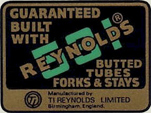
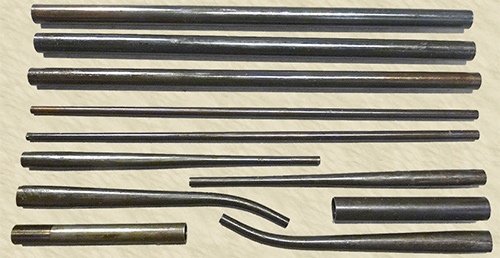
The frame of my Vent Noir II's was built, probably later in 1978, with Reynolds 531 double-butted tubing. This tubing is a non heat treated Manganese-Molybdenum tubing stock that was first offered in 1935. But 531 reached its zenith in terms of popularity in the era from around 1955 to 1977. Furthermore, up to 1977 the bicycles that won 20 out of the most recent annual 21 Tour de France races were made of Reynolds 531 cycle tubes; the top ten finishers in 1977 rode on 531!
Right: Tube stock as it would have been supplied to Steyr by Ti Reynolds to build my Austro-Daimler Vent Noir II bicycle (75,532 bytes).
The major components of the Reynolds tube set includes eleven (11) seamless tube sections that would be welded together, in a specific sequence, with lugs to form the frame. Most of the tubes have a cylindrical profile, while the raked fork tubes are elliptical (or oval). These are: the top tube, seat tube, down tube, two chainstays, two seat stays, two fork blades, a head tube, and a threaded steerer tube. These are double-butted steel tubes: the walls at both ends are thicker than the wall at the center of the tube. Double-butting results in a strong and yet lighter weight frame that is more resilient and better riding than non-butted frames. The set typically was furnished by Reynolds boxed and with appropriate Reynolds 531 Decals set to be applied one each to the forks, and one on the seat tube (shown above left).
The assembled 531 road frames (531, 531 SL, 531 Pro) will weigh between about 1900 to 2200 grams (4.2 and 4.8 lbs.). This complete Vent Noir II would have left the factory weighing about 23 lbs. I have not weighed it since I added accessories then later changed the components over to all Campy, but it sure does feel lighter and more agile now than it was when new.
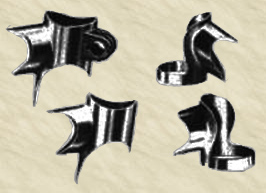 The Vent Noir II that I purchased is somewhat better equipped than I expected. For example, the Reynolds 531 tubes of my Vent Noir II were joined at the factory with silver brazed investment cast steel Lugs that were made by Bocama in France. Lugs not only join the frame tubes but their design also reinforce the joints resulting in a durable, stronger and more rigid frame than those that are joined by simply welding tubes together. The Lugs on my frame are their Professional Series, and are marked 'BCM' indicating medium-length pointed tips. The angle of at one of these reads '72Δ'. The Austro-Daimler sales literature specifies a 73° Headtube angle frame, and at least one Bocama document specifies the following dimensions for the Professional Lug Set with Medium Points:
The Vent Noir II that I purchased is somewhat better equipped than I expected. For example, the Reynolds 531 tubes of my Vent Noir II were joined at the factory with silver brazed investment cast steel Lugs that were made by Bocama in France. Lugs not only join the frame tubes but their design also reinforce the joints resulting in a durable, stronger and more rigid frame than those that are joined by simply welding tubes together. The Lugs on my frame are their Professional Series, and are marked 'BCM' indicating medium-length pointed tips. The angle of at one of these reads '72Δ'. The Austro-Daimler sales literature specifies a 73° Headtube angle frame, and at least one Bocama document specifies the following dimensions for the Professional Lug Set with Medium Points:
- Head: 31.7mm
- Top: 25.4mm, 73° (other information suggests 72, 73, 74, 75°)
- Down: 28.6mm, 61° (other information suggests 58, 59, 60, 61°)
- Seat: 28.6mm, 73° (other information suggests 72, 73, 74, 75°)
Right: Lugs made by Bocama connect the tubes of my Austro-Daimler Vent Noir II bicycle (104,666 bytes).
Click on each image to see the enlarged view.
Some professional builders feel Lugs within 1° of another can be interchanged. It is likely that Bocama would make Lugs to various other custom specifications if the ordered quantity justified it.
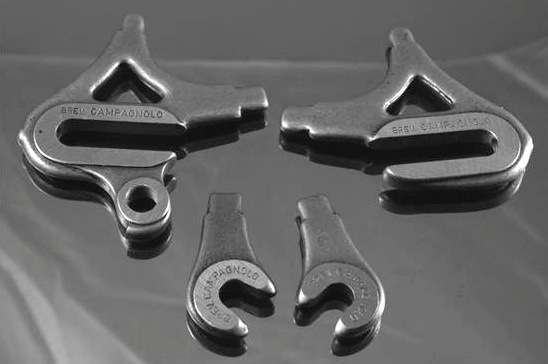 Based on the Serial Number this frame appears to have been made in 1978, the first year of the Vent Noir II. Although the 1978 and 1981 Austro-Daimler literature I have read mentions Shimano as the source of Horizontal Dropouts and the Fork Tips, and I have seen earlier production Vent Noir II with Shimano. These are the portions welded onto the frame tube ends that hold the road wheels, while the right rear Dropout also incorporates a hangar (loop) to support the rear Derailleur.
Based on the Serial Number this frame appears to have been made in 1978, the first year of the Vent Noir II. Although the 1978 and 1981 Austro-Daimler literature I have read mentions Shimano as the source of Horizontal Dropouts and the Fork Tips, and I have seen earlier production Vent Noir II with Shimano. These are the portions welded onto the frame tube ends that hold the road wheels, while the right rear Dropout also incorporates a hangar (loop) to support the rear Derailleur.
Left: Campagnolo 'Record' Model 1010/A forged steel Fork Tips and Dropouts as are installed on my Austro-Daimler Vent Noir II bicycle.
Click on image to see the enlarged view.
The Horizontal Dropouts and the Fork Ends (Tips) of this Vent Noir II frame are the forged steel Campagnolo Model 1010/A 'Rear And Front Fork Ends Without Eyelet' set as provided with the 'Super Record' group of the time. Weighing in at 217 grams per set, these are on the lighter end of what were made for standard road frames. The /A suffix indicates this set is in the top line Record series of product, and that the Fork Ends and Dropouts are provided without eyelets. Each Dropout incorporates a 38mm long spring-loaded knurled head adjusting bolt, this is the chain adjuster mechanism that permit setting the rear wheel axle back or forward within the long grooves thereby adjusting the chain slack. Thank goodness these are Campy since I'd hate to have made all this effort and paid the expense to make an “all Euro” bike, only to find Shimano parts (however good) welded to the frame!
The Bottom Bracket Shell of my Vent Noir II is engraved with the frame Serial Number (6164001), and above this number in smaller type are “A 11” upside down relative to the Serial Number; I do not know what the A 11 indicates. The shell also has the letter “E” stamped near the Crank Bearing indicating this is threaded 1.370"X 24 tpi and with a standard 68mm wide shell; this specifications set are known for short as the British Standard.
The British specification set was also known as the BSA standard after Birmingham Small Arms who developed the standard. This British standard has since been adopted by the ISO, the International Organization for Standardization and is most the common spec for production bicycles. While Puch certainly provided frames threaded with the British standard, I have seen some Puch frames of this era made with either Italian or French standard threaded Bottom Bracket with the appropriate stamp on the Bottom Bracket shell indicating French threading for example with 'F'. I have not seen any Austro-Daimler frame with any other than the British standard threading, as mine is indicated by the 'E' stamp, or some earlier frames bearing the letter 'B'.
There also seems to be some indication of frame size reflected by the numbers stamped onto the Bottom Bracket Shell near the Serial Number of many but not all Austro-Daimler and Puch frames. For example Puch frame No. 701258x bears the numbers '863', possibly reflecting it is a 63cm frame. Another Puch, No. 6760804, has the stamped numbers '857' on the shell of this 57cm frame.
I have read comments that some owners of Austro-Daimler bicycles complained about rough file marks, rust, etc. on earlier production frames but my AD frame shows none of this, and so it is possible this is wrong or could be found only on some frames. My Vent Noir II was manufactured probably in 1978, towards the middle of the Austro-Daimler Puch production after early lessons learned by the craftsmen had most likely been implemented.

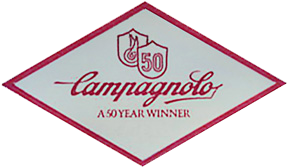
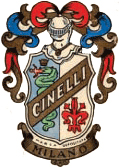




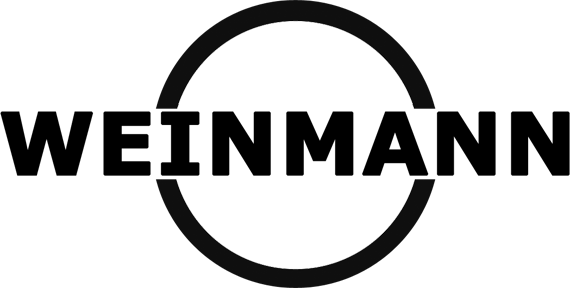

The components needed to complete the bicycle as it was originally set up were sourced by Austro-Daimler from well regarded makers including: Campagnolo, Cinelli, and Regina Oro of Italy, from Avocet in France, and Weinmann then of Belgium and Switzerland. Anyone who appreciates fine craftsmanship and mechanics could have little bad to say about the Austro-Daimler Vent Noir II of this period as it was delivered to the retailer when new. This bicycle's most critical components were beautifully machined made by Campagnolo ('Campy') and originally it was made up with components from their Gran Sport Gruppo (a mid priced grouping) including: 42/53 Crankset, front and rear Derailleur, Shift Levers, front and rear wheel quick release Hubs, Brakes, Pedals. The Wheel Rims are aluminum alloy 700c clincher (Presta valves) were made by Weinmann, the ½"x 3/32" Chain and the 14/24 Freewheel were made by Regina Oro and when new appeared as though they were plated in gold - this nice appearance lasts for a few miles of riding as I recall. The comfortable black leather seat (Saddle) was made by Avocet.
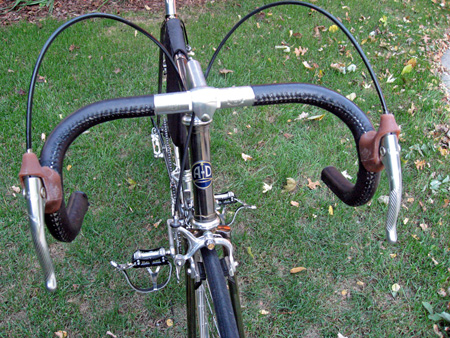 The Cinelli 'Giro D'Italia' (Cinelli Model 64) drop-style handlebars of my Austro-Daimler are machined from wrought Aluminum 6061 T6 alloy, then anodized in a satin natural aluminum finish. The 6061 T6 alloy is widely employed in aircraft and boat manufacturing owing to its excellent strength to weight ratio, good workability, and resistance to corrosion even after being abraded. The 'Giro' are the lightest weight of the Cinelli series of its day, with a wall thickness as narrow as 1.7mm in some areas these bars with a 42cm center to center span weigh about 312g. With the shallowest drop (138mm center to center) of the top four Cinelli drop bars made during this era, I find the Giro to be the most comfortable aluminum fast touring bars I have used. This late 1970's production handlebar incorporates tasteful low-profile markings befitting the elegance of this bike; facing the bars you can see the engraved Cinelli crest to the left of the stem and the engraved 'Mod. Giro D'Italia' within a wreath to the right side of the stem. The crests are easy to appreciate with the eye but not so easy to photograph so I considered filling in the engraved area with contrasting gold to match the trim of the Vent Noir II, but I dismissed this idea preferring instead to conserve them in their original finish.
The Cinelli 'Giro D'Italia' (Cinelli Model 64) drop-style handlebars of my Austro-Daimler are machined from wrought Aluminum 6061 T6 alloy, then anodized in a satin natural aluminum finish. The 6061 T6 alloy is widely employed in aircraft and boat manufacturing owing to its excellent strength to weight ratio, good workability, and resistance to corrosion even after being abraded. The 'Giro' are the lightest weight of the Cinelli series of its day, with a wall thickness as narrow as 1.7mm in some areas these bars with a 42cm center to center span weigh about 312g. With the shallowest drop (138mm center to center) of the top four Cinelli drop bars made during this era, I find the Giro to be the most comfortable aluminum fast touring bars I have used. This late 1970's production handlebar incorporates tasteful low-profile markings befitting the elegance of this bike; facing the bars you can see the engraved Cinelli crest to the left of the stem and the engraved 'Mod. Giro D'Italia' within a wreath to the right side of the stem. The crests are easy to appreciate with the eye but not so easy to photograph so I considered filling in the engraved area with contrasting gold to match the trim of the Vent Noir II, but I dismissed this idea preferring instead to conserve them in their original finish.
The handlebar is held rigidly to the Campagnolo head tube bearings by the then top line Cinelli A1 quill stem, one with the pre-1995 standard 26.4mm diameter and 73 degree angle. The stem is beautifully machined from wrought Aluminum 6066 T6 alloy netting a weight of some 280g, then anodized with a natural aluminum satin finish. The stem bears only a small tastefully engraved oval 'Cinelli Milano' marking at the top.
Right: Author's Austro-Daimler Vent Noir II showing Cinelli Bar and Stem, Campagnolo Gruppo, hand-sewn Almarc leather handlebar grips - as nice as you could imagine even after some 26 years (194,945 bytes).
Click on image to see enlarged view (429,532 bytes).
Covering the grip areas of the 'Giro D'Italia' drop bar are precisely hand-stitched black leather covers made by Almarc of Italy, founded in 1975 by brothers Roberto and Marco Lissoni. As work commenced in 2006 on my Vent Noir II I had not found the equal of fit and finish as this leather work. The leather is made as a pair with two strips rectangularly cut as wide as the circumference of the handlebar, and the holes are punched for the thread. As I read it described "the brake lever clamp is attached to the bare handlebars. Then the leather strips and soaked in water to soften the leather, then each is laced onto the handlebars using black linen thread starting near the center using two (2) needles, and proceeding in a manner like lacing a shoe. As the leather dries it will shrink to fit." The clean symmetrical lacing and the perfectly matched flush fit seam testify to the patience and skill of the craftsmen who made this and the person who applied this.
Curiously enough, most of the factory literature and images of used Austro-Daimler and Puch bicycles models, even the top of the line Ultima, manufactured before and after my 1978 Vent Noir II show their handlebars being provided with conventional fabric tape covering. I suspect this Almarc covering was a short-lived upgrade product provided with the Vent Noir II models that was discontinued as being too costly and or too labor intensive to install.
Since I wanted to buy this bike then but my funds were not equal to the task, Larry Black offered to modify the bike somewhat to suit my budget. We swapped out some Campy gear for Shimano which was probably just as good at half the cost. The final cost of this bike was 750.00plusthelocalfivepercentStateSalesTaxamountingto750.00 plus the local five percent State Sales Tax amounting to 750.00plusthelocalfivepercentStateSalesTaxamountingto787.50; this equates to just about $2,000 in buying power by 2012, according to the US Government's Consumer Price Index Inflation Calculator. At the time I could not have not fully understood how my mindset would change later but truth be told had I ordered it in an “All Euro” arrangement, then better things might not have happened to it later.
The Vent Noir II turned out to be a joy to ride, durable and resistant to the elements and shocks of day to day riding on suburban streets and paved paths. At about 22 lbs. this was not a world class ultra lightweight racer but in many ways it was leagues beyond the technology of my first ten speed, a yellow Schwinn Le Tour of 1974. The Schwinn Le Tour bicycle with its kickstand weighs about 31 lbs. This model was made in Japan for Schwinn (hence labeled Schwinn Approved) and sold in the USA for $147.95 in 1974. However, even an economically accessorized Vent Noir II of 1980-81 cost notably more. I found either bike was wholly adequate for day to day fast touring rides for that one with cast iron legs could enjoy, but the Vent Noir II felt so much lighter and responsive that it seemed as though it might just run right out ahead from under me!
Accessory Items That Date It:
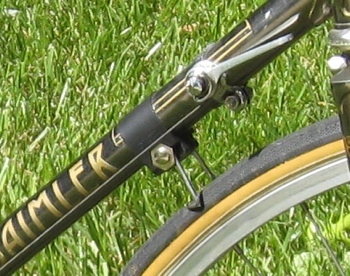 This Vent Noir II was accessorized by me to incorporate some ideas that have since been lost to the modern bike accessory maker including the handy and lightweight (26 g) “Flickstand”. Made by the now defunct Rhode Gear USA company, this is a plastic split ring that slips onto the Down Tube and is bolted into place, to this is attached a steel brace. To park the bike swing the brace down and forward, then while holding the brace against the tire back up the bike by a few inches until the brace impinges firmly against the tire. This holds the front wheel in line with the frame and it also prevents the wheel from rotating so the bike can be left standing nearly upright against a support. The Flickstand eliminates carrying the weight and the unsightliness of a conventional Bicycle Kick Stand. The Flickstand fit onto most popular road and BMX frames made throughout the 1980s since frame tubing were similar in diameter and cylindrical in shape. Since it was nearly a 'universal fit' accessory retailers did not have to stock many different models. However, although the principle of operation never changed there were some minor changes of design over the years of production; I learned this when shopping to replace my original worn out Flickstand with an identical 'new old stock' unit.
This Vent Noir II was accessorized by me to incorporate some ideas that have since been lost to the modern bike accessory maker including the handy and lightweight (26 g) “Flickstand”. Made by the now defunct Rhode Gear USA company, this is a plastic split ring that slips onto the Down Tube and is bolted into place, to this is attached a steel brace. To park the bike swing the brace down and forward, then while holding the brace against the tire back up the bike by a few inches until the brace impinges firmly against the tire. This holds the front wheel in line with the frame and it also prevents the wheel from rotating so the bike can be left standing nearly upright against a support. The Flickstand eliminates carrying the weight and the unsightliness of a conventional Bicycle Kick Stand. The Flickstand fit onto most popular road and BMX frames made throughout the 1980s since frame tubing were similar in diameter and cylindrical in shape. Since it was nearly a 'universal fit' accessory retailers did not have to stock many different models. However, although the principle of operation never changed there were some minor changes of design over the years of production; I learned this when shopping to replace my original worn out Flickstand with an identical 'new old stock' unit.
Right: close up of author's bicycle showing Flickstand brace extended to lock front wheel (77,881 bytes).
Of course today there is the Velcro strap spanning the brake and handlebar, or around the front wheel to frame to lock the bike in place but to me either lacks the techno appeal of the Flickstand.
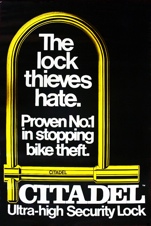 This D-shaped type of lock, sometimes referred to as a shackle lock, was developed by bicycle mechanic Stanley Kaplan and put into production by 1971. It was marketed under the trade name 'Kryptonite Lock' by KBL Corporation, Mike Zane's company. Their improved range of bike locks (and locks for other markets too) are in production to this day although the company was acquired in 2001 by Ingersoll-Rand.
This D-shaped type of lock, sometimes referred to as a shackle lock, was developed by bicycle mechanic Stanley Kaplan and put into production by 1971. It was marketed under the trade name 'Kryptonite Lock' by KBL Corporation, Mike Zane's company. Their improved range of bike locks (and locks for other markets too) are in production to this day although the company was acquired in 2001 by Ingersoll-Rand.
In 1981 the bicycle lock I selected for my Austro-Daimler was made by <ahref="javascript:popup('.. bosendorfer="" graphics="" citadel_lock_poster480719.jpg','480','719')"="">CITADEL</ahref="javascript:popup('..>. This lock was made by Acro-Fab Industries (later Bike Security Systems) at 177 Tosca Dr., Stoughton, MA 02072. Citadel competed with locks made by Krytonite, but is no longer in this business while Kryptonite went on to dominate this market. The lock is made of anodized hardened steel U-shaped bar of either seven (7) or twelve (12) inch length and with a steel cross bar; mine has the 7 inch deep U. The Citadel lock was so durable that it could resist bolt cutters up to 42 inch, or a rod saw attack for up to 15 minutes; almost anything a typical bike thief might throw at it. The Citadel lock cross bar incorporates a cylindrical key cylinder, so it is unlikely an amateur could pick the lock. The lock included two keys, with their numbers code (to cut a replacement key) engraved on the key handle.
The Citadel locks (as are most of this type) are provided with a metal bracket that bolts onto the bike frame and can hold the lock, but this exposes the lock and its circular key cylinder to the elements and grime. The Citadel lock sold in 1980 for about 29.95andwasaccompaniedbyaninsurancepolicyagainstlossofaprotectedbicycle.AsIrecallthepolicyof1980coveredupto29.95 and was accompanied by an insurance policy against loss of a protected bicycle. As I recall the policy of 1980 covered up to 29.95andwasaccompaniedbyaninsurancepolicyagainstlossofaprotectedbicycle.AsIrecallthepolicyof1980coveredupto350 loss (up from $150 in 1977) - not enough to reimburse the cost of losing my Austro-Daimler however reassuring nonetheless.
I do not recall exactly why I selected the Citadel over Kryptonite; it may have been the gold anodizing caught my eye or that might have been the only brand sold at the time when I purchased the bicycle at College Park Bicycles. Reviews I have read since indicate the Citadel remains among the best constructed and more tamper resistant D style bicycle locks. And so as I see how clean my 26 year old Citadel lock remained over the decades, and how it works effortlessly with the two keys, I again appreciate the choice of the Lock Sock.
Another item that dates my Vent-Noir II is the “Lock Sock”, a lock holder made of a durable synthetic. The Lock Sock appealed to me as a way of protecting my Citadel lock while also providing a convenient space to store folded documents or other small items. This is attached to the Top Tube by a Velco flap and is suspended just forward of the Seat Post. A smaller flap near the bottom of the Lock Sock is strapped to the Seat Tube to reduce lateral sway of the loaded Lock Sock. This accessory was made to fit the then recently introduced high security D-shaped metal bicycle frame locks. Being made of fabric and keeping the lock away from the frame the Lock Sock, even with the lock stored within it, never scarred the frame of my bicycle.
I am not sure who made this Lock Sock but around 1980 Sojourn Designs of Boulder, Colorado (marketed as “Velocipac Fox") was among the few companies that made frame bags that fit between the top, seat and downtubes. They may have offered this accessory.
Right: close up of author's bicycle showing Lock Sock strapped onto the frame (70,772 bytes).
Click on image to see enlarged view (207,521 bytes).
In the days before compact CO2 inflators bikes were equipped with an air pump that was usually attached to the frame. In hindsight I realize a mistake was made in choosing a pump that compressed in length to span from the bottom bracket up to a metal slit ring bracket clamped around the Seat Tube. The length of the pump necessitated placing the clip so that it damaged the “TI Reynolds 531” decal. But more about that later.
The bike survived the years and environments well because it was stored covered in a garage, and needed only occasionally washed and lubricated. It is free of rust even in the area of the Bottom Bracket. Over time my only concerns have involved wear and tear issues to the bike decals, the minor scuffing of the original Avocet seat and of the Almarc handlebar leather coverings. It also remained on my mind that my bike was not “All Euro” but it was instead a mishmash of European and Japanese components dictated by my original budget.
Since seeing him in 1981 Larry Black had become quite successful at making many people happy so that he opened a second store Mt. Airy Bikes in Maryland. In April 1997 I purchased a Giant Cadex CF-1 carbon fiber bike, again from Larry Black at Mt. Airy Bikes. This is a very comfortable frame and is outfitted with 'Rock Shock' titanium suspension fork system and other components that are better suited for riding primitive trails. So I retired my Austro-Daimler from day to day use. By 2006 I treated the Cadex to some technology upgrades including top line Shimano Deore XT components. By the Summer and Fall of 2006 I tried to build what I thought would be my dream road bike, this was to have been based on the Colnago C-50 carbon fiber frame also with first rate components, and all weighing in at under 15 lbs. But this effort crashed and burned so badly that I wrote an article about the experience My Colnago Misadventure: A C-50 FLR Bicycle Frame Nightmare; let's call this my attempt at catharsis after that episode. In 2007 a new distributor took over for Colnago in the USA and in April 2007 I again placed an order for the C-50 FLR with a promised delivery in a matter of weeks, but months later with no C-50 FLR in sight I cancelled that order.
Making This Vent Noir II My Vent Noir
After the Colnago C-50 FLR experience I decided to revisit the Austro-Daimler to see if I could make it more like what I wish it had been when I bought it. The bike company had such a long history, and the Vent Noir II was so distinctive and classy that I decided to have it overhauled and upgraded while attempting to employ the best components that would have been found in the early 1980's. So after something more than 25 years, in October 2006 my Vent Noir II was again in the capable hands of the man who sold it to me. I explained to Larry my primary concerns and hopes for the Vent Noir II:
1. Maintain the elegance while upgrading the components to something that is even more appealing to my senses.
2. The components would be appropriate to the time when this bike was made, representative of the state of the art in the early 1980's.
3. Replace the inner tubes and tires.
4. Recondition the leather covers on the handlebar.
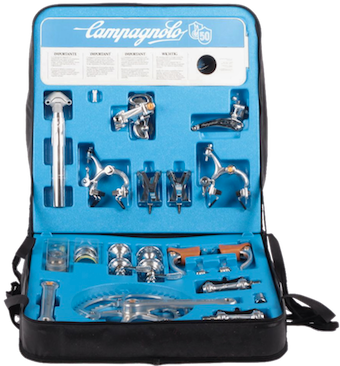 The only components Gruppo that could be equal to the beauty of a Vent Noir II frame is the “Campagnolo 50th Anniversary Group” (Gruppo del Cinquantenario) introduced in 1983 to honor the fiftieth anniversary of the company's founding. This was announced as a limited serialized edition of 15,000 planned cased sets of hardware based on Campagnolo's then current top of the line 'Super Record', with some 'Nuovo Record' and 'Cobalto' components. The components in the set feature a unique commemorative design engraved on several of the components, and each set bears its own Serial Number. Set No. 00001 was retained by Campagnolo while set No. 00002 was presented to Pope John Paul II on 15 June 1983.
The only components Gruppo that could be equal to the beauty of a Vent Noir II frame is the “Campagnolo 50th Anniversary Group” (Gruppo del Cinquantenario) introduced in 1983 to honor the fiftieth anniversary of the company's founding. This was announced as a limited serialized edition of 15,000 planned cased sets of hardware based on Campagnolo's then current top of the line 'Super Record', with some 'Nuovo Record' and 'Cobalto' components. The components in the set feature a unique commemorative design engraved on several of the components, and each set bears its own Serial Number. Set No. 00001 was retained by Campagnolo while set No. 00002 was presented to Pope John Paul II on 15 June 1983.
Right: complete Campagnolo 50th Anniversary Gruppo in the provided presentation case. Note the brakes and shifting cables set are stored at top, behind the Campagnolo placard (308,350 bytes).
Click on image to see enlarged view (664,685 bytes).
The 50th gruppo is easily distinguished by the presence of a number of gold-plated disc accents on the crank dust caps, pedal dust caps, brake caliper and lever pivots, and on the lower Derailleur pivot. The faces of each crank arm are machined and polished flat (instead of the normally fluted grooves on standard production models), and the outer face of each bears a precision engraved signature of Tullio Campagnolo. The set was completed at the factory when the provided case was closed and its zipper pulls were bound together by a fabric loop, and that loop was joined with a crimped Perfra seal stamped with the Campagnolo logo and name.
A complete 50th Anniversary set is accompanied by a packing list card bearing the set Serial Number and describing the choices of components included in that set. The set also includes: serialized Registration Card and documents, Brake Calipers, Brake Levers with Gum Rubber Hood, Front Derailleur (clip-on or braze-on), Rear Derailleur, Shifters, Cables, Seat Post (25, 26.6, 26.8, or 27.2mm diameter) with 8mm Seat Binder Bolt, Headset (British, French, or Italian threading), Front and Rear Wheel Hubs (either to accommodate 36 spokes or to fit 32) with quick release Skewers, Bottom Bracket (British, French, or Italian threading), Crankset (length of either 170, 172.5, or 175mm) with gold plated Crank Arm Dust Covers, Crank Arm Dust Cover Pin Tool, Front Derailleur Changer (either a braze-on or a clip-on), Pedals, Pedal Toe Clips (medium or large) with leather straps, hard shell fitted Case with fabric cover. An optional Campagnolo 50th Anniversary Freewheel was also available but sold separately.
Between the Summer of 2006 into early 2007 I found it was not difficult to find a complete Campagnolo 50th Anniversary set for sale. These were often unused sets for sale by vintage bicycle specialty shops, and at on line sales sites including eBay. Then these were selling for about 2,000andthatwasseveraltimestheoriginaltypical2,000 and that was several times the original typical 2,000andthatwasseveraltimestheoriginaltypical650 price of the early 1980s. I found an incomplete but attractive 50th Anniversary Set (No. 3576) being offered for sale, this included most of the critical components and with: 53-49 tooth Chain Rings, 170mm long Crank Arms, and with two 36-spoke hubs. This 50th Anniversary set was represented as having come from a display model bicycle, but lacking some components and the original case. On 27 June I purchased these components, then delivered them to Larry Black for installation on my bicycle. Larry offered to source the components missing from that 50th Anniversary set. The images below are of the components that were included in this set, and that were installed onto my Vent Noir II:
Campagnolo 50th Anniversary Gruppo: elegance of materials craftsmanship, tasteful and timeless beauty.
Above: several of the core components included with the Campagnolo 50th Anniversary Group now installed on the authors Austro-Daimler,
and the Poster artwork issued by Campagnolo to commemorate the 50th Anniversary event.
Seeing the beauty of the used Campagnolo 50th Anniversary components that arrived peaked my curiosity, and left me reconsidering whether or not I should simply buy a complete new old stock 50th Anniversary set. I rejoined the hunt and soon found a complete 50th Anniversary set for sale. Early in July I acquired that complete like-new 50th Anniversary cased set (No. 18xx) that includes the correct Bottom Bracket in British Threading (1.370 inch x 24 TPI) for the Austro-Daimler frame. But soon after it arrived I developed some sense of guilt at the thought of having purchased a like new, never used set and then essentially violating it by installing it onto a bike to ride casually. I also wondered why should I pay premium dollars for a set in the custom fitted carrying case, registration card, etc. when a used set would do the same thing and show similar wear soon after the first rides? So I stored the complete cased 50th Anniversary set, for what or when I still do not know, yet cannot bring myself to part with it.
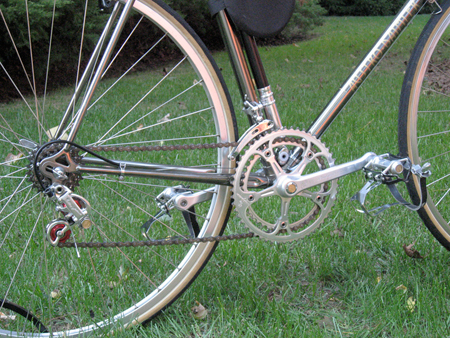 But as much as I thought I knew about bicycle components and hardware I still had several lessons yet to learn. As mentioned previously, some of the critical components that would have been provided with a complete set were not included with the 50th Anniversary Group set that I purchased for the installation on my Austro-Daimler bicycle. Also, some components that were included with the set I bought on eBay were incompatible with each other or with the Austro-Daimler Frame. For instance, the Campagnolo gum rubber grips that cover each Brake Lever tend to rot over the years, and as the seller explained these would need to be replaced; finding these in good condition while possible is not cheap. The Bottom Bracket set that I found in fact had mismatched parts and could not be put together as provided by the seller; more about this later. So Caveat Emptor! remains good advice.
But as much as I thought I knew about bicycle components and hardware I still had several lessons yet to learn. As mentioned previously, some of the critical components that would have been provided with a complete set were not included with the 50th Anniversary Group set that I purchased for the installation on my Austro-Daimler bicycle. Also, some components that were included with the set I bought on eBay were incompatible with each other or with the Austro-Daimler Frame. For instance, the Campagnolo gum rubber grips that cover each Brake Lever tend to rot over the years, and as the seller explained these would need to be replaced; finding these in good condition while possible is not cheap. The Bottom Bracket set that I found in fact had mismatched parts and could not be put together as provided by the seller; more about this later. So Caveat Emptor! remains good advice.
Right: Campagnolo 50th Anniversary Group components on my Austro-Daimler Pretty Metal! (194,945 bytes)
The bike is shown in Sept. 2007 with it's original Regina 50 Extra ORO chain, I later upgraded to Regina 50 “Record” ORO as explained below.
Click on image to see enlarged view (429,532 bytes).
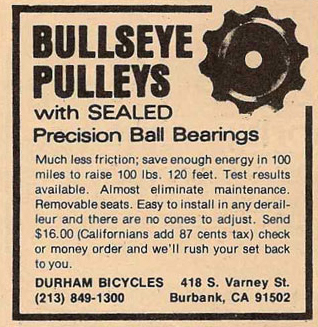 The rear Derailleur of this demo 50th Anniversary set came equipped with distinctive upgrade ten-tooth pulleys anodized in red. After some research I determined were the 'BULLSEYE' brand sealed bearing guide and tension Pulleys. The Bullseye products were developed by Roger Durham, a motorcycle and bicycle enthusiast who started formed “Durham Bicycles” in Burbank, California. An avid cyclist and bicycle club member, by 1972 Roger introduced the first of his own brand of innovative components for BMX and road bicycles. By 1973 their product line included the Bullseye pulleys, a pair of machined aluminum low friction pulleys. These pulleys were among the first incorporating sealed precision ball bearings, a distinct improvement over those provided then by Campagnolo or Shimano.
The rear Derailleur of this demo 50th Anniversary set came equipped with distinctive upgrade ten-tooth pulleys anodized in red. After some research I determined were the 'BULLSEYE' brand sealed bearing guide and tension Pulleys. The Bullseye products were developed by Roger Durham, a motorcycle and bicycle enthusiast who started formed “Durham Bicycles” in Burbank, California. An avid cyclist and bicycle club member, by 1972 Roger introduced the first of his own brand of innovative components for BMX and road bicycles. By 1973 their product line included the Bullseye pulleys, a pair of machined aluminum low friction pulleys. These pulleys were among the first incorporating sealed precision ball bearings, a distinct improvement over those provided then by Campagnolo or Shimano.
Left: Durham Bicycles advertisement for Bullseye Pulleys (194,945 bytes)
After I learned about the origins of the Bullseye pulleys I realized that with these components made in the USA I was wandering from my stated goal of the 'All Euro' bike - but who would know. Since Bullseye pulleys were sold in many anodized colors I considered toning down the appearance while preserving the improvements by switching from red to gold for example, or in time I may simply install period Campagnolo black Pulleys (0013/03).
But back to “The Project”. Larry Black suggested that since I am changing the Wheel Hubs from Shimano to the Campy 50th we might as well upgrade the Wheel Rims and Spokes also to something that would be the equal of the Campy Hubs. I considered using the lightweight Fiamme Ergal polished 7075 aluminum 700c tubular racing rims (averaging 296 g each), as were provided with the top line Ultima models of the period, but these lightweight rims are more at home on competitive circuits than on the roads and trails I frequent. So I selected to ride on patented Weinmann A129 “Super” Concave 36 spoke 700c (622mm) clincher Wheel Rims, each with the Presta valve. These Weinmann rims were made at their Alesa S.A. subsidiary in Schoten-Antwerp Belgium, and are generally regarded as excellent in manufacturing precision and finish, durable and hard wearing. These are made of natural aluminum alloy, seam welded then hard anodized and incorporate single nickel brass eyelets to accommodate the spokes. These are 16mm wide interior and 22mm wide exterior (overall), and with a nice concave groove to their inner radius so they accommodate tires of 28mm to 32mm wide. Their Effective Rim Diameter is 619mm, this is the wheel rim diameter measured at the nipple seats in the spoke holes plus the thickness of the two nipple heads. The ERD is needed for calculating the correct spoke length. The rims weigh 580 grams each. They bear low profile engravings on the inner radius (remember the days before labels were plastered everywhere?): “WEINMANN PATENT” and “MADE IN BELGIUM 700C”, with no stick-on label or decals. Well regarded among those in the know and recommended for my restoration/upgrade by Larry Black, if Weinmann were not so common a name in rims provided with many bicycles of this era then they might command even more respect than they do. Finding these in good condition proved to be the most time consuming aspect of the project, delaying the final reassembly of the bike until June 2007.
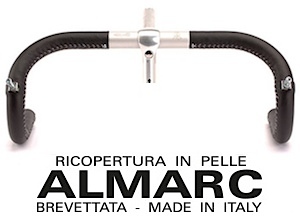 The original Almarc stitched-on black leather covers of the handlebars were essentially in very good condition, with only some mild scuffing at the sides. While this project was underway (2006-2007) I considered simply having the original Almarc leather covers replaced. However, Almarc had long ago ceased operation and no new old stock were available - though later I learned it would not be as simple as it appears to fit and install if I had found a set. Since I could find no other company in the bike world that was then making such a fine and leather cover as these, I decided to leave this original and distinctive aspect of the bicycle in place. Fortunately, most of the scruff marks on the leather could be made to disappear with a little leather conditioning cream; to maintain them I periodically apply Brooks brand Leather Conditioning Cream. Even after all these years this leather covering still feels great, does not slip, and show no signs of wearing out. No matter how much I considered spending for the state of the art composite bar and alternative coverings, I find nothing that rivals the elegance and comfort of this bar and cover set.
The original Almarc stitched-on black leather covers of the handlebars were essentially in very good condition, with only some mild scuffing at the sides. While this project was underway (2006-2007) I considered simply having the original Almarc leather covers replaced. However, Almarc had long ago ceased operation and no new old stock were available - though later I learned it would not be as simple as it appears to fit and install if I had found a set. Since I could find no other company in the bike world that was then making such a fine and leather cover as these, I decided to leave this original and distinctive aspect of the bicycle in place. Fortunately, most of the scruff marks on the leather could be made to disappear with a little leather conditioning cream; to maintain them I periodically apply Brooks brand Leather Conditioning Cream. Even after all these years this leather covering still feels great, does not slip, and show no signs of wearing out. No matter how much I considered spending for the state of the art composite bar and alternative coverings, I find nothing that rivals the elegance and comfort of this bar and cover set.
Almarc is Back! Almarc had ceased operation for some years until 2013 when they resumed production, still being made just north of Milan in Verano Brianza, Italy. The founder Roberto Lissoni was persuaded to bring the line back, and they are using the same tools and techniques as when he and his brother originally founded the company in 1975. They have since increased the choices of color (common colors as well as custom colors are available) for their patented handlebar covers, and they offer arrangements to suit various styles of handlebars. You can send your handlebar them and they will install their Nuova Almarc leather cover of your choice, or you can order a complete new handlebar with the cover installed. Furthermore, they have added stiched leather covered saddles to their offerings.
 The last touch on this visit to Mt. Airy Bikes was to buy a Tool Pouch to replace the old now tattered and rusted Schwinn pouch that I'd had since buying a Schwinn Le Tour 10 speed bicycle the early 1970's. This would be a just about the same size, a traditional leather model made by hand at the historic Brooks company in the United Kingdom. This Brooks 'Challenge' model (shown at left) is 7 inch wide x 3 inch tall x 2 inch deep, of complete black leather construction with a leather fastening strap. Since the Brooks is an exact replica of an early 1900's Brooks design, it suits one of my goals of keeping the Austro-Daimler and its components appearing appropriate to its time and origins.
The last touch on this visit to Mt. Airy Bikes was to buy a Tool Pouch to replace the old now tattered and rusted Schwinn pouch that I'd had since buying a Schwinn Le Tour 10 speed bicycle the early 1970's. This would be a just about the same size, a traditional leather model made by hand at the historic Brooks company in the United Kingdom. This Brooks 'Challenge' model (shown at left) is 7 inch wide x 3 inch tall x 2 inch deep, of complete black leather construction with a leather fastening strap. Since the Brooks is an exact replica of an early 1900's Brooks design, it suits one of my goals of keeping the Austro-Daimler and its components appearing appropriate to its time and origins.
The Brooks pouch attaches onto loops built into most Brooks Saddles, but I simply wrap the provided leather straps around the Saddle Mounting rails. This is not the easiest thing to do, then adjust balance so that the pouch rests horizontal instead of tilted. But the end result shows it was worth the cost and effort to do this.
- 50th Anniversary Cables, Toe Clips: The Campagnolo 50th Anniversary Group demo set I bought was missing the Cables for the Brake and Derailleurs. This set was also missing the Toe Clips that attach to the furnished Pedals. Other items (Brake and Downtube Clamp with Derailleur Cable Guide, etc.) were used from the original installation or sourced as we progressed. But Larry Black had most of what we needed of that vintage on hand and he provided black leather Toe Clip straps by Cinelli, these appear to be of better quality and appearance than the original Campagnolo straps.
There were still some last items that I was determined to find in order to make the bike a true complete 50th Anniversary Group. And minor add ons just to make me feel better. I found the other missing parts could with some perseverance be acquired, often these would be “New Old Stock” still sitting about unused in someone's inventory with some components advertised as used but often arriving appearing as new:
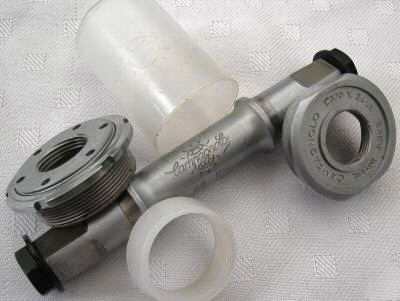
- 50th Anniversary Bottom Bracket: The demo 50th Anniversary set that I acquired did include a Bottom Bracket but that was threaded to fit the Italian pattern and therefore incompatible with my Vent Noir II frame. So there I went again, negotiating to find a compatible 50th Anniversary Bottom Bracket and with the correct British threading (1.370 in x 24 TPI). When I did buy what was represented to be correct Bottom Bracket set for sale on eBay, what arrived was a set whose Bearings were mismatched to the Spindle!
While there have been many different machining standards for Bottom Brackets made over the past decades, the shell of recent production road bike frames are usually 68mm wide. The better Campagnolo sets of this era incorporate cup-and-cone bearings within cups that thread onto the frame Bottom Bracket Shell; one bearing cup is fixed while the other is adjustable. The Spindle (or Axle) is installed through a rifled opening (a contaminant minimizing feature of Nuovo Record and Super Record models) of each load bearing cup. Near either end of the Spindle are shoulders that ride upon the bearings cups that allow the Spindle to revolve freely. This assembly is housed in a Dust Sleeve with a tapered End Cone press fitted over it to reduce contamination from water and dirt, this is especially helpful if the set is installed within a cutout shell of the Bottom Bracket. The Crank Arm is attached onto either end of the Spindle, and a Pedal is installed onto each Crank Arm.
Right: 50th Anniversary Nuovo Record Bottom Bracket set I purchased including the Spindle, adjustable and fixed Cups housing the Bearings, Dust Sleeve and End Cone (38,002 bytes).
Spindles are available for road (Strada) or track (Pista), and are sized to fit not only the shell width but also the Chainwheel arrangement it will support; a longer spindle will be called for to accommodate a triple Chainwheel, or shorter for single. Spindles made for road bikes are usually between 102 to 120mm wide. The overall side to side spacing between the pedal attachment points at the ends of the crank arms are termed the Q Factor or Tread, narrower being the preferred arrangement for road touring or for racing.
There have been many Campagnolo Spindles made, those made through the era of when my bicycle was made are poorly identified by their markings. To determine what set you have requires either great experience, or a caliper and Campagnolo specifications tables to cross-check the part by comparing: 1. the measure of the spacing between shoulders, 2. the lengths from either tip to the shoulders, and 3. the finish (gray or shiny silver). I do understand why Campy did not simply engrave a part number on each component to facilitate sorting them out?

Left: Serie Strada hollow Spindles - Super Record above a Nuovo Record. Each is 115mm long overall and for a 68mm shell, but their bearings flange spacings differ (159,849 bytes).
Studying Campagnolo literature revealed the shiny silver Spindle is a New Style (since 1977) Super Record PN 4032 68SS with 52mm shoulder spacing, and the gray Spindle is a New Style Nuovo Record PN 744/A 68SS with 49mm shoulder spacing. The flanges spaced 50mm apart accommodate thicker bearings cups while those made for the thinner bearings cups were 54mm apart.
Larry Black confirmed that the Bottom Bracket set that I acquired had a mismatched Spindle and cups: the seller provided Super Record Bearings but with the 50th Anniversary Group “Nuovo Record” Spindle. This glitch was a nuisance since I could not complete or ride the bicycle until this could be sorted out, but Larry solved that by providing the proper arrangement. I wondered if I might have been better off to simply pay the extra to acquire a complete Campagnolo 50th Anniversary set, but in some ways the hunt for the parts needed to complete my 50th demo set was more educational, entertaining, and the costs were notably less than what it cost to buy a complete boxed set. My choice to source the components separately also allowed me to retain my first complete unused Campagnolo 50th Anniversary cased set intact. - 50th Anniversary Poster: During my scavenging and just for the fun of it, I also bought a rather good looking Campagnolo 50th Anniversary 39 x 27 inch poster (shown above with the other Campy 50th components) in the event that I ever own a home with too much open wall space.
On my own I found the last upgrade bits that made the bike what is is today:
- Saddle:
In a last minute attempt to upgrade the appearance from the pretty badly worn original Avocet Saddle (seat) I purchased a new state of the art lightweight Carbon Fiber Saddle. The new saddle just did not look right on a bicycle of this class and vintage. And frankly, that new Saddle was no where near as comfortable as the old worn and scuffed Avocet saddle that I had on this bicycle when the entire upgrade process began late in 2006. So again I monitored eBay until I found and acquired a Cinelli “UNICANITOR”, a matt black Buffalo leather covered Saddle. This Saddle arrived new in the bag, just as these were sold from the 1970's to the early 1980's. The Cinelli name in bold capital letters is embossed in yellow across the back of the black leather seat, while the UNICANITOR is on the sides. This Saddle went nicely with the date of my bike, and it blends nicely with the Almarc black leather covered Cinelli Handlebar and Stem.
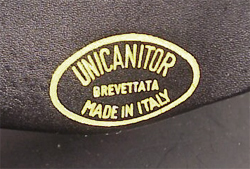
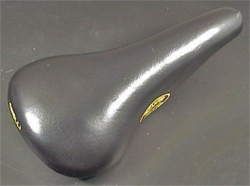
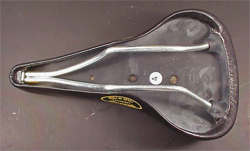
There are several interesting aspects of this vintage Saddle. For one, it is a hell of a lot more comfortable to ride than most of the modern, arguably overpriced newer production Saddles. Cinelli made four (4) versions of the Unicanitor Saddle, and quite by accident I may have acquired the best one for me since this is their Model 4; this indicates it is provided with extra padding from the factory. - Reynolds Ltd. '531' Frame Decals:
This Austro-Daimler frame was assembled in Austria with Reynolds 531 double-butted tubing.
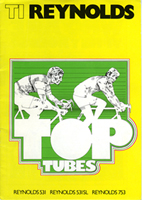 These tube sets were provided with decals that were applied by the bicycle frame preparer after the frame was joined together and painted (or in this case chromed). The decals indicate the material and their origin: “TI” (Tubes Investments Reynolds Ltd - after 1977) is the version of the Reynolds 531s tubing sticker on my Austro-Daimler and the set consists of a rectangular decal on the downtube with 531 in green at a 45-degree angle, and triangular decals with 'REYNOLDS 531 FORK' on both sides of the fork tines.
These tube sets were provided with decals that were applied by the bicycle frame preparer after the frame was joined together and painted (or in this case chromed). The decals indicate the material and their origin: “TI” (Tubes Investments Reynolds Ltd - after 1977) is the version of the Reynolds 531s tubing sticker on my Austro-Daimler and the set consists of a rectangular decal on the downtube with 531 in green at a 45-degree angle, and triangular decals with 'REYNOLDS 531 FORK' on both sides of the fork tines.
The original decals have taken some wear and tear. And so in order to truly complete the restoration of my Vent Noir II I was able to locate sources for all the decals. Some are represented to be original, unused (New Old Stock), while some are excellent reproductions.
I was able to locate the set of three exact Reynolds 531 TI decals on eBay from seller “gts753” (gtsoftley@ozemail.com.au), his eBay Store is “Cyclomondo”. He is a specialist source for decals and other labels who supplies restoration shops and will also sell directly. He offers an incredible selection of decals for almost every bike make, for almost every type of metal, and choices of other decals that are appropriate to the time period. For example, he offered so many Reynolds 531 decal sets that I had to take pictures of mine and compare these against his catalog on eBay. The transaction of buying the decals from him went smoothly and quickly, and at a moderate cost including shipping from Australia. He was also very helpful and quick to answer E-Mail when I had any questions. His decals look very good, and are often very close to the originals so that most people would not notice the differences - and they would certainly be better than having nothing on the frame.
However, as was pointed out to me by Mr. Gillies in 2009, the replacement set do differ in several ways from the original:
I have yet to go through the effort of removing replacing the original decals since after thinking about it I decided these are in good enough condition to remain. - Austro-Daimler Decals:
The bicycle frame has decals applied that explain the Make and Model of the bike, as well as its origin.
The 'Made in Austria' decal is wrapped around the front of the Seat Tube (parallel to the Frame Pump). This decal has the worst damage since the original Zefal Frame Pump that I bought is provided with a metal clamp that marred the fragile decal. Fortunately there is a source for these decals, CyclArt, Inc., 2590 A Pioneer Avenue, Vista, CA 92081-8427. Their telephone: 760-599-1015, and E-Mail info@cyclart.com. But there is a hitch with this as Susan Cunningham informed me they use their decal stock primarily after they have repaired and or repainted bike frames, they do not routinely sell decals alone and without inspecting the bicycle on which it is to be applied out of several justifiable concerns. /info@cyclart.com
And so my pursuit of replacing all the remaining decals pretty much came to a halt when I decided the originals are overall in good condition. And I did not think it justified the risks involved with shipping “Old Faithful” to California. I will go ahead and accept their offer to sell to me the 'Made in Austria' decals soon. - Frame Pump:
I was aggravated to come to the understanding that in my youthful ignorance in 1981 the Zefal Frame Pump metal clamp had marred the 'Made in Austria' decal. And on the opposite side of this is the yellow 'College Park Bicycles' decal which was likewise marred by the clamp, though not too badly. So I was determined to either dispense with the Frame Pump or come to an alternative solution that would compliment the class of this bike.
After some research I learned about the 'Impero' frame pumps made by 'Silca s.r.l.' in Italy. Felice Sacchi founded the Silca company in 1917, and even through the turmoils of two World Wars the company survived and has prospered. Currently Claudio Sacchi, the grandson of Felice continues a tradition that retains for Silca the title of oldest company in the cycling industry to be continuously operated by a single family. This sense of history gave Silca another edge up against alternatives in my quest for something that would be interesting, beautiful and traditional installed on my Austro-Daimler. The Silca 'Impero' model features a mounting arrangement where spring tension holds it in place standing in front of the Seat Tube (between the Top and downtubes); the model was made in various lengths to suit the numerous frame geometries. It can be installed under the Top Tube as well.
To my surprise on eBay I was able to find one in brand new condition, still in its box and sealed wrapper. I bid and won this for a price that seemed less than what I might have paid for it in the 1980's. It is the perfect solution, elegant in appearance and perfect in function as you may have noted in the pictures of the bike at the top of this article. It just so happens the 'Lock Sock' has a Velcro fastener that wraps around the Seat Tube and the Frame Pump and this provides additional reassurance that the Silca Pump will not slip off and disappear while I am riding.
But I should confess, that my days of using a Frame Pump are behind me and I now carry a CO2 cartridge based tire tube inflator in the 'Brooks' black leather Saddle Pouch. Anyway, why would anyone wish to violate the sanctity of a new Silca Impero? - Regina 50 “Record” ORO Bicycle Chain:
While I was at it I decided to upgrade another component: the chain. The original Regina 50 Extra ORO chain glowed gold when it was new, but over time it had darkened. As I explored the possibility of replacing the original chain to restore that appearance, I learned that from the 1970s to 1980s Regina had made an upgrade Regina 50 “Record” ORO model chain that had a similar gold tone finish as that of my original Regina 50 Extra ORO chain. The ½ inch long chain links are each factory drilled to lighten them but without substantially reducing their strength, this reduces the weight by about six (6) percent from the 415 grams of my original chain. This is a ½ x 3/32 inch wide chain provided as a set of 116 links (390 g weight) when new in the box. I came upon a complete 'new old stock' (NOS) set still in its original box and installed it:

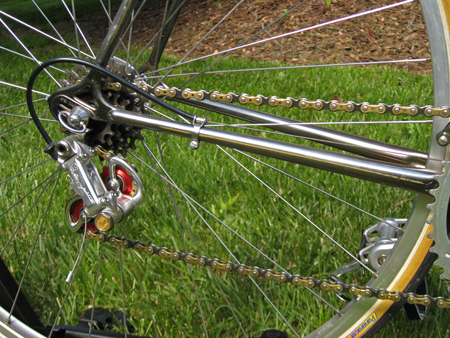
Above: Boxed Regina 50 “Record” ORO Bicycle Chain (90,862 bytes), and as installed with Campagnolo 50th Anniversary Group rear Derailleur (184,081 bytes)
Click on images to see enlarged views (left 177,833 and right 521,132 bytes).
I will have to see how many links are used after the new chain replaced the original to be sure, but the original Regina Extra 50 Oro chain listed a weight of 415 grams so I may have shaved off as much as 25 grams by upgrading to the Record chain, while adding a little bit more panache. Watch out Lance Armstrong - my bicycle, now at about 23 lbs, is fast closing in on your 15 lb. bikes. Austro-Daimler Font While restoring my Austo-Daimler I came to learn some facts that were helpful to know. The 'Vent Noir' font style is “Auriol”, this is is a registered trademark of Linotype-Hell AG and/or its subsidiaries. Georges Auriol designed this display typeface in 1901 for the Parisian type foundry Deberny & Peignot. Auriol has a stylized stencil/brush look that reflects the Art Nouveau period. Most notable about Auriol is the unusual winged 'M', the large capitals, the short ascenders and descenders, and the white gaps appearing in the middle of some letter strokes. Use Auriol for display settings evocative of turn-of-the-century design and style. The Auriol font and Auriol Flowers was the basis for the lettering used by Hector Guimard for the entrance signs to the Paris Metro. It was re-released by Deberny & Peignot in 1979 with a new bold face, designed by Matthew Carter.

 Austro-Daimler Vent Noir II Brochures
Austro-Daimler Vent Noir II Brochures
The Internet continues to evolve and bring the world closer than ever, among the benefits are all the resources that helped me to not only find the rare parts to make my Vent Noir II what it is today, but also literature. Here are Austro-Daimler brochures scanned by Manfred Fratzl, and a TI Reynolds booklet scanned by the host of this site:
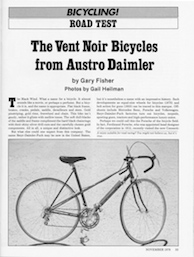 The Vent Noir Bicycles from Austro Daimler 3 page Nov. 1976 article by Gary Fisher, photos by Gail Heilman (7.5 Mb). ©Bicycling Magazine, all rights reserved, hosted by permission.
The Vent Noir Bicycles from Austro Daimler 3 page Nov. 1976 article by Gary Fisher, photos by Gail Heilman (7.5 Mb). ©Bicycling Magazine, all rights reserved, hosted by permission.
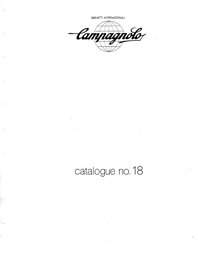 c. 1981 Campangolo Catalog No. 18
c. 1981 Campangolo Catalog No. 18
72 page catalog describes all Gruppos and components (2.9 Mb)
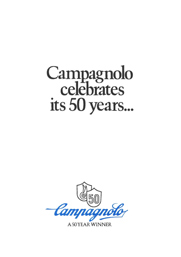 1983 Campagnolo 50th Anniversary Gruppo Color illustrated 6 page brochure (1.6 Mb)
1983 Campagnolo 50th Anniversary Gruppo Color illustrated 6 page brochure (1.6 Mb)
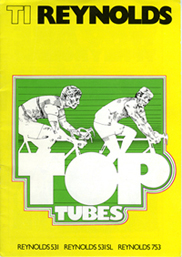 TI Reynolds 1978 16 page booklet describing the company history, tubes production, and decals (1.0 Mb)
TI Reynolds 1978 16 page booklet describing the company history, tubes production, and decals (1.0 Mb)
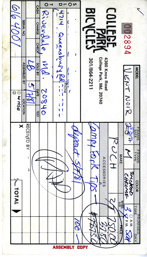 College Park Bicycles sale receipt of my Vent Noir II bicycle, dated 7 May 1981 (237,258 bytes)
College Park Bicycles sale receipt of my Vent Noir II bicycle, dated 7 May 1981 (237,258 bytes)
Postscript
Last year (2006) I began my quest to build the state of the art high technology bike. That drove me to consider the most modern and esoteric bike frames and components made and this culminated in the abortive effort to persuade Colnago of Italy to make a C-50 frame that would meet all my expectations. As I conveyed in My Colnago Misadventure: A C-50 FLR Bicycle Frame Nightmare:
“one nice aspect of being an amateur pursuing this for my own riding experience and for my interest in the technology is that this would be my Über Bike; the state-of-the-art, ultra lightweight demonstration of the best performance technology of 2006 - and all without having to comply with competitive weight minimums.”
And:
“even as I researched the best technology for 2006 it seemed that my state-of-the-art bike would become obsolete within weeks. I read for example that Campagnolo would soon introduce an improved line of “Record” series components...I read about electronically controlled Derailleurs that were already showing up on the racing scene and nearing the consumer market. And I wondered how long before I would find myself again wanting to upgrade my old “state of the art” mechanical components to keep my bike where I wanted it to be - in the forefront of bike tech.”
I find it ironic and somewhat enlightening how over time I came to realize the bike that appealed to my sense of beauty and high tech was sitting in my garage all those years, just awaiting its Renaissance. This Vent Noir II revives my satisfaction and my appreciation of materials and traditions of craftsmanship from days gone by. This effort has been a complete technical success too and the truth is told during the ride: it has shed some weight, the shifting is quicker and more precise, the ride is much quieter, and the Cinelli seat is more comfortable. An elegant machine; this Vent Noir II is compliant, rides smoothly and in near silence, and in all its years it has never let me down.
And yes, it was worth the twenty six years wait and effort to get it right!
I thank those who have contributed information and images for this article including F. Manfred. Contact the author of this site.
Contents © 2007-2024, M. Cohen and respective contributors. All Rights Reserved
